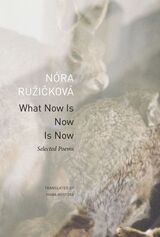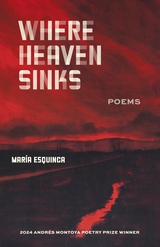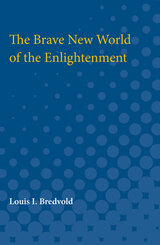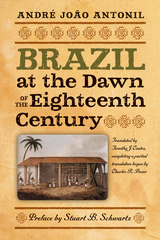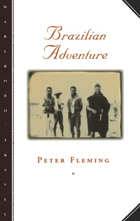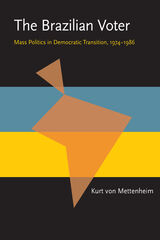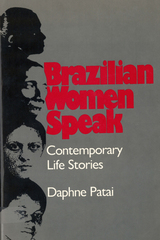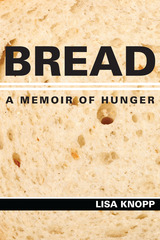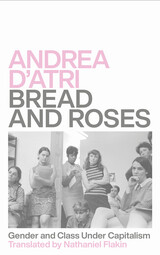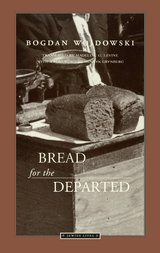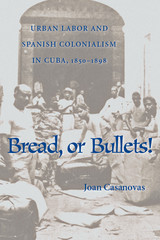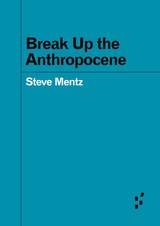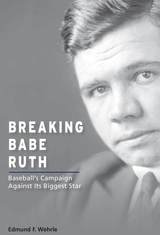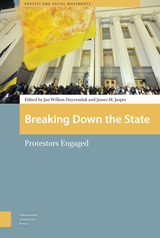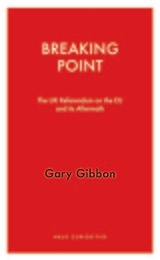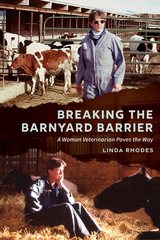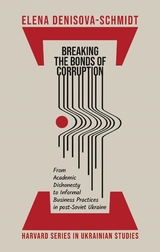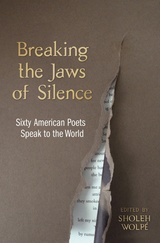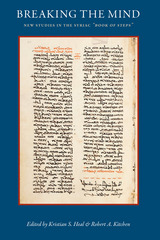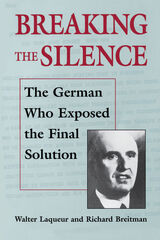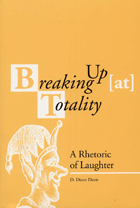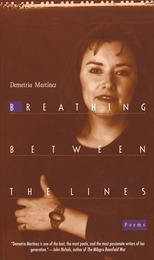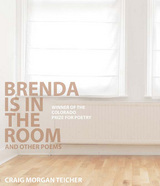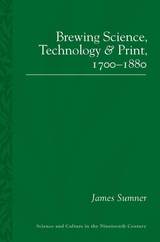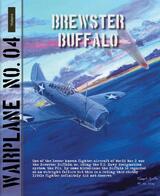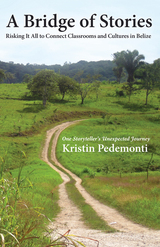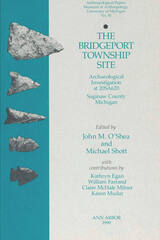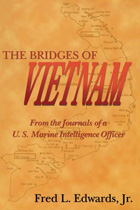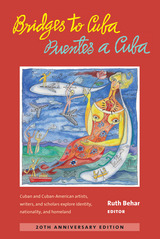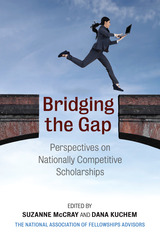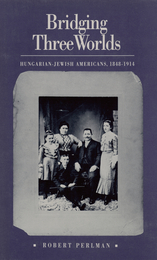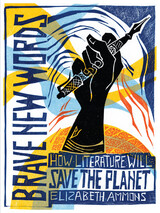 Brave New Words: How Literature Will Save the Planet
Ammons, Elizabeth
University of Iowa Press, 2010 The activist tradition in American literature has long testified to the power of words to change people and the power of people to change the world, yet in recent years many professional humanists have chosen to distract themselves with a postmodern fundamentalism of indeterminacy and instability rather than engage with social and political issues. Throughout her bold and provocative call to action, Elizabeth Ammons argues that the responsibility now facing humanists is urgent: inside and outside academic settings, they need to revive the liberal arts as a progressive cultural force that offers workable ideas and inspiration in the real-world struggle to achieve social and environmental justice.
Brave New Words challenges present and future literary scholars and teachers to look beyond mere literary critique toward the concrete issue of social change and how to achieve it. Calling for a profound realignment of thought and spirit in the service of positive social change, Ammons argues for the continued importance of multiculturalism in the twenty-first century despite attacks on the concept from both right and left. Concentrating on activist U.S. writers—from ecocritics to feminists to those dedicated to exposing race and class biases, from Jim Wallis and Cornel West to Winona LaDuke and Paula Moya and many others—she calls for all humanists to link their work to the progressive literature of the last half century, to insist on activism in the service of positive change as part of their mission, and to teach the power of hope and action to their students.
As Ammons clearly demonstrates, much of American literature was written to expose injustice and motivate readers to work for social transformation. She challenges today’s academic humanists to address the issues of hope and purpose by creating a practical activist pedagogy that gives students the knowledge to connect their theoretical learning to the outside world. By relying on the transformative power of literature and replacing nihilism and powerlessness with conviction and faith, the liberal arts can offer practical, useful inspiration to everyone seeking to create a better world.
 Brave new world: Imperial and democratic nation-building in Britain between the wars
Volume editor Laura Beers and Geraint Thomas
University of London Press, 2012 After the First World War, Britain faced a number of challenges as it sought to adapt to domestic conditions of mass democracy while maintaining its position in the empire in the face of national independence movements. As politicians at home and abroad sought to legitimize their position, new efforts were made to conceptualize nationality and citizenship, with attempts to engage the public using mass media and greater emphasis on governing in the public interest. Brave New World reappraises the domestic and imperial history of Britain in the inter-war period, investigating how 'nation building' was given renewed impetus by the upheavals of the First World War. The essays in this collection address how new technologies and approaches to governance were used to forge new national identities both at home and in the empire, covering a wide range of issues from the representation of empire on film to the convergence of politics and 'star culture'. The book is an invaluable resource for scholars of British social, political and imperial history, as well as being of interest to the general reader.
The Brave New World of the Enlightenment
Louis I. Bredvold
University of Michigan Press, 1961 The Brave New World of the Enlightenment is a brilliant introduction to the thought of those centuries, illuminating with a rare intelligence the ideas that brought forth the Enlightenment and the ensuing confusion of our age. In a sustained and incisive critique the distinguished scholar Louis I. Bredvold distills and expounds the thought of Descartes, Spinoza, Leibniz, Locke, Condillac, Hartley, Helvetius, Diderot, and Rousseau, revealing revolutions unprecedented in the history of man. And in so doing he shows the limitations of rationalism, bringing into clear focus the dangers of our lingering inheritance. For, he says, quoting Reinhold Niebuhr, "No cumulation of contradictory evidence seems to disturb modern man's good opinion of himself."
 The Bravest Pets of Gotham: Tales of Four-Legged Firefighters of Old New York
Peggy Gavan
Rutgers University Press, 2024 In the late 1800s and early 1900s, the New York Fire Department permitted firemen to keep one dog, one cat, or singing birds in their firehouse. Since the firemen were required to live and work at the firehouse full-time, these animal mascots—along with the horses that pulled the fire trucks—were their constant companions, making a dangerous workplace feel more like home.
The Bravest Pets of Gotham takes readers on a fun historical tour of Old New York, sharing touching and comical stories about the bond between FDNY firefighters and their four-legged or feathered friends. The book contains more than one hundred astonishing, emotional, and sometimes hilariously absurd tales of the FDNY animal mascots whose extraordinary intelligence, acts of bravery, and funny antics deserve to be remembered. Some anecdotes depict fire companies that broke the one-pet rule and welcomed a veritable menagerie of animals into their firehouses, including goats, turtles, and even monkeys. Whether you are an animal lover, a history buff, or a fan of firefighting, The Bravest Pets of Gotham is full of stories that will thrill and amuse you.
 Braxton Bragg and Confederate Defeat V. II
Judith Lee Hallock
University of Alabama Press, 2009 The second volume in a two-part examination of one of the Confederacy's most controversial and unsuccessful military commanders
In the summer of 1863, Confederate General Braxton Bragg was commander of the Army of Tennessee., still reeling from its defeat in January at Murfreesboro, Tennessee. Failing to establish a strong defensive position at either Tullahoma or Chattanooga, Bragg saw the heartland of the South gradually slip away from him. Victory at Chickamauga Creek in September—Bragg’s last military success—was followed by disaster at Missionary Ridge and, shortly thereafter, his removal from army command.
Within three months, however, President Jefferson Davis had restored Bragg to active military involvement, naming him military adviser for the Confederacy. Here, finally, Bragg’s skills as an administrator and organizer bore fruit—as did his penchant for provoking quarrels and disunity within the military establishment. Reassigned to field command in late 1864, Bragg concluded his army service with defeats at Wilmington and Bentonville, North Carolina. The prevailing view of Bragg’s is a false one. Rather, he was a valuable asset to the Confederacy, a talented organizer whose gifts were misused by the nation he served. For the first time, Bragg’s tenure in Richmond is examined carefully and evaluated. Contrary to the common view that Bragg was nothing more than a sycophant to President Davis, this study shows that he and Davis often disagreed on policy. Much of Bragg’s present reputation among civil war scholars is based upon how contemporaries viewed him. Despite Bragg’s determined devotion to the Confederacy, his frailties have shaped the literature to such an extent that his real accomplishments have been distorted or ignored. In this study the author has tried, as General Joseph E. Johnston once advised, to “have a little charity for Bragg.”
Judith Lee Hallock draws a balanced picture of Bragg and of his important role in the Confederacy beginning in 1863. Her volume continues and completes the biography of Bragg published in Volume I by Grady McWhiney in 1969. Along with the military details, the author provides a full accounting of Bragg’s fractious relationships with other members of the military, a critical factor in this period for the entire Confederate command. This sympathetic biography of Bragg gives valuable insight into the workings of the Confederacy in the last two years of its struggle for independence.
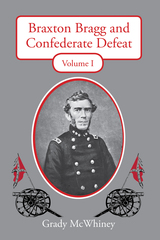 Braxton Bragg and Confederate Defeat: Volume 1
Grady McWhiney
University of Alabama Press, 1991 Born in 1817 in North Carolina, Bragg ranked high in the graduating class of 1837 at West Point. He served with distinction in both the Seminole War and the Mexican War. Just prior to the outbreak of the Civil War, Bragg was promoted to major general. In June 1862 Bragg was named Commander of the Army of Tennessee, the principal Confederate force in the West, and was described by Secretary of War Judah P. Benjamin as “the greatest General.”
Yet less than two years later Bragg was the South’s most discredited commander. Much of this criticism was justified, for he had done as much as any Confederate general to lose the war. Under his direction the army fought four major campaigns before retreating from Kentucky through Tennessee to Georgia. The army’s failures were Bragg’s failures, and after his defeat at Chattanooga in November 1863 Bragg was relieved of field command. Instead of retirement to the obscurity most people believed he so richly deserved, Bragg received a remarkable promotion: he went to Richmond as President Davis’s military adviser.
McWhiney intended this work – first published in 1969 – to be the first of two volumes covering the life of the Confederacy’s most problematic general. This reprint edition is issued along with Braxton Bragg and Confederate Defeat, Volume II by Judith Lee Hallock. McWhiney’s work carries Bragg through the defeat at Murfreesboro in January 1863, and Hallock’s book continues through the staff appointment in Richmond and Bragg’s final days as a private citizen.
 Brazil and South Korea: Economic Crisis and Restructuring
Edited by Edmund Amann and Ha-Joon Chang
University of London Press, 2003 The 1990s saw lower- and middle-income countries throughout the world come under pressure to open their domestic markets to international trade and investment. Despite the progressive implementation of market-friendly policies, many emerging market countries experienced financial market volatility, exchange rate collapse, and slumps in output. These problems profoundly affected two of the world's largest middle-income industrialized countries - Brazil and South Korea. Despite superficial similarities, prior to the onset of crisis both countries had very different models of industrialization and had adopted contrasting approaches to trade and market reform. This collection analyzes the factors underlying the economic crises in South Korea and Brazil, pointing out areas of similarity and divergence. It also reviews the paths of recovery taken by both economies, examining the role of policy and variations in structural characteristics.
Contributors include Andre Averburg (United Nations Development Programme/ Banco Nacional de Desenvolvimento Economico e Social, Brazil), Fabio Giambiagi (Banco Nacional de Desenvolvimento Economico e Social), Andrea Goldstein (OECD Development Centre), Louise Haagh (Department of Politics, University of York, USA), Tat Yan Kong (School of Oriental and African Studies, University of London, UK), Jose Ricardo Ramalho (Federal University of Rio de Janeiro, Brazil), Ben Ross Schneider (Center for International and Comparative Studies, Northwestern University, USA), and Jaang-Sup Shin (Department of Economics, National University of Singapore).
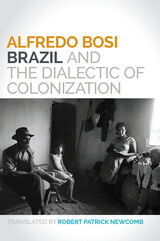 Brazil and the Dialectic of Colonization
Alfredo Bosi
University of Illinois Press, 2015 A classic of Brazilian literary criticism and historiography, Brazil and the Dialectic of Colonization explores the unique character of Brazil from its colonial beginnings to its emergence as a modern nation. This translation presents the thought of Alfredo Bosi, one of contemporary Brazil's leading intellectuals, to an English-speaking audience. Portugal extracted wealth from its Brazilian colony. Slaves--first indigenous peoples, later Africans--mined its ore and cut its sugarcane. From the customs of the colonists and the aspirations of the enslaved rose Brazil. Bosi scrutinizes signal points in the creation of Brazilian culture--the plays and poetry, the sermons of missionaries and Jesuit priests, the Indian novels of José de Alencar and the Voices of Africa of poet Castro Alves. His portrait of the country's response to the pressures of colonial conformity offers a groundbreaking appraisal of Brazilian culture as it emerged from the tensions between imposed colonial control and the African and Amerindian cults--including the Catholic-influenced ones--that resisted it.
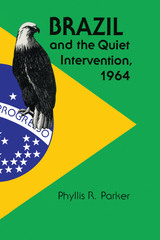 Brazil and the Quiet Intervention, 1964
By Phyllis R. Parker
University of Texas Press, 1979 When the Brazilian military overthrew President João Goulart in 1964, American diplomats characterized the coup as a "100 percent Brazilian movement." It has since become apparent, largely through government documents declassified during the course of research for this book, that the United States had an invisible but pervasive part in the coup. Relying principally on documents from the Johnson and Kennedy presidential libraries, Phyllis Parker unravels the events of the coup in fascinating detail. The evidence she presents is corroborated by interviews with key participants. U.S. interference in the Goulart regime began when normal diplomatic pressure failed to produce the desired enthusiasm from him for the Alliance of Progress. Political and economic manipulations also proving ineffective, the United States stood ready to back a military takeover of Brazil's constitutional democracy. U.S. operation "Brother Sam" involved shipments of petroleum, a naval task force, and tons of arms and ammunition in preparation for intervention during the 1964 coup. When the Brazilian military gained control without calling on the ready assistance, U.S. policy makers immediately accorded recognition to the new government and set in motion plans for economic support.
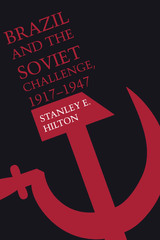 Brazil and the Soviet Challenge, 1917–1947
By Stanley E. Hilton
University of Texas Press, 1991 Between 1918 and 1961, Brazil and the USSR maintained formal diplomatic ties for only thirty-one months, at the end of World War II. Yet, despite the official distance, the USSR is the only external actor whose behavior, real or imagined, influenced the structure of the Brazilian state in the twentieth century. In Brazil and the Soviet Challenge, 1917–1947, Stanley Hilton provides the first analysis in any language of Brazilian policy toward the Soviet Union during this period. Drawing on American, British, and German diplomatic archives and unprecedented access to official and private Brazilian records, Hilton elucidates the connection between the Brazilian elite’s perception of a communist threat and the creation of the authoritarian Estado Novo (1937–1945), the forerunner of the post-1964 national security state. He shows how the 1935 communist revolt, prepared by Comintern agents, was a pivotal event in Brazilian history, making prophets of conservative alarmists and generating irresistible pressure for an authoritarian government to contain the Soviet threat. He details the Brazilian government’s secret cooperation with the Gestapo during the 1930s and its concomitant efforts to forge an anti-Soviet front in the Southern Cone. And he uncovers an unexplored aspect of Brazil’s national security policy, namely, the attempt to build counterintelligence capabilities not only within Brazil but also in neighboring countries. While the history of the Brazilian communist movement has been extensively studied, this is the first work to explore how images of the Soviet Union and its policies influenced the Brazilian foreign policy elite. It will be important reading for all students of twentieth-century political history.
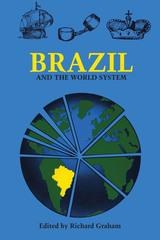 Brazil and the World System
Edited and with an introduction by Richard Graham; with chapters by Fernando A. Novais, John R. Hall, and Luís Carlos Soares
University of Texas Press, 1991 Has the world economy shaped and defined Brazil’s economic and political history and, if so, to what extent? Is Brazil’s past to be explained principally by its insertion in a single world capitalist system? The authors of the three essays in this volume reflect critically on these questions along with the following: Should the determining factors be understood as sociological-cultural (as in a heritage of patrimonial rule) or were they based on material reality? What was the connection between the presence of slavery in the Americas and the emergence of capitalism in Europe? What accounts for Brazil’s centuries-long reliance on exports and the slow development of its industry? The chapters in this book draw contrasting judgments on virtually every major issue in Brazilian history because they begin from divergent premises. In arguing their cause, noted scholars John R. Hall, Fernando A. Novais, and Luís Carlos Soares provide a formidable intellectual point and counterpoint whose theoretical assumptions bear heavily on all social scientists engaged in exploring colonialism, imperialism, capitalism, dependency, and relative international poverty. Brazil and the World System provides provocative insights not only about Brazil but also about the nature of colonialism in general and its relationship to the rise of capitalism in Europe. It should appeal to Latin Americanists of all disciplinary persuasions as well as to general readers curious about great patterns of change in history. Stuart Schwartz, director of the Center for Early Modern History at the University of Minnesota, says, “ . . . an excellent collection . . . North American scholarship will find these essays an eye-opener.
Brazil at the Dawn of the Eighteenth Century
André João Antonil
Tagus Press, 2012 First published in 1711, Brazil at the Dawn of the Eighteenth Century describes the four major economic activities of the Brazilian colony. Half the book is devoted to the sugar industry and the social world of those who grew the sugarcane. Other sections give a detailed view of the tobacco industry. Further, this work describes where and how gold was extracted, the new and old routes connecting Minas Gerais with the coast, and the rough-and-tumble world of the miners. Antonil concludes with discussion of the economic importance of cattle, and information on Brazilian exports and taxes. No other work provides this level of eyewitness detail.
 The Brazil Chronicles
Stephen G. Bloom
University of Missouri Press, 2024 Winner of the 2025 AEJMC-Knudson Latin America Prize
As a young journalist at the Brazil Herald from 1979-81, Stephen G. Bloom spent his early professional years working in Rio’s seedy Lapa district, surrounded by fugitives, drug runners, pornographers, and stealth CIA agents. Bloom shares the wild story of this English-language newspaper in The Brazil Chronicles. The expat newspaper was a breeding ground for a different kind of storyteller — audacious risk-takers who told madcap tales of Amazon plantations, Confederate emigres, and lost Indian tribes. Several renown journalists cut their teeth at the Brazil Herald, including acclaimed New York Times correspondent Tad Szulc, Huffington Post CEO Eric Hippeau, and an untamed Gonzo reporter by the name of Hunter S. Thompson.
Drawing from extensive archival research and more than 150 interviews with his former colleagues, Bloom’s eye-opening narrative dive is both entertaining and academically rigorous. With a backdrop of coups, nonstop political instability, censorship, hyper-inflation, and weekends at sultry Ipanema Beach, The Brazil Chronicles doubles as a coming-of-age memoir, following young Bloom as he embarks on his quest to become a foreign correspondent, relocating to a foreign country to pursue under-the-radar stories and tall tales. His firsthand experience provides an insider, eye-witness account of the newspaper’s colorful history, transporting the reader to its sweltering newsroom and delving into the multifarious lives of its eclectic, trailblazing, polyglot staff.
Even as Bloom weaves between personal narrative, history, and accounts from journalism luminaries, it’s clear who the book’s main character is: the one-of-a-kind newspaper itself.
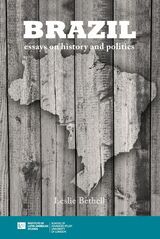 Brazil: Essays on History and Politics
Leslie Bethell
University of London Press, 2018 Published to mark his 80th birthday, this volume consists of seven essays by Leslie Bethell on major themes in modern Brazilian history and politics: Brazil and Latin America; Britain and Brazil (1808-1914); The Paraguayan War (1864-70); The decline and fall of slavery (1850-1888); The long road to democracy; Populism; The failure of the Left. The essays are new, but they draw on book chapters and journal articles published (mainly in Portuguese) and public lectures delivered in the ten years since his retirement as founding Director of the University of Oxford Centre for Brazilian Studies in 2007. In an autobiographical Introduction (Why Brazil?) Professor Bethell describes how, from the most unlikely of backgrounds, he became a historian of Brazil and how he came to devote much of his long academic career to the promotion and development of Brazilian studies in UK (and, to a lesser extent, US) universities. Leslie Bethell is one of the few great Brazilianists, as foreign scholars of Brazil are called, of his and subsequent generations. Brazilianists engage in scholarship that has breadth and depth; illuminate Brazil as an object of study, asking the most important questions that can be asked about the country; and give voice to Brazilian experiences and perspectives. Leslie Bethell has done these things during his long career, and he continues to do so, as this collection of his recent essays on Brazilian history and politics demonstrates. Anthony Pereira, Director, Brazil Institute, King’s College London
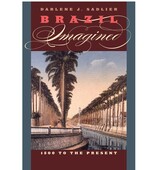 Brazil Imagined: 1500 to the Present
By Darlene J. Sadlier
University of Texas Press, 2008 The first comprehensive cultural history of Brazil to be written in English, Brazil Imagined: 1500 to the Present captures the role of the artistic imaginary in shaping Brazil's national identity. Analyzing representations of Brazil throughout the world, this ambitious survey demonstrates the ways in which life in one of the world's largest nations has been conceived and revised in visual arts, literature, film, and a variety of other media. Beginning with the first explorations of Brazil by the Portuguese, Darlene J. Sadlier incorporates extensive source material, including paintings, historiographies, letters, poetry, novels, architecture, and mass media to trace the nation's shifting sense of its own history. Topics include the oscillating themes of Edenic and cannibal encounters, Dutch representations of Brazil, regal constructs, the literary imaginary, Modernist utopias, "good neighbor" protocols, and filmmakers' revolutionary and dystopian images of Brazil. A magnificent panoramic study of race, imperialism, natural resources, and other themes in the Brazilian experience, this landmark work is a boon to the field.
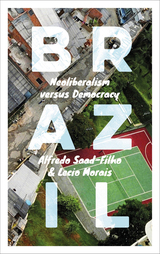 Brazil: Neoliberalism versus Democracy
Alfredo Saad-Filho and Lecio Morais
Pluto Press, 2017 With the sixth largest economy in the world, Brazil has played a key international role for decades. It was one of the first “pink wave” administrations in Latin America. In 1994, it was responsible for shutting down the US-sponsored proposal for a Free Trade Area of the Americas. Notably, it is also one of the few large countries where social spending has risen and the distribution of income has improved over the last thirty years. As we saw during the 2014 World Cup protests, however, the country still remains highly unequal, with vast unmet social welfare needs and a precarious infrastructure.
In Brazil: Neoliberalism Versus Democracy, Alfredo Saad-Filho and Lecio Morais review the complex paradox that is modern Brazil. Focusing on 1980 to the present, they analyze the tensions between the two dominant systemic political transitions from military rule to first democracy, then neoliberalism. A groundbreaking interpretation of this intricate relationship, Brazil examines how the contradictory dynamics of these transitions eventually became symbiotic as they unfolded and intertwined.
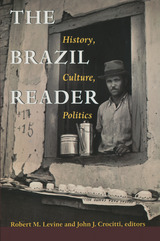 The Brazil Reader: History, Culture, Politics
Robert M. Levine and John J. Crocitti, eds.
Duke University Press, 1999 Bordering all but two of South America’s other nations and by far Latin America’s largest country, Brazil differs linguistically, historically, and culturally from Spanish America. Its indigenous peoples share the country with descendants of Portuguese conquerors and the Africans they imported to work as slaves, along with more recent immigrants from southern Europe, Japan, the Middle East, and elsewhere. Capturing the scope of this country’s rich diversity and distinction as no other book has done—with more than a hundred entries from a wealth of perspectives— The Brazil Reader offers a fascinating guide to Brazilian life, culture, and history. Complementing traditional views with fresh ones, The Brazil Reader’s historical selections range from early colonization to the present day, with sections on imperial and republican Brazil, the days of slavery, the Vargas years, and the more recent return to democracy. They include letters, photographs, interviews, legal documents, visual art, music, poetry, fiction, reminiscences, and scholarly analyses. They also include observations by ordinary residents, both urban and rural, as well as foreign visitors and experts on Brazil. Probing beneath the surface of Brazilian reality—past and present—The Reader looks at social behavior, women’s lives, architecture, literature, sexuality, popular culture, and strategies for coping with the travails of life in a country where the affluent live in walled compounds to separate themselves from the millions of Brazilians hard-pressed to find food and shelter. Contributing to a full geographic account—from the Amazon to the Northeast and the Central-South—of this country’s singular multiplicity, many pieces have been written expressly for this volume or were translated for it, having never previously been published in English. This second book in The Latin America Readers series will interest students, specialists, travelers for both business and leisure, and those desiring an in-depth introduction to Brazilian life and culture.
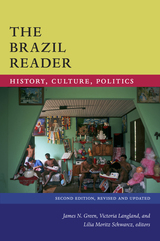 The Brazil Reader: History, Culture, Politics
James N. Green, Victoria Langland, and Lilia Moritz Schwarcz, editors
Duke University Press, 2019 From the first encounters between the Portuguese and indigenous peoples in 1500 to the current political turmoil, the history of Brazil is much more complex and dynamic than the usual representations of it as the home of Carnival, soccer, the Amazon, and samba would suggest. This extensively revised and expanded second edition of the best-selling Brazil Reader dives deep into the past and present of a country marked by its geographical vastness and cultural, ethnic, and environmental diversity. Containing over one hundred selections—many of which appear in English for the first time and which range from sermons by Jesuit missionaries and poetry to political speeches and biographical portraits of famous public figures, intellectuals, and artists—this collection presents the lived experience of Brazilians from all social and economic classes, racial backgrounds, genders, and political perspectives over the past half millennium. Whether outlining the legacy of slavery, the roles of women in Brazilian public life, or the importance of political and social movements, The Brazil Reader provides an unparalleled look at Brazil’s history, culture, and politics.
 Brazil Since 1985: Economy, Polity and Society
Edited by Maria D'Alva G. Kinzo and James Dunkerley
University of London Press, 2003 Looking into Brazil's recent experience of democracy is an arduous undertaking, given the complexities of a country of continental size and great regional contrasts, where areas of prosperity and wealth mingle with underdevelopment and poverty. This book looks at some of the important issues involved in building up a democracy and keeping it working. How should we assess Brazil's experience of democracy? To what extent has the emergence of a democratic regime improved Brazilians' social, economic, and political life? Has democracy been consolidated to the point of making a political breakdown unthinkable or improbable? These are questions that any student of Brazil has to address. The answers to them, however, are far from simple.
Contributors include Edmund Amann (School of Economic Studies, University of Manchester, UK), Maria Celi Scalon (Insituto Universitario de Pesquisas do Rio de Janeiro, Brazil), Carlos Antonio Costa Ribeiro (Universidade Federal de Minas Gerais, Brazil), Mauricio Coutinho (Universidade Estadual de Campinas, Brazil), Argelina Cheibub Figueiredo (Universidade de Sao Paulo, Brazil), James Dunkerley (Institute of Latin American Studies and Queen Mary, University of London, UK), Antonio Sergio A. Guimaraes (Universidade de Sao Paulo, Brazil), Anthony Hall (London School of Economics and Political Science, UK), Fernando Limongi (Universidade de Sao Paulo, Brazil), Fiona Macaulay (Centre for Brazilian Studies, University of Oxford and Institute of Latin American Studies, University of London, UK), Celso Martone (Universidade de Sao Paulo, Brazil), Leandro Piquet Carneiro (Universidade de Sao Paulo, Brazil), Mauro Porto (Universidade de Brasilia, Brazil), and Brasilio Sallum Jr. (Universidade de Sao Paulo, Brazil).
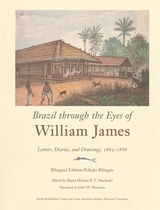 Brazil through the Eyes of William James: Letters, Diaries, and Drawings, 1865–1866, Bilingual Edition/Edição Bilíngue
Maria Helena P.T. Machado
Harvard University Press, 2006 In 1865, twenty-three-year-old William James began his studies at the Harvard Medical School. When he learned that one of his most esteemed professors, Louis Agassiz, then director of the recently established Museum of Comparative Zoology, was preparing a research expedition to Brazil, James offered his services as a voluntary collector. Over the course of a year, James kept a diary, wrote letters to his family, and sketched the plants, animals, and people he observed. During this journey, James spent time primarily in Rio de Janeiro, Belem, and Manaus, and along the rivers and tributaries of the Amazon Basin.
This volume is a critical, bilingual (English–Portuguese) edition of William James’s diaries and letters and also includes reproductions of his drawings. This original material belongs to the Houghton Archives at Harvard University and is of great interest to both William James scholars and Brazilian studies experts.
Brazilian Adventure
Peter Fleming
Northwestern University Press, 1999 "Beyond the completion of a 3,000-mile journey, mostly under amusing conditions, through a little-known part of the world, and the discovery of one new tributary to a tributary to a tributary of the Amazon, nothing of importance was achieved."
Nothing indeed. In 1932, Peter Fleming, a literary editor, traded his pen for a pistol and took off as part of the celebrated search for missing English explorer Colonel P.H. Fawcett. With meager supplies, faulty maps, and packs of rival newspapermen on their trail, Fleming and his companions marched, canoed, and hacked through 3,000 miles of wilderness and alligator-ridden rivers in search of the fate of the lost explorer. One of the great adventure stories, Brazilian Adventure is as fresh a story today as it was when originally published in 1933.
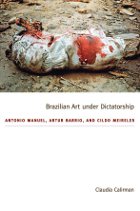 Brazilian Art under Dictatorship: Antonio Manuel, Artur Barrio, and Cildo Meireles
Claudia Calirman
Duke University Press, 2012 Brazilian Art under Dictatorship is a sophisticated analysis of the intersection of politics and the visual arts during the most repressive years of Brazil's military regime, from 1968 until 1975. Raised in Rio de Janeiro during the dictatorship, the curator and art historian Claudia Calirman describes how Brazilian visual artists addressed the political situation and opened up the local art scene to new international trends. Focusing on innovative art forms infused with a political undertone, Calirman emphasizes the desire among Brazilian artists to reconcile new modes of art making with a concern for local politics. Ephemeral works, such as performance art, media-based art, and conceptualism, were well suited to the evasion of censorship and persecution. Calirman examines the work and careers of three major artists of the period, Antonio Manuel, Artur Barrio, and Cildo Meireles. She explores the ways that they negotiated the competing demands of Brazilian politics and the international art scene, the efficacy of their political critiques, and their impact on Brazilian art and culture. Calirman suggests that the art of the late 1960s and early 1970s represented not just the artists' concerns with politics, but also their anxieties about overstepping the boundaries of artistic expression.
The Brazilian Capital Goods Industry, 1929–1964
Nathaniel H. Leff
Harvard University Press This book is a case study of industrial development in Brazil. Special attention is given to the early emergence of capital goods production and to the pattern of evolution of the industry's domestic and foreign firms. There is a detailed investigation of the supply and utilization of technically educated and skilled manpower. The treatment of the demand for capital goods in Brazil focuses on the scope of the market, its fluctuations, and particularly its rate of growth. This industry, the author shows, has been able to compete with imports without protection. Finally, the effects of domestic capital goods production on aggregate Brazilian developments are discussed.
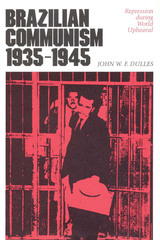 Brazilian Communism, 1935-1945: Repression during World Upheaval
By John W. F. Dulles
University of Texas Press, 1983 The Brazilian Communist Party was one of the largest Communist parties in Latin America until its split and dissolution in the 1990s. Although not granted legal status as a political party of Brazil until 1985, the Partido Comunista Brasileiro (PCB) has been tolerated by that country's regime. Such governmental tolerance of the PCB was not always the case. In the past, the regime of Getúlio Vargas practiced savage forms of repression against Brazilian leftists, whose "Red extremism" was cited by both government leaders and the press as sufficient cause for Vargas' adoption of the most extreme measures. Brazilian Communism, 1935–1945 is an objective and remarkably comprehensive account of the Brazilian Communist Party's struggle to survive those days of repression. From his prison cell, PCB leader Luís Carlos Prestes guided the Party's quarreling factions. All who were associated with the Left shared a common enemy: the police, who used the most brutal forms of torture to extract information about leftist activities. Young Elza Fernandes, companion of the PCB's secretary general, was one whom the police interrogated. Suspecting that she had betrayed them, the Party itself arranged her murder. Dulles' vivid account of this violent chapter in Latin American history is based on exclusive interviews with leading activists of the period and exhaustive research in the archives of both the PCB and the Brazilian police. The results make fascinating reading for Latin Americanists, historians of World War II, and students of international Communism alike.
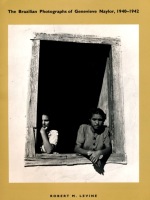 The Brazilian Photographs of Genevieve Naylor, 1940-1942
Robert M. Levine
Duke University Press, 1998 In the early 1940s as the conflict between the Axis and the Allies spread worldwide, the U.S. State Department turned its attention to Axis influence in Latin America. As head of the Office of Inter-American Affairs, Nelson Rockefeller was charged with cultivating the region’s support for the Allies while portraying Brazil and its neighbors as dependable wartime partners. Genevieve Naylor, a photojournalist previously employed by the Associated Press and the WPA, was sent to Brazil in 1940 by Rockefeller’s agency to provide photographs that would support its need for propaganda. Often balking at her mundane assignments, an independent-minded Naylor produced something far different and far more rich—a stunning collection of over a thousand photographs that document a rarely seen period in Brazilian history. Accompanied by analysis from Robert M. Levine, this selection of Naylor’s photographs offers a unique view of everyday life during one of modern Brazil’s least-examined decades. Working under the constraints of the Vargas dictatorship, the instructions of her employers, and a chronic shortage of film and photographic equipment, Naylor took advantage of the freedom granted her as an employee of the U.S. government. Traveling beyond the fashionable neighborhoods of Rio de Janeiro, she conveys in her work the excitement of an outside observer for whom all is fresh and new—along with a sensibility schooled in depression-era documentary photography of Dorothea Lange and Walker Evans, as well as the work of Cartier-Bresson and filmmaker Serge Eisenstein. Her subjects include the very rich and the very poor, black Carnival dancers, fishermen, rural peasants from the interior, workers crammed into trolleys—ordinary Brazilians in their own setting—rather than simply Brazilian symbols of progress as required by the dictatorship or a population viewed as exotic Latins for the consumption of North American travelers. With Levine’s text providing details of Naylor’s life, perspectives on her photographs as social documents, and background on Brazil’s wartime relationship with the United States, this volume, illustrated with more than one hundred of Naylor’s Brazilian photographs will interest scholars of Brazilian culture and history, photojournalists and students of photography, and all readers seeking a broader perspective on Latin American culture during World War II. Genevieve Naylor began her career as a photojournalist with Time, Fortune, and the Associated Press before being sent to Brazil. In 1943, upon her return, she became only the second woman to be the subject of a one-woman show at New York’s Museum of Modern Art. She served as Eleanor Roosevelt’s personal photographer and, in the 1950s and 1960s became well known for her work in Harper’s Bazaar, primarily as a fashion photographer and portraitist. She died in 1989.
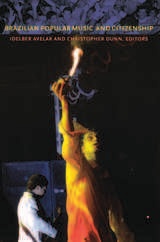 Brazilian Popular Music and Citizenship
Idelber Avelar and Christopher Dunn, eds.
Duke University Press, 2011 Covering more than one hundred years of history, this multidisciplinary collection of essays explores the vital connections between popular music and citizenship in Brazil. While popular music has served as an effective resource for communities to stake claims to political, social, and cultural rights in Brazil, it has also been appropriated by the state in its efforts to manage and control a socially, racially, and geographically diverse nation. The question of citizenship has also been a recurrent theme in the work of many of Brazil’s most important musicians. These essays explore popular music in relation to national identity, social class, racial formations, community organizing, political protest, and emergent forms of distribution and consumption. Contributors examine the cultural politics of samba in the 1930s, the trajectory of middle-class musical sensibility associated with Música Popular Brasileira (MPB), rock and re-democratization in the 1980s, music and black identity in Bahia, hip hop and community organizing in São Paulo, and the repression of baile funk in Rio in the 1990s. Among other topics, they consider the use of music by the Landless Workers’ Movement, the performance of identity by Japanese Brazilian musicians, the mangue beat movement of Recife, and the emergence of new regional styles, such as lambadão and tecnobrega, that circulate outside of conventional distribution channels. Taken together, the essays reveal the important connections between citizenship, national belonging, and Brazilian popular music. Contributors. Idelber Avelar, Christopher Dunn, João Freire Filho, Goli Guerreiro, Micael Herschmann, Ari Lima, Aaron Lorenz, Shanna Lorenz, Angélica Madeira, Malcolm K. McNee, Frederick Moehn, Flávio Oliveira, Adalberto Paranhos, Derek Pardue, Marco Aurélio Paz Tella, Osmundo Pinho, Carlos Sandroni, Daniel Sharp, Hermano Vianna, Wivian Weller
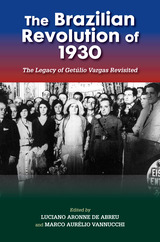 The Brazilian Revolution of 1930: The Legacy of Getúlio Vargas Revisited
Marco Aurélio Vannucchi
Sussex Academic Press, 2022 The third of October 2020 marked the 90th anniversary of the Brazilian Revolution of 1930. Although this event is recognized in Brazilian historiography as an important landmark in the construction of contemporary Brazil, debate, discourse, and indeed publications commemorating the event have been much less numerous and profound than would be expected. Comparisons have been made with what took place in 1980, the year of the revolution's fiftieth anniversary, where meaningful historical judgements were made across a wide spectrum of society and the political establishment. It is pertinent to ask why there is no longer the appetite for substantive discussion on the Vargas period. Perhaps it is due to the new political climate in Brazil in the last decade, especially with regard to various projects aimed at labour and trade union reform, the main legacies of the revolutionary period which today are considered by many as obstacles to the modernization of the labour market and the country's economic development. Given the economic imperatives and aims of the 1930 Revolution, a re-evaluation of the Vargas Period will assist in better understanding the contemporary economic issues that face Brazil today. The exercise is neither one of nostalgia or exaltation of this past period, but rather to offer a (positive and negative) overview of Vargas' legacy and the vast historiography that surrounds it. Scholars, politicians, business, and the Brazilian workforce need to learn from past economic choices in order to better understand the challenges that contemporary Brazil faces. Recently proposed reforms have strong overtones to the revolutionary agenda of the 1930s, namely the forging of a 'New Brazil' and the necessity of avoiding political schism. This book examines the political, economic, labour, cultural, military, and gender ramifications that will guide debate.
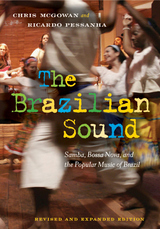 The Brazilian Sound: Samba, Bossa Nova, and the Popular Music of Brazil
Chris McGowan
Temple University Press, 2008 Here is an illustrated guide to the rich music of Brazil—its history, styles, performers, instruments, and impact on musicians around the globe. From the boisterous rhythms of samba to the cool elegance of bossa nova to the hot percussion of Bahian axé music, The Brazilian Sound celebrates a world music phenomenon. This revised and expanded edition includes discussions of developments in samba and other key genres, the rise of female singer-songwriters in recent years, new works by established artists like Milton Nascimento and Marisa Monte, and the mixing of bossa with electronica. This clearly written and lavishly illustrated encyclopedic survey features new entries and photographs, an extensive glossary of Brazilian music terms and more.
This edition of The Brazilian Sound contains new discussions of:
· música sertaneja and música caipira
· Brazilian funk, rap/hip-hop, and electronic dance music
· important new samba and MPB artists
· Plus! An updated bibliography and glossary, and a list of Web resources
The Brazilian Voter: Mass Politics in Democratic Transition, 1974–1986
Kurt von Mettenheim
University of Pittsburgh Press, 1995 The dramatic transition from military to civilian rule in Brazil between 1974 and 1985 raises critical questions about voters, competitive party politics, and democracy at the end of the twentieth century.
This book argues that whereas military government stifled democratic activity, public opinion quickly revived when the military liberalized electoral politics in 1974. Voters rapidly aligned themselves with parties for and against military government, acquired new views on major issues, judged leaders by their performance and policies, and grounded their beliefs in concepts of social justice. Kurt von Mettenheim examines how Brazilian voters make choices and cast their ballots runs counter to long-held liberal theories about how democracy works.
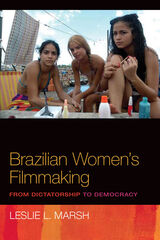 Brazilian Women's Filmmaking: From Dictatorship to Democracy
Leslie Marsh
University of Illinois Press, 2012 At most recent count, there are no fewer than forty-five women in Brazil directing or codirecting feature-length fiction or documentary films. In the early 1990s, women filmmakers in Brazil were credited for being at the forefront of the rebirth of filmmaking, or retomada, after the abolition of the state film agency and subsequent standstill of film production. Despite their numbers and success, films by Brazilian women directors are generally absent from discussions of Latin American film and published scholarly works. Filling this void, Brazilian Women's Filmmaking focuses on women's film production in Brazil from the mid-1970s to the current era. Leslie L. Marsh explains how women's filmmaking contributed to the reformulation of sexual, cultural, and political citizenship during Brazil's fight for the return and expansion of civil rights during the 1970s and 1980s and the recent questioning of the quality of democracy in the 1990s and 2000s. She interprets key films by Ana Carolina and Tizuka Yamasaki, documentaries with social themes, and independent videos supported by archival research and extensive interviews with Brazilian women filmmakers. Despite changes in production contexts, recent Brazilian women's films have furthered feminist debates regarding citizenship while raising concerns about the quality of the emergent democracy. Brazilian Women's Filmmaking offers a unique view of how women's audiovisual production has intersected with the reconfigurations of gender and female sexuality put forth by the women's movements in Brazil and continuing demands for greater social, cultural, and political inclusion.
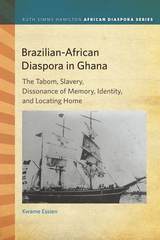 Brazilian-African Diaspora in Ghana: The Tabom, Slavery, Dissonance of Memory, Identity, and Locating Home
Kwame Essien
Michigan State University Press, 2016 Brazilian-African Diaspora in Ghana is a fresh approach, challenging both pre-existing and established notions of the African Diaspora by engaging new regions, conceptualizations, and articulations that move the field forward. This book examines the untold story of freed slaves from Brazil who thrived socially, culturally, and economically despite the challenges they encountered after they settled in Ghana. Kwame Essien goes beyond the one-dimensional approach that only focuses on British abolitionists’ funding of freed slaves’ resettlements in Africa. The new interpretation of reverse migrations examines the paradox of freedom in discussing how emancipated Brazilian-Africans came under threat from British colonial officials who introduced stringent land ordinances that deprived the freed Brazilian- Africans from owning land, particularly “Brazilian land.” Essien considers anew contention between the returnees and other entities that were simultaneously vying for control over social, political, commercial, and religious spaces in Accra and tackles the fluidity of memory and how it continues to shape Ghana’s history. The ongoing search for lost connections with the support of the Brazilian government—inspiring multiple generations of Tabom (offspring of the returnees) to travel across the Atlantic and back, especially in the last decade—illustrates the unending nature of the transatlantic diaspora journey and its impacts.
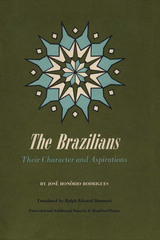 The Brazilians: Their Character and Aspirations
By José Honório Rodrigues
University of Texas Press, 1967 Brazil has long been a country in search of its own meaning and mission. Early in their history Brazilians began to puzzle over their surroundings and their relation to them. The eighteenth century produced an entire school of nativistic writers who, with the advent of independence, became fiery nationalists, still pursuing introspective studies of their homeland. Throughout the nineteenth century, the intellectuals of Brazil determined to define their nation, its character, and its aspirations. In this now well-established tradition, José Honório Rodrigues confronts the questions of who and what the Brazilian is, what Brazil stands for, where it has been, and where it is going. This study, originally published in Portuguese as Aspirações nacionais, was especially timely at a period when strong feelings of nationalism led Brazilians to seek to define their own image, and when the revolution of rising expectations disposed them to determine what goals they were seeking and how far they were on the road to achieving them. In order to understand and explain his nation, Rodrigues poses two questions: what are the national characteristics, and what are the national aspirations? Both questions are complex, but the reader will find well-reasoned answers, with a wealth of information on growth and development and abundant statistics to substantiate these answers.
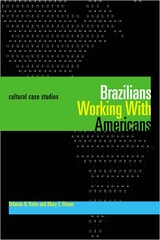 Brazilians Working With Americans/Brasileiros que trabalham com americanos: Cultural Case Studies/Estudos de casos culturais
By Orlando R. Kelm and Mary E. Risner
University of Texas Press, 2006 Doing business internationally requires understanding not only other languages, but even more so the business practices and cultures of other countries. In the case of Brazilians working with Americans, a fundamental difference for all parties to understand is that Brazilian business culture is based on developing personal relationships between business partners, while American businesspeople often prefer to get down to hard "facts and figures" quickly, with fewer personal preliminaries. Negotiating such differences is crucial to creating successful business relationships between the two countries, and this book is designed to help businesspeople do just that. Brazilians Working With Americans presents ten short case studies that effectively illustrate many of the cultural factors that come into play when North American business professionals work in Brazil. The authors summarize each case and the aspects of culture it involves, and American and Brazilian executives comment on the cultural differences highlighted by that case. A list of topics and questions for discussion also help draw out the lessons of each business situation. To make the book equally useful to Brazilians and Americans (whether businesspeople or language students), the entire text is presented in both English and Portuguese. In addition, Apple QuickTime movies of the executives' comments, which allow viewers to see and hear native speakers of both languages, are available on the Internet at www.laits.utexas.edu/orkelm/casos/intro.html.
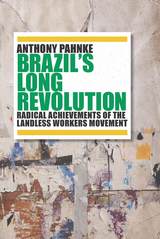 Brazil's Long Revolution: Radical Achievements of the Landless Workers Movement
Anthony Pahnke
University of Arizona Press, 2018 Economic crises in the Global North and South are forcing activists to think about alternatives. Neoliberal economic policies and austerity measures have been debated and implemented around the globe. Author Anthony Pahnke argues that activists should look to the Global South and Brazil for inspiration.
Brazil’s Long Revolution shows how the Movimento dos Trabalhadores Rurais Sem Terra (the Brazilian Landless Workers Movement, or MST) positioned itself to take advantage of challenging economic times to improve its members’ lives. Pahnke analyzes the origins and development of the movement, one of the largest and most innovative social movements currently active. Over the last three decades, the MST has mobilized more than a million Brazilians through grassroots initiatives, addressing political and economic inequalities.
The MST and its allies—together known as the Landless Movement—confront inequality by constructing democratic ways of governing economic, political, and social life in collectivized production cooperatives, movement-run schools, and decentralized agrarian reform encampments and settlements. Their strategies for organizing political, economic, and social life challenge the current neoliberal orthodoxy that privileges individualized, market-oriented practices.
Based on research conducted over five years, Pahnke’s book places the Landless Movement squarely within the tradition of Latin American revolutionary struggles, while at the same time showing the potential for similar forms of radical resistance to develop in the United States and elsewhere in the Global North.
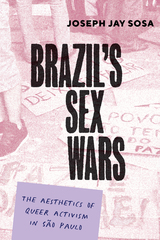 Brazil's Sex Wars: The Aesthetics of Queer Activism in São Paulo
Joseph Jay Sosa
University of Texas Press, 2024 An ethnography and media analysis of LGBT+ activism in São Paulo during Brazil’s conservative turn from 2010 to 2018. For decades, LGBT+ activists across the globe have secured victories by persuasively articulating rights to sexual autonomy. Brazilian activists, some of the world’s most energetic, have kept pace. But since 2010, a backlash has set in, as defenders of “tradition” and “family” have countered LGBT+ rights discourses using a rights-based language of their own. To understand this shifting ground, Joseph Jay Sosa collaborated with Brazilian LGBT+ activists, who use the language of rights while knowing that rights are not what they seem. Drawing on the symbolic and affective qualities of rights, activists mobilize slogans, bodies, and media to articulate an alternative democratic sensorium. Beyond conventional notions of rights as tools for managing the obligations of states vis-à-vis citizens, activists show how rights operate aesthetically—enjoining the public to see and feel as activists do. Sosa tracks the fate of LGBT+ rights in a growing authoritarian climate that demands “human rights for the right humans.” Interpreting conflicts between advocates and opponents over LGBT+ autonomy as not just an ideological struggle but an aesthetic one, Brazil’s Sex Wars rethinks a style of politics that seems both utterly familiar and counterintuitive.
 B/RDS
Béatrice Szymkowiak
University of Utah Press, 2023 B/RDS endeavors to dismantle discourses that create an artificial distinction between nature and humanity through a subversive erasure of an iconic work of natural history: John James Audubon’s Birds of America (1827-1838). This process of erasure considers the text of Birds of America as an archival cage. The author selectively erases words from the textual cage to reveal its ambiguity and the complex relationship between humanity and the other-than-human world. As the cage disappears, leaving a space for scarce, lyrical poems, birds break free, their voices inextricably entangled with ours.
Prose poems written in the author’s own words and prompted by the erasure process are also interspersed throughout the collection. These migratory poems, like ripples, trace the link between past and present and reveal the human-nature disconnect at the root cause of environmental and social problems, including the COVID-19 pandemic.
Along its five movements, B/RDS also explores how we can reimagine our relationship to environment through language within new frameworks of interconnectedness. Thus, as the collection resists the distinction between nature and culture on which traditional nature poetry relies, it also acts as an ecopoetic manifesto. It suggests that a critical, lyrical poetry could contribute to ecological awareness by singing humanity back within nature.
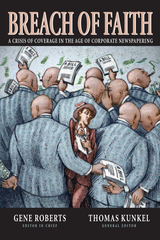 Breach of Faith: A Crisis of Coverage in the Age of Corporate Newspapering
Gene Roberts
University of Arkansas Press, 2005 What has happened to the news? Over the past decade, there has been a major shift in newspaper coverage. Many newspaper executives, paring costs and badly misreading public appetites, have cut back dramatically on all types of public-affairs reporting. Fewer reporters than ever are assigned to the statehouse or the White House, to city hall or foreign capitals. Too often celebrity gossip and movie tips take the place of serious journalism instead of existing alongside it. Newspapers once operated under a mandate to provide the kinds of news that citizens need to function in a democratic society, but many corporations have changed that mandate.
For more than two years, legendary editor Gene Roberts led a group of journalists in an unprecedented study of the newspaper industry for the American Journalism Review. This is the second volume of their findings. The first, Leaving Readers Behind: The Age of Corporate Newspapering, documented the storm of buying, selling, and consolidation that is transforming the American press. This second volume explores the consequences of these changes for ordinary communities and for the nation, arguing that they place democracy itself in peril.
Contributors include Peter Arnett, Mary Walton, Charles Layton, John Herbers, James McCartney, Carl Sessions Stepp, Lewis M. Simons, Chip Brown and Winnie Hu.
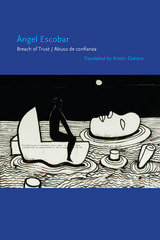 Breach of Trust/Abuso de confianza
Ángel Escobar with Translation by Kristin Dykstra
University of Alabama Press, 2016 The best-known work by acclaimed Cuban poet Ángel Escobar
Ángel Escobar’s Breach of Trust / Abuso de confianza is known by many as the most devastating book of his poetic generation. It is his first to be offered to an English-speaking audience. Merging personal and collective meditations, these twenty-three poems perform an indictment of violence. Escobar’s poetry delineates lacerations etched on bodies and minds by the sanguinary twentieth century, which unfolded out of a longer modernity spanning the Americas.
Breach of Trust / Abuso de confianza outlived its author, who took his own life in 1997. Brief and implicit appeals for justice and love offset the book’s abject theatricality. Escobar’s tragic masterpiece deftly interweaves themes into a striking synthesis offered in the spirit of survival.
Award-winning translator Kristin Dykstra introduces this collection with a comprehensive examination of Escobar’s life, work, and the times within which he wrote. Dykstra situates Escobar’s poetic abjection as his drive to confront thingification face to (non)face.
Bread: A Memoir of Hunger
Lisa Knopp
University of Missouri Press, 2025 When she was 54, Lisa Knopp’s weight dropped to a number on the scale that she hadn’t seen since seventh grade. The severe food restricting that left her thin and sick when she was 15 and 25 had returned. This time, she was determined to understand the causes of her malady and how she could heal from a condition that is caused by a tangle of genetic, biological, familial, psychological, cultural, and spiritual factors. This compelling memoir, at once a food and illness narrative, explores the forces that cause eating disorders and disordered eating, including the link between those conditions in women, middle-aged and older, and the fear of aging and ageism.
Winner of the 2017 Nebraska Book Award for Memoir
2017 Choice Outstanding Academic Title
Bread and Roses: Gender and Class Under Capitalism
Andrea D'Atri
Pluto Press, 2021 Is it possible to develop a radical socialist feminism that fights for the emancipation of women and of all humankind? This book is a journey through the history of feminism. Using the concrete struggles of women, the Marxist feminist Andrea D'Atri traces the history of the women's and workers' movement from the French Revolution to Queer Theory. She analyzes the divergent paths feminists have woven for their liberation from oppression and uncovers where they have hit dead ends. With the global working class made up of a disproportionate number of women, women are central in leading the charge for the next revolution and laying down blueprints for an alternative future. D’Atri makes a fiery plea for dismantling capitalist patriarchy.
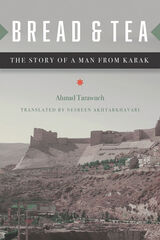 Bread and Tea: The Story of a Man from Karak
Ahmad Tarawneh
Michigan State University Press, 2017 In this post–Arab Spring novel, Ahmad Tarawneh tells the story of conflicting loyalties between two Jordanian brothers, one who serves in the Jordanian national security division, and another who belongs to an extremist militant Islamic group. With boldness, clarity, and an insider’s eye, Tarawneh addresses the root causes and circumstances that lead a desperate young Jordanian to be recruited into a terrorist organization, tempted by the lure of glory purported by a skillful, self-serving sheikh. The novel depicts the positive and negative forces that influence the two brothers in their soul-searching quests for self-actualization that lead to more questions than answers—questions many Arab youth still ask today, while engulfed in their own raging struggles over tradition, religion, modernity, and secularism. Readers find themselves on an intimate journey into the minds and hearts of the protagonists to witness the tragedy and absurdity of this conflict and the magnitude of the human destruction it leaves behind.
 Bread and Work: The Experience of Unemployment 1918-39
Matt Perry
Pluto Press, 2000 Between the world wars, unemployment spread throughout the industrialised world like a disease. In Bread and Work, Matt Perry places this global unemployment crisis in its proper international context. Focusing on Britain, Europe and the United States, he compares and contrasts popular attitudes and the government response toward unemployment.
Looking beyond statistics and economic cycles, Perry investigates the human impact of unemployment. He uncovers the experience of being jobless from the perspective of those who lived through it, their employers and their communities. He uses oral history, memoirs, literary accounts, and newspaper articles to reveal the reality of unemployment.
Perry argues that the scale of the crisis has been minimised by historians who have tended to emphasise that prolonged unemployment was the problem of the distressed fringe.
Finally, Perry argues that the lessons of the 1930s have direct relevance today since the structural problems of industrial capitalism remain inherent.
Bread for the Departed
Bogdan Wojdowski
Northwestern University Press, 1997 Bread for the Departed details the experience of the Jewish community in Warsaw between 1940 and 1942; the final chapters take place during the mass deportation of Warsaw's Jewish community to death camps. Episodic, chaotic as the teeming ghetto itself, the novel records the inexorable breakdown of morals and loyalties that accompanied the physical deterioration of the ghetto population.
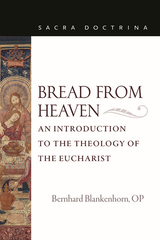 Bread from Heaven: An Introduction to the Theology of the Eucharist
Bernhard Blankenhorn
Catholic University of America Press, 2021 Bread from Heaven offers a contemporary theological synthesis on the Eucharist that brings together classical and critical biblical exegesis, debates on the early history of the Christian liturgy, patristic doctrine, the teachings offered by the Councils of Florence, Trent and Vatican II, and the Church’s lex orandi, all within a framework provided by the Eucharistic theology of Thomas Aquinas.
The volume begins with Christ’s Bread of Life discourse in John 6, in light of the Old Testament theme of the manna, and the Synoptic accounts of the Last Supper. These biblical texts offer solid foundation for a theology of Eucharistic sacrifice, presence and Communion. It then continues with a historical and systematic study of the institution of the Eucharist by Christ, with special attention given to the emergence of the first Eucharistic prayers. Then follows a survey of key Christological and ecclesiological themes which undergird Eucharistic theology. The chapters on Eucharistic sacrifice and presence form the heart of the work. Here, the focus moves to key conciliar, patristic and Thomistic insights on these themes. Bread from Heaven clarifies misunderstandings of Eucharistic sacrifice and renders transubstantiation accessible to beginners.
Blankenhorn concludes with a study of the consecration, the minister of the Eucharist and the fruits of communion. The chapter on the debate over the words of institution and the epiclesis gives a fresh perspective that integrates both eastern and western tradition. The study of the Eucharistic celebrant strikes a balance between a spirituality of the priest as acting in persona Christi and of the priest as praying in persona ecclesiae. The concluding chapter centers on the Eucharist’s unitive, mystical fruits in the Church.
This textbook is ideal for an advanced undergraduate or graduate course on Eucharistic theology. It also seeks to advance the debate on several controversial historical and speculative issues in sacramental theology.
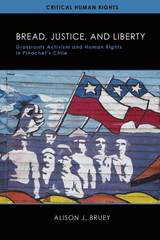 Bread, Justice, and Liberty: Grassroots Activism and Human Rights in Pinochet's Chile
Alison J. Bruey
University of Wisconsin Press, 2020 In Santiago's urban shantytowns, a searing history of poverty and Chilean state violence have prompted grassroots resistance movements among the poor and working class from the 1940s to the present. Underscoring this complex continuity, Alison J. Bruey offers a compelling history of the struggle for social justice and democracy during the Pinochet dictatorship and its aftermath.
As Bruey shows, crucial to the popular movement built in the 1970s were the activism of both men and women and the coalition forged by liberation-theology Catholics and Marxist-Left militants. These alliances made possible the mass protests of the 1980s that paved the way for Chile's return to democracy, but the changes fell short of many activists' hopes. Their grassroots demands for human rights encompassed not just an end to state terror but an embrace of economic opportunity and participatory democracy for all.
Deeply grounded by both extensive oral history interviews and archival research, Bread, Justice, and Liberty offers innovative contributions to scholarship on Chilean history, social movements, popular protest and democratization, neoliberal economics, and the Cold War in Latin America.
 Bread of Dreams: Food and Fantasy in Early Modern Europe
Piero Camporesi
University of Chicago Press, 1989 In a rich and engaging book that illuminates the lives and attitudes of peasants in preindustrial Europe, Piero Camporesi makes the unexpected and fascinating claim that these people lived in a state of almost permanent hallucination, drugged by their very hunger or by bread adulterated with hallucinogenic herbs. The use of opiate products, administered even to infants and children, was widespread and was linked to a popular mythology in which herbalists and exorcists were important cultural figures. Through a careful reconstruction of the everyday lives of peasants, beggars, and the poor, Camporesi presents a vivid and disconcerting image of early modern Europe as a vast laboratory of dreams.
"Camporesi is as much a poet as a historian. . . . His appeal is to the senses as well as to the mind. . . . Fascinating in its details and compelling in its overall message."—Vivian Nutton, Times Literary Supplement
"It is not often that an academic monograph in history is also a book to fascinate the discriminating general reader. Bread of Dreams is just that."—Kenneth McNaught, Toronto Star
"Not religion but bread was the opiate of the poor, Mr. Camporesi argues. . . . Food has always been a social and mythological construct that conditions what we vainly imagine to be matters of personal taste. Our hunger for such works should tell us that food is not only good but essential to think and to read as if our lives depended on it, which they do."—Betty Fussell, New York Times Book Review
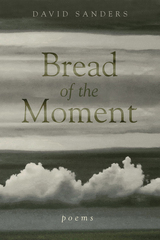 Bread of the Moment: Poems
David Sanders
Ohio University Press, 2021 A collection of poems about time, solitude, and wisdom that leads readers to hover between acceptance of and alienation from our fragility. Bread of the Moment, the follow-up to David Sanders' Compass and Clock (Swallow Press, 2016), devotes keen attention to the porous nature of the past and how the unbidden evidence of ordinary life pervades the world, provoking a spectrum of moments from which to draw meaning and find solace. These poems, characterized by a mix of free and formal verse, depict quiet days at home or in nature, as well as close calls and brushes with death: chronic illness, a house fire, a car crushed by a boulder. In this way, these poems amplify the fragility of the commonplace, a mystery from which we are, amid the noise of our everyday lives, sometimes estranged. Through this exploration, Sanders constructs a precarious balance between alienation and acceptance, striking a note at once recognizable and new.
Bread Or Bullets: Urban Labor and Spanish Colonialism in Cuba, 1850–1898
Joan Casanovas
University of Pittsburgh Press, 1998 The first thoroughly documented history of organized labor in nineteenth-century Cuba, this work focuses on how urban laborers joined together in collective action during the transition from slave to free labor and in the last decades of Spanish colonial rule in Cuba.
 Bread upon the Waters: The St. Petersburg Grain Trade and the Russian Economy, 1703-1811
Robert E. Jones
University of Pittsburgh Press, 2013 In eighteenth-century Russia, as elsewhere in Europe, bread was a dietary staple—truly grain was the staff of economic, social, and political life. Early on Tsar Peter the Great founded St. Petersburg to export goods from Russia’s vast but remote interior and by doing so to drive Russia’s growth and prosperity. But the new city also had to be fed with grain brought over great distances from those same interior provinces. In this compelling account, Robert E. Jones chronicles how the unparalleled effort put into the building of a wide infrastructure to support the provisioning of the newly created but physically isolated city of St. Petersburg profoundly affected all of Russia’s economic life and, ultimately, the historical trajectory of the Russian Empire as a whole.
Jones details the planning, engineering, and construction of extensive canal systems that efficiently connected the new capital city to grain and other resources as far away as the Urals, the Volga, and Ukraine. He then offers fresh insights to the state’s careful promotion and management of the grain trade during the long eighteenth century. He shows how the government established public granaries to combat shortages, created credit instruments to encourage risk taking by grain merchants, and encouraged the development of capital markets and private enterprise. The result was the emergence of an increasingly important cash economy along with a reliable system of provisioning the fifth largest city in Europe, with the political benefit that St. Petersburg never suffered the food riots common elsewhere in Europe.
Thanks to this well-regulated but distinctly free-market trade arrangement, the grain-fueled economy became a wellspring for national economic growth, while also providing a substantial infrastructural foundation for a modernizing Russian state. In many ways, this account reveals the foresight of both Peter I and Catherine II and their determination to steer imperial Russia’s national economy away from statist solutions and onto a path remarkably similar to that taken by Western European countries but distinctly different than that of either their Muscovite predecessors or Soviet successors.
 Bread, Wine, and Money: The Windows of the Trades at Chartres Cathedral
Jane Welch Williams
University of Chicago Press, 1993 At Chartres Cathedral, for the first time in medieval art, the lowest register of stained-glass windows depicts working artisans and merchants instead of noble and clerical donors. Jane Welch Williams challenges the prevailing view that pious town tradesmen donated these windows. In Bread, Wine, and Money, she uncovers a deep antagonism between the trades and the cathedral clergy in Chartres; the windows, she argues, portray not town tradesmen but trusted individuals that the fearful clergy had taken into the cloister as their own serfs.
Williams weaves a tight net of historical circumstances, iconographic traditions, exegetical implications, political motivations, and liturgical functions to explain the imagery in the windows of the trades. Her account of changing social relationships in thirteenth-century Chartres focuses on the bakers, tavern keepers, and money changers whose bread, wine, and money were used as means of exchange, tithing, and offering throughout medieval society. Drawing on a wide variety of original documents and scholarly work, this book makes important new contributions to our knowledge of one of the great monuments of Western culture.
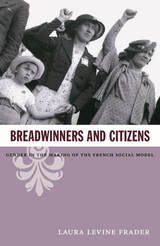 Breadwinners and Citizens: Gender in the Making of the French Social Model
Laura Levine Frader
Duke University Press, 2008 Laura Levine Frader’s synthesis of labor history and gender history brings to the fore failures in realizing the French social model of equality for all citizens. Challenging previous scholarship, she argues that the male breadwinner ideal was stronger in France in the interwar years than scholars have typically recognized, and that it had negative consequences for women’s claims to the full benefits of citizenship. She describes how ideas about masculinity, femininity, family, and work affected post–World War I reconstruction, policies designed to address France’s postwar population deficit, and efforts to redefine citizenship in the 1920s and 1930s. She demonstrates that gender divisions and the male breadwinner ideal were reaffirmed through the policies and practices of labor, management, and government. The social model that France implemented in the 1920s and 1930s incorporated fundamental social inequalities. Frader’s analysis moves between the everyday lives of ordinary working women and men and the actions of national policymakers, political parties, and political movements, including feminists, pro-natalists, and trade unionists. In the years following World War I, the many women and an increasing number of immigrant men in the labor force competed for employment and pay. Family policy was used not only to encourage reproduction but also to regulate wages and the size of the workforce. Policies to promote married women’s and immigrants’ departure from the labor force were more common when jobs were scarce, as they were during the Depression. Frader contends that gender and ethnicity exerted a powerful and unacknowledged influence on French social policy during the Depression era and for decades afterward.
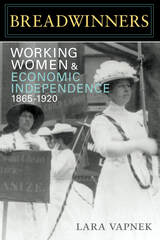 Breadwinners: Working Women and Economic Independence, 1865-1920
Lara Vapnek
University of Illinois Press, 2009 Lara Vapnek tells the story of American labor feminism from the end of the Civil War through the winning of woman suffrage. During this period, working women in the nation's industrializing cities launched a series of campaigns to gain economic equality and political power. This book shows how working women pursued equality by claiming new identities as citizens and as breadwinners. Analyzing disjunctions between middle-class and working-class women's ideas of independence, Vapnek highlights the agendas for change advanced by leaders such as Jennie Collins, Leonora O'Reilly, and Helen Campbell and organizations such as the National Consumers' League, the Women's Educational and Industrial Union, and the Women's Trade Union League. Locating households as important sites of class conflict, Breadwinners recovers the class and gender politics behind the marginalization of domestic workers from labor reform while documenting the ways in which working-class women raised their voices on their own behalf.
 Break Point: Two Minnesota Athletes and the Road to Title IX
Sheri Brenden
University of Minnesota Press, 2022 How two teenage girls in Minnesota jump-started a revolution in high school athletics
Peggy Brenden, a senior, played tennis. Toni St. Pierre, a junior, was a cross country runner and skier. All these two talented teenagers wanted was a chance to compete on their high school sports teams. But in Minnesota in 1972 the only way on the field with the boys ran through a federal court—so that was where the girls went. Break Point tells the story, for the first time, of how two teenagers took on the unequal system of high school athletics, setting a legal precedent for schools nationwide before the passage of Title IX. As Peggy’s younger sister, author Sheri Brenden is uniquely positioned to convey the human drama of the case, the stakes, and the consequences for two young women facing the legal machinery of the state, in court and in school. In an account that begins with Peggy painstakingly typing her appeal to the Minnesota Civil Liberties Union and concludes with a long view of what Brenden v. Independent School District 742 set in motion, Sheri Brenden summons the salient details of this landmark case as it makes its way through the courts. Peggy and Toni, coaches, administrators, and experts testify before Judge Miles Lord, whose decision, upheld in a precedent-setting appeal, would change these girls’ lives and open up athletic opportunities for innumerable others. Grounded in newspaper coverage, court records, and interviews, Brenden’s deeply researched, scrupulously reported book is at heart the story of two talented teenage girls whose pluck and determination—and, often, heartache—led to a victory much greater than any high school championship.
 Break the System: Criminalized Black Mothers and the Reproductive Politics of Abolition
Susila Gurusami
University of Chicago Press Upends the “broken systems” myth and reveals how the law deliberately criminalizes and punishes Black women, inflicting lasting harm on Black communities in the process.
The United States has one of the highest rates of incarceration in the world, and within our country, Black people are disproportionately imprisoned. Many view this statistic as evidence of a broken system. But sociologist Susila Gurusami argues that the carceral system that so disproportionately harms Black families is not broken at all. In fact, it works just as it was intended. Looking closely at the lives of formerly incarcerated Black mothers, Gurusami shows how state institutions like the criminal-legal, child welfare, and healthcare systems keep Black mothers from their families, harming Black communities in the process. She also reveals how Black women work towards conditions that seem impossible—and even utopian—as part of their everyday mothering labor, but find themselves criminalized for these same actions.
Drawing on ethnographic data and interviews with formerly incarcerated Black women in South Los Angeles, Gurusami challenges dominant assumptions about mothering and criminal justice reform. Gurusami finds that, even under the assaults of reproductive warfare, criminalized Black women build networks, practices, and theories of radical care that protect Black maternal life, legacies, and futures. With incarcerated, formerly incarcerated, and system-impacted Black mothers at the forefront of the growing movement to abolish prisons and jails, Gurusami demonstrates how their everyday mothering work—what she calls “abolitionist motherwork”—is essential to imagining the end of incarceration and ultimately achieving it.
Written with a tender and honest voice, Break the System shares moving vignettes that underscore why we must break the system, rather than reform it, and why we must imagine a future that is radically different than the one we’re told we must accept or salvage.
Break Up the Anthropocene
Steve Mentz
University of Minnesota Press, 2019 Takes the singular eco-catastrophic “Age of Man” and redefines this epoch
We live in a new world: the Anthropocene. The Age of Man is defined in many ways, and most dramatically through climate change, mass extinction, and human marks in the geological record. Ideas of the Anthropocene spill out from the geophysical sciences into the humanities, social sciences, the arts, and mainstream debates—but it’s hard to know what the new coinage really means. Break Up the Anthropocene argues that this age should subvert imperial masculinity and industrial conquest by opening up the plural possibilities of Anthropocene debates of resilience, adaptation, and the struggle for environmental justice.
Forerunners: Ideas First
Short books of thought-in-process scholarship, where intense analysis, questioning, and speculation take the lead
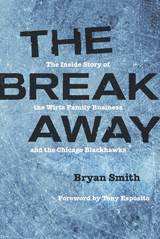 The Breakaway: The Inside Story of the Wirtz Family Business and the Chicago Blackhawks
Bryan Smith
Northwestern University Press, 2018 “This is a terrific book, a dramatic family saga told in artful prose and filled with emotional turmoil, a few surprisingly touching moments but enough dysfunction for a couple of Eugene O’Neill plays.” —Rick Kogan, Chicago Tribune
When Rocky Wirtz took over the Wirtz Corporation in 2007, including management of the Chicago Blackhawks, the fiercely beloved hockey team had fallen to a humiliating nadir. As chronic losers playing to a deserted stadium, they were worse than bad—they were irrelevant. ESPN named the franchise the worst in all of sports. Rocky's resurrection of the team's fortunes was—publicly, at least—a feel-good tale of shrewd acumen. Behind the scenes, however, it would trigger a father, son, and brother-against-brother drama of Shakespearean proportions. The Breakaway reveals that untold story.
Arthur Wirtz founded the family's business empire during the Depression. From roots in real estate, "King Arthur" soon expanded into liquor and banking, running his operations with an iron hand and a devotion to profit that earned him the nickname Baron of the Bottom Line. His son Bill further expanded the conglomerate, taking the helm of the Blackhawks in 1966. "Dollar Bill" Wirtz demanded unflinching adherence to Arthur's traditions and was notorious for an equally fierce temperament.
Yet when Rocky took the reins of the business after Bill's death, it was an organization out of step with the times and financially adrift. The Hawks weren't only failing on the ice—the parlous state of the team's finances imperiled every facet of the Wirtz empire. To save the team and the company, Rocky launched a radical turnaround campaign. Yet his modest proposal to televise the Hawks' home games provoked fierce opposition from Wirtz family insiders, who considered any deviation from Arthur and Bill's doctrines to be heresy.
Rocky's break with the edicts of his grandfather and father led to a reversal for the ages—three Stanley Cup championships in six years, a feat Fortune magazine called "the greatest turnaround in sports business history." But this resurrection came at a price, a fracturing of Rocky's relationships with his brother and other siblings. In riveting prose that recounts a story spanning three generations, The Breakaway reveals an insider's view of a brilliant but difficult Chicago business and sports dynasty and the inspiring story of perseverance and courage in the face of intense family pressures.
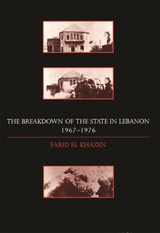 The Breakdown of the State in Lebanon, 1967–1976
Farid el Khazen
Harvard University Press, 2000 Straddling the boundaries of politics and history, this discerning book allows the reader to dig through the rubble of Lebanon's wars and learn exactly what has befallen it. With its remarkable open society, its plural political system, its well-educated and sophisticated peoples, and its tolerant confessional outlook, Lebanon is only now recovering the independence it once had, albeit in the face of Syria. In view of recent Lebanese history, can an open and democratic state be recaptured by a people entangled in a largely authoritarian Arab state system?
Farid el Khazen's arresting book shows how Lebanon was led toward its fate by its neighbors, yet ultimately undid itself. The Palestine Liberation Organization's presence was of central importance to the breakdown of the state, while the porousness of the democratic system could not contain the problems and violence. The breakdown was less a civil war in the conventional sense than a series of little wars with outside interference.
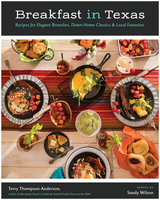 Breakfast in Texas: Recipes for Elegant Brunches, Down-Home Classics, and Local Favorites
By Terry Thompson-Anderson, with photos by Sandy Wilson
University of Texas Press, 2017 Texans love the morning meal, whether it’s bacon and eggs (often eaten in a breakfast taco) or something as distinctively nontraditional as saag paneer omelets, pon haus, or goat curry. A Lone Star breakfast can be a time for eating healthy, or for indulging in decadent food and drink. And with Texas’s rich regional and cultural diversity, an amazing variety of dishes graces the state’s breakfast and brunch tables. The first Texas cookbook dedicated exclusively to the morning meal, Breakfast in Texas gathers nearly one hundred recipes that range from perfectly prepared classics to the breakfast foods of our regional cuisines (Southern, Mexican, German, Czech, Indian, and Asian among them) to stand-out dishes from the state’s established and rising chefs and restaurants. Terry Thompson-Anderson organizes the book into sections that cover breakfast and brunch libations (with and without alcohol); simple, classic, and fancy egg presentations; pancakes, French toast, and waffles; meat lover’s dishes; seafood and shellfish; vegan dishes and sides; and pastries. The recipes reference locally sourced ingredients whenever possible, and Thompson-Anderson provides enjoyable notes about the chefs who created them or the cultural history they represent. She also offers an expert primer on cooking eggs, featuring an encounter with Julia Child, as well as a selection of theme brunches (the boozy brunch, the make-ahead brunch, New Year’s Day brunch, Mother’s Day brunch with seasonal ingredients, teenage daughter’s post-slumber party breakfast, and more). Sandy Wilson’s color photographs of many of the dishes and the chefs and restaurants who serve them provide a lovely visual counterpoint to the appetizing text.
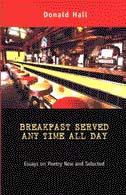 Breakfast Served Any Time All Day: Essays on Poetry New and Selected
Donald Hall
University of Michigan Press, 2004 Breakfast Served Any Time All Day collects forty years of writings on poetry in one essential volume by master of American letters Donald Hall.
Praise for Breakfast Served:
". . . the essays in this book are engaging, passionate, strange, and unified. Hall has been around a long time, and you can trace the concerns of a generation through the mind of this one man: questions about the diminished scope of poetry, the diminished ambitions of poets, how a poem 'means,' etc. . . . . Criticism . . . is an exercise in sanity, of which these essays are a splendid and useful example."
-Poetry
"A luminous and essential volume about the sensuality of language, its pleasures and sounds."
-Ploughshares
"It is in this merger of a poet's biography and a poem's body that Hall does his best work. . . . [Breakfast Served Any Time All Day] has an undeniably infectious quality to it. Finishing it, you cannot help but want to return to your bookshelf, and read-again or for the first time-the great forgotten poems of our past."
-Nathan Greenwood Thompson, Rain Taxi
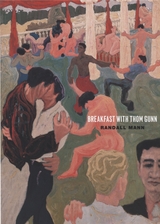 Breakfast with Thom Gunn
Randall Mann
University of Chicago Press, 2009 Aubade Those who lack a talent for love have come to walk the long Pier 7. Here at the end of the imagined world are three low-flying gulls like lies on the surface; the slow red of a pilot’s boat; the groan of a fisherman hacking a small shark— and our speech like the icy water, a poor translation that will not carry us across. What brought us west, anyway? A hunger. But ours is no Donner Party, we who feed only on scenery, the safest form of obfuscation: see how the bay is a gray deepening into gray, the color of heartbreak. Randall Mann’s Breakfast with Thom Gunn is a work both direct and unsettling. Haunted by the afterlife of Thom Gunn (1929–2004), one of the most beloved gay literary icons of the twentieth century, the poems are moored in Florida and California, but the backdrop is “pitiless,” the trees “thin and bloodless,” the words “like the icy water” of the San Francisco Bay. Mann, fiercely intelligent, open yet elusive, draws on the “graceful erosion” of both landscape and the body, on the beauty that lies in unbeauty. With audacity, anxiety, and unbridled desire, this gifted lyric poet grapples with dilemmas of the gay self embroiled in—and aroused by—a glittering, unforgiving subculture. Breakfast with Thom Gunnis at once formal and free, forging a sublime integrity in the fire of wit, intensity, and betrayal. Praise for Complaint in the Garden “We have before us a skillful, witty, passionate young poet. . . . Randall Mann is both attuned to and at odds with the natural world; he articulates the passions and predicaments of a self inside a massive, arousing, but sometimes brutal culture. And he accomplishes these things with buoyant lyric sensibilities and rejuvenating skills.”—Kenyon Review
Breaking Babe Ruth: Baseball's Campaign Against Its Biggest Star
Edmund F. Wehrle
University of Missouri Press, 2025 Rather than as a Falstaffian figure of limited intellect, Edmund Wehrle reveals Babe Ruth as an ambitious, independent operator, one not afraid to challenge baseball’s draconian labor system. To the baseball establishment, Ruth’s immense popularity represented opportunity, but his rebelliousness and potential to overturn the status quo presented a threat. After a decades-long campaign waged by baseball to contain and discredit him, the Babe, frustrated and struggling with injuries and illness, grew more acquiescent, but the image of Ruth that baseball perpetuated still informs how many people remember Babe Ruth to this day. This new perspective, approaching Ruth more seriously and placing his life in fuller context, is long overdue.
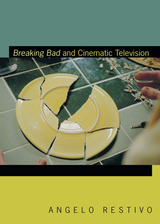 Breaking Bad and Cinematic Television
Angelo Restivo
Duke University Press, 2019 With its twisty serialized plots, compelling antiheroes, and stylish production, Breaking Bad has become a signature series for a new golden age of television, in which some premium cable shows have acquired the cultural prestige usually reserved for the cinema. In Breaking Bad and Cinematic Television Angelo Restivo uses the series as a point of departure for theorizing a new aesthetics of television: one based on an understanding of the cinematic that is tethered to affect rather than to medium or prestige. Restivo outlines how Breaking Bad and other contemporary “cinematic” television series take advantage of the new possibilities of postnetwork TV to create an aesthetic that inspires new ways to think about how television engages with the everyday. By exploring how the show presents domestic spaces and modes of experience under neoliberal capitalism in ways that allegorize the perceived twenty-first-century failures of masculinity, family, and the American Dream, Restivo shows how the televisual cinematic has the potential to change the ways viewers relate to and interact with the world.
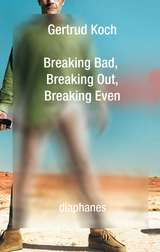 Breaking Bad, Breaking Out, Breaking Even
Gertrud Koch
Diaphanes, 2017 Breaking Bad is known for its grim and gritty outbursts of anger and violence. In the chaotic story of a meth-dealing high school chemistry teacher, time seems to collapse, and we feel as though the lives of the characters are moving inevitably closer to their ends. This warped perspective wends its way through virtually every aspect of the story, intensifying the meaning we attach to the characters’ precarious lives.
Hoping to cultivate a deeper understanding of the series, Breaking Bad, Breaking Out, Breaking Even offers a new way of approaching the program though its complex treatment of time. With its grotesque portrayal of life on the brink of death, argues Gertrud Koch, we can best view Breaking Bad as a black comedy between Chaplin’s Monsieur Verdoux and film noir. Koch takes readers through the ways in which this is accomplished through the show’s various visual elements and masterful temporal and narrative structuring. Full of fascinating insights, the book will appeal to the show’s many fans, as well as anyone interested in film studies, media studies, or popular culture.
 Breaking Barriers: Travel and the State in Early Modern Japan
Constantine Nomikos Vaporis
Harvard University Press, 1994 Travel in Tokugawa Japan was officially controlled by bakufu and domainal authorities via an elaborate system of barriers, or sekisho, and travel permits; commoners, however, found ways to circumvent these barriers, frequently ignoring the laws designed to control their mobility. In this study, Constantine Vaporis challenges the notion that this system of travel regulations prevented widespread travel, maintaining instead that a “culture of movement” in Japan developed in the Tokugawa era.
Using a combination of governmental documentation and travel literature, diaries, and wood-block prints, Vaporis examines the development of travel as recreation; he discusses the impact of pilgrimage and the institutionalization of alms-giving on the freedom of movement commoners enjoyed. By the end of the Tokugawa era, the popular nature of travel and a sophisticated system of roads were well established. Vaporis explores the reluctance of the bakufu to enforce its travel laws, and in doing so, beautifully evokes the character of the journey through Tokugawa Japan.
Breaking Boundaries: Women'S Regional Writing
Sherrie A. Inness
University of Iowa Press, 1997
These lively essays reveal the generational continuum of women's regional literature, which has always offered a voice to women and their concerns. By exploring the multiplicity of connections between women and regional writing and the subversive potential of regional writing to put forth social criticisms and correctives, Breaking Boundaries charts some of the major ways in which this literary genre is of particular importance to today's writers.
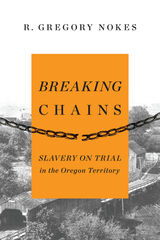 Breaking Chains: Slavery on Trial in the Oregon Territory
R. Gregory Nokes
Oregon State University Press, 2013 When they were brought to Oregon in 1844, Missouri slaves Robin and Polly Holmes and their children were promised freedom in exchange for helping develop their owner’s Willamette Valley farm. However, Nathaniel Ford, an influential settler and legislator, kept them in bondage until 1850, even then refusing to free their children. Holmes took his former master to court and, in the face of enormous odds, won the case in 1853.
In Breaking Chains, R. Gregory Nokes tells the story of the only slavery case adjudicated in Oregon’s pre-Civil War courts—Holmes v. Ford. Through the lens of this landmark case, Nokes explores the historical context of racism in Oregon and the West, reminding readers that there actually were slaves in Oregon, though relatively few in number.
Drawing on the court record, Nokes offers an intimate account of the relationship between a slave and his master from the slave’s point of view. He also explores the experiences of other slaves in early Oregon, examining attitudes toward race and revealing contradictions in the state’s history. Oregon was the only free state admitted to the union with a voter-approved constitutional clause banning African Americans and, despite the prohibition of slavery in the state, many in Oregon tolerated it and supported politicians who advocated for slavery, including Oregon’s first territorial governor.
Breaking Chains sheds light on a somber part of Oregon’s history, bringing the story of slavery in Oregon to a broader audience. The book will appeal to readers interested in Pacific Northwest history and in the history of slavery in the United States.
Breaking Down the State: Protestors Engaged
Edited by Jan Willem Duyvendak and James M. Jasper
Amsterdam University Press, 2015 In this important book, Jan Willem Duyvendak and James M. Jasper bring together an internationally acclaimed group of contributors to demonstrate the complexities of the social and political spheres in various areas of public policy. By breaking down the state into the players who really make decisions and pursue coherent strategies, these essays provide new perspectives on the interactions between political protestors and the many parts of the state“from courts, political parties, and legislators to police, armies, and intelligence services. By analyzing politics as the interplay of various players within structured arenas, Breaking Down the State provides an innovative look at law and order versus opposition movements in countries across the globe.
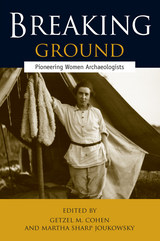 Breaking Ground: Pioneering Women Archaeologists
Getzel M. Cohen and Martha Sharp Joukowsky, Editors
University of Michigan Press, 2004 "At the close of the Victorian era, two generations of intrepid women abandoned Grand Tour travel for the rigors of archaeological expeditions, shining the light of scientific exploration on Old World antiquity. Breaking Ground highlights the remarkable careers of twelve pioneers---a compelling narrative of personal, social, intellectual, and historical achievement."
-Claire Lyons, The Getty Museum
"Behind these pioneering women lie a wide range of fascinating and inspiring life stories. Though each of their tales is unique, they were all formidable scholars whose important contributions changed the field of archaeology. Kudos to the authors for making their stories and accomplishments known to us all!"
-Jodi Magness, University of North Carolina, Chapel Hill
This book presents twelve fascinating women whose contributions to the development and progress of Old World archaeology---in an area ranging from Italy to Mesopotamia---have been immeasurable. Each essay in this collection examines the life of a pioneer archaeologist in the early days of the discipline, tracing her path from education in the classics to travel and exploration and eventual international recognition in the field of archaeology. The lives of these women may serve as models both for those interested in gender studies and the history of archaeology because in fact, they broke ground both as women and as archaeologists.
The interest inherent in these biographies will reach well beyond defined disciplines and subdisciplines, for the life of each of these exciting and accomplished individuals is an adventure story in itself
 Breaking Grounds: Thinking with Reiner Schürmann
Edited by David Payne and Marcia Sá Cavalcante Schuback
Diaphanes, 2025 An anthology of responses to Reiner Schürmann’s philosophical research, writings, and commentaries.
In recent years, academic interest in Reiner Schürmann’s philosophical work has grown significantly. His thought on “the principle of anarchy “ and on “broken hegemonies” has begun to draw greater attention and has inspired recent works by, among others, Catherine Malabou and Giorgio Agamben. In times of globalization and uni-dimensionalization, Schürmann’s deconstruction of the concept of the One, upon which western metaphysics and civilization has consolidated its power, is more than actual. It seems urgent. The present volume gathers, for the first time in an anthology, contributions from scholars from different parts of the world who have been studied and engaged with Schürmann’s thought over the years. The anthology is the outcome of the first international conference on Schürmann’s philosophical work held at Södertörn University, in 2021 in Stockholm, addressing the legacy of his thought on broken hegemonies.
With contributions by Claudia Baracchi, Peg Birmingham, Emmanuel Cattin, Marcia Sá Cavalcante Schuback, Astrid Grelz, Francesco Guercio, Peter Hanly, Nomadic Joy, Krystof Kasprzak, Jérôme Lèbre, Reginald Lilly, Michael Marder, Alberto Martinengo, Ian Alexander Moore, David Payne, Ramona Rat, Elisabeth Rigal, Gustav Strandberg.
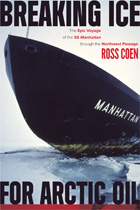 Breaking Ice for Arctic Oil: The Epic Voyage of the SS Manhattan through the Northwest Passage
Ross Coen
University of Alaska Press, 2012 In 1969, an icebreaking tanker, the SS Manhattan, was commissioned by Humble Oil to transit the Northwest Passage in order to test the logistical and economic feasibility of an all-marine transportation system for Alaska North Slope crude oil. Proposed as an alternative to the Trans-Alaska Pipeline, the Manhattan made two voyages to the North American Arctic and collected volumes of scientific data on ice conditions and the behavior of ships in ice. Although the Manhattan successfully navigated the Northwest Passage—closing a five-hundred-year chapter of Arctic exploration by becoming the first commercial vessel to do so—the expedition ultimately demonstrated the impracticality of moving crude oil using icebreaking ships. Breaking Ice for Arctic Oil details this historic voyage, establishing its significant impact on the future of marine traffic and resource development in the Arctic and setting the stage for the current oil crisis.
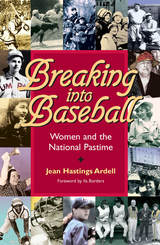 Breaking into Baseball: Women and the National Pastime
Jean Hastings Ardell. Foreword by Ila Borders
Southern Illinois University Press, 2005 While baseball is traditionally perceived as a game to be played, enjoyed, and reported from a masculine perspective, it has long been beloved among women—more so than any other spectator sport. Breaking into Baseball: Women and the National Pastime upends baseball’s accepted history to at last reveal just how involved women are, and have always been, in the American game. Through provocative interviews and deft research, Jean Hastings Ardell devotes a detailed chapter to each of the seven ways women participate in the game—from the stands as fans, on the field as professionals or as amateur players, behind the plate as umpires, in the front office as executives, in the press box as sportswriters and reporters, or in the shadows as Baseball Annies. From these revelatory vantage points, Ardell invites overdue appreciation for the affinity and talent women bring to baseball at all levels and shows us our national game anew. From its ancient origins in spring fertility rituals through contemporary marketing efforts geared toward an ever-increasing female fan base, baseball has always had a feminine side, and generations of women have sought—and been sought after—to participate in the sport, even when doing so meant challenging the cultural mores of their era. In that regard, women have been breaking into baseball from the very beginning. But recent decades have witnessed great strides in legitimizing women’s roles on the diamond as players and umpires as well as in vital management and media roles. In her thoughtfully organized and engagingly written survey, Ardell offers a chance for sports enthusiasts and historians of both genders to better appreciate the storied and complex relationship women have so long shared with the game and to glimpse the future of women in baseball. Breaking into Baseball is augmented by twenty-four illustrations and a foreword from Ila Borders, the first woman to play more than three seasons of men’s professional baseball.
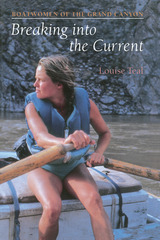 Breaking Into the Current: Boatwomen of the Grand Canyon
Louise Teal
University of Arizona Press, 1994 In 1973, Marilyn Sayre gave up her job as a computer programmer and became the first woman in twenty years to run a commercial boat through the Grand Canyon. Georgie White had been the first, back in the 1950s, but it took time before other women broke into guiding passengers down the Colorado River. This book profiles eleven of the first full-season Grand Canyon boatwomen, weaving together their various experiences in their own words.
Breaking Into the Current is a story of romance between women and a place. Each woman tells a part of every Canyon boatwoman's story: when Marilyn Sayre talks about leaving the Canyon, when Ellen Tibbets speaks of crew camaraderie, or when Martha Clark recalls the thrill of white water, each tells how all were involved in the same romance.
All the boatwomen have stories to tell of how they first came to the Canyon and why they stayed. Some speak of how they balanced their passion for being in the Canyon against the frustration of working in a traditionally male-oriented occupation, where today women account for about fifteen percent of the Canyon's commercial river guides.
As river guides in love with the Canyon and their work, these women have followed their hearts. "I've done a lot," says Becca Lawton, "but there's been nothing like holding those oars in my hands and putting my boat exactly where I wanted it. Nothing."
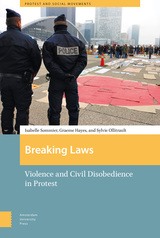 Breaking Laws: Violence and Civil Disobedience in Protest
Isabelle Sommier and Graeme Hayes
Amsterdam University Press, 2019 Breaking Laws: Violence and Civil Disobedience in Protest questions the complex relationship between social movements and violence through two contrasted lenses; first through the short-lived radical left wing post ’68 revolutionary violence, and secondly in the present diffusion of civil disobedience actions, often at the border between non-violence and violence. This book shows how and why violence occurs or does not, and what different meanings it can take. The short-lived extreme left revolutionary groups that grew out of May ’68 and the opposition to the Vietnam War (such as the German Red Army Faction, the Italian Red Brigades, and the Japanese Red Army) are without any doubt on the violent side. More ambiguous are the burgeoning contemporary forms of "civil" disobedience, breaking the law with the aim of changing it. In theory, these efforts are associated with non-violence and self-restraint. In practice, the line is more difficult to trace, as much depends on how political players define and frame non-violence and political legitimacy.
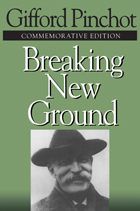 Breaking New Ground
Gifford Pinchot; Introduction by Char Miller and V. Alaric Sample
Island Press, 1998 Vigorous, colorful, bold and highly personal, Breaking New Ground is the autobiography of Gifford Pinchot, founder and first chief of the Forest Service. He tells a fascinating tale of his efforts, under President Theodore Roosevelt, to wrest the forests from economic special interests and to bring them under management for multiple- and long-range use. His philosophy of "the greatest good for the greatest number over the longest time" has become the foundation upon which this country's conservation policy is based. In a new introduction for this special commemorative edition, Char Miller of Trinity University and V. Alaric Sample of the Pinchot Institute for Conservation trace the evolution of Gifford Pinchot's career in the context of his personal life and the social and environmental issues of his time. They illuminate the courage and vision of the man whose leadership is central to the development of the profession of forestry in the United States. Breaking New Ground is essential reading for anyone interested in understanding the basis of our present national forest policy, and the origins of the conservation movement.
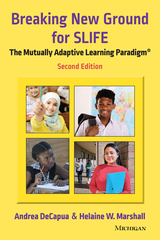 Breaking New Ground for SLIFE: The Mutually Adaptive Learning Paradigm
Andrea DeCapua and Helaine W. Marshall
University of Michigan Press, 2023 In its second edition, Breaking New Ground for SLIFE builds on its model for supporting students who are new to English and may have experienced a disruption in their schooling. The practices presented in this book emerge from the belief that education for students with limited or interrupted formal education, also known as SLIFE, should not be remedial but should build on the students’ prior learning experiences and existing areas of knowledge. This second edition has been significantly updated, informed by recent research in the field, feedback from teachers, and new scholarly treatments of the topic. Breaking New Ground for SLIFE, second edition, explores the MALP approach, highlights how technology can be incorporated into classroom activities, and includes actual MALP projects implemented by MALP-trained teachers of both young and adolescent learners. In addition, the authors provide a newly revised MALP Teacher Planning Checklist. By reading Breaking New Ground for SLIFE, educators will: - Further develop their understanding of the needs of students with limited or interrupted formal education (SLIFE)
- Learn about the Mutually Adaptive Learning Paradigm (MALP) and how to integrate it into their classrooms
- Discover and learn about the MALP instructional approach and how to use it to develop a project-based curriculum using examples from teachers in the field
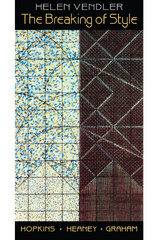 The Breaking of Style: Hopkins, Heaney, Graham
Helen Vendler
Harvard University Press, 1995 "Lucid and elegant...a tour de force."
—A. O. Scott, Nation
Three lectures on the fraught process of poetic development from a titan of contemporary criticism.
Style is the material body of lyric poetry. To cast off an earlier style is to commit an act of violence against the creative self. Why do poets so often make these dramatic breaks? In her 1994 Richard Ellman Lectures, Helen Vendler investigates poets’ motives for inventing a new voice, along with their means of doing so. Exploring three archetypal ruptures, she yields a new view of the interplay of moral, emotional, and intellectual forces in each poet’s work.
Gerard Manley Hopkins’s invention of sprung rhythm marks a radical break with his early style. Rhythm, Vendler shows us, is at the heart of Hopkins’s aesthetic, and sprung rhythm is his symbol for danger, difference, and the shock of the beautiful. In Seamus Heaney’s work, she identifies clear shifts in grammatical “atmosphere” from one poem to the next—from “nounness” to the “betweenness” of an adverbial style—shifts whose moral and political implications come under scrutiny here. And finally, Vendler looks at Jorie Graham’s departure from short lines to numbered lines to squared long lines of sentences, marking a move from “deliberation” to cinematic “freeze-framing” to “coverage,” each with its own meaning in this poet’s career.
Throughout, Vendler reminds us that what distinguishes successful poetry is a mastery of language at all levels—including the rhythmic, the grammatical, and the graphic. A lucid reading of three poets and a superb exposition of the craft of poetry, The Breaking of Style revives our lapsed sense of what style means.
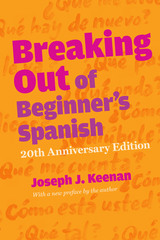 Breaking Out of Beginner's Spanish
By Joseph J. Keenan
University of Texas Press, 2014 Many language books are boring—this one is not. Written by a native English speaker who learned Spanish the hard way—by trying to talk to Spanish-speaking people—it offers English speakers who have a basic knowledge of Spanish hundreds of tips for using the language more fluently and colloquially, with fewer obvious “gringo” errors. Writing with humor, common sense, and a minimum of jargon, Joseph J. Keenan covers everything from pronunciation, verb usage, and common grammatical mistakes to the subtleties of addressing other people, “trickster” words that look alike in both languages, inadvertent obscenities, and intentional swearing. He guides readers through the set phrases and idiomatic expressions that pepper the native speaker’s conversation and provides a valuable introduction to the most widely used Spanish slang. With this book, both students in school and adult learners who never want to see another classroom can rapidly improve their speaking ability. Breaking Out of Beginner’s Spanish will be an essential aid in passing the supreme language test—communicating fluently with native speakers.
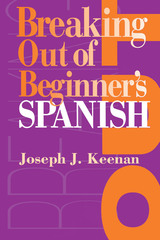 Breaking Out of Beginner's Spanish
By Joseph J. Keenan
University of Texas Press, 1994 Many language books are boring—this one is not. Written by a native English speaker who learned Spanish the hard way—by trying to talk to Spanish-speaking people—it offers English speakers with a basic knowledge of Spanish hundreds of tips for using the language more fluently and colloquially, with fewer obvious "gringo" errors.
Writing with humor, common sense, and a minimum of jargon, Joseph Keenan covers everything from pronunciation, verb usage, and common grammatical mistakes to the subtleties of addressing other people, "trickster" words that look alike in both languages, inadvertent obscenities, and intentional swearing. He guides readers through the set phrases and idiomatic expressions that pepper the native speaker's conversation and provides a valuable introduction to the most widely used Spanish slang.
With this book, both students in school and adult learners who never want to see another classroom can rapidly improve their speaking ability. Breaking Out of Beginner's Spanish will be an essential aid in passing the supreme language test-communicating fluently with native speakers.
Breaking Point: The UK Referendum on the EU and Its Aftermath
Gary Gibbon
Haus Publishing, 2017 As the aftermath of Brexit continues to unfold, people around the world are wondering just how Brexit happened, where post-referendum Britain is heading, and what lessons might be learned by the global community. Gary Gibbon, a preeminent political broadcaster who had extraordinary access to both sides of the campaign leading up to the referendum, explores all of these issues in Breaking Point.
Examining official and off-the-record meetings with both senior politicians and ordinary voters, Gibbon addresses tough questions that are troubling the entire European continent: Now that the United Kingdom has voted for Brexit, to what extent can it truly “leave” a set of relationships that extend to the country’s doorstep? And will the decision be a lethal blow to the European Union, perhaps spurring on copycat secession movements?
 Breaking Silence: The Case That Changed the Face of Human Rights
Richard Alan White
Georgetown University Press Young seventeen-year-old Joelito Filártiga was taken from his family home in Asunción, Paraguay, brutally tortured, and murdered by the Paraguayan police. Breaking Silence is the inside story of the quest for justice by his father—the true target of the police—Paraguayan artist and philanthropist Dr. Joel Filártiga. That cruel death, and the subsequent uncompromising struggle by Joelito's father and family, led to an unprecedented sea change in international law and human rights.
The author, Richard Alan White, first became acquainted with the Filártiga family in the mid-1970s while doing research for his dissertation on Paraguayan independence. Answering a distressed letter from Joelito's father, he returned to Paraguay and journeyed with the Filártiga family on their long and difficult road to redress. White gives the reader a compelling first-hand, participant-observer perspective, taking us into the family with him, to give witness to not only their agony and sorrow, but their resolute strength as well—strength that led to a groundbreaking $10 million legal decision in Filártiga v. Peña. (Americo Norberto Peña-Irala was the Paraguayan police officer responsible for Joelito's abduction and murder, whom the Filártigas had arrested after finding him hiding in Brooklyn.) That landmark decision, based on the almost obscure Alien Tort Claims Act of 1789, ruled that U.S. courts could accept jurisdiction in international cases—recognizing the right of foreign human rights victims to sue—even though the alleged violation occurred in another country by a non-American and against a non-American. So fundamentally has the Filártiga precedent changed the landscape of international human rights law, that it has served as the basis for nearly 100 progeny suits, and grown to encompass not only human rights abuses, but also violations of international environmental and labor rights law. Today, there are dozens of class action suits pending against corporate defendants ranging from oil conglomerates destroying the Amazon rainforest to designer clothing companies running sweatshops abroad. Breaking Silence is a remarkable, consuming story, documenting not only the most celebrated case in the international human rights field—but also the tragic and touchingly human story behind it that gives it life. In 2001, Dr. Filártiga was nominated for the Nobel Peace Prize and the Alien Tort Claims Act continues to be hotly debated among politicians and lawmakers.
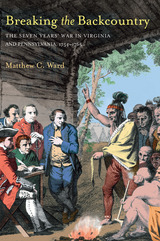 Breaking The Backcountry: Seven Years War In Virginia And Pennsylvania 1754-1765
Matthew C. Ward
University of Pittsburgh Press, 2004 Even as the 250th anniversary of its outbreak approaches, the Seven Years' War (otherwise known as the French and Indian War) is still not wholly understood. Most accounts tell the story as a military struggle between British and French forces, with shifting alliances of Indians, culminating in the British conquest of Canada. Scholarly and popular works alike, including James Fennimore Cooper's Last of the Mohicans, focus on the action in the Hudson River Valley and the St. Lawrence Seaway. Matthew C. Ward tells the compelling story of the war from the point of view of the region where it actually began, and whose people felt the devastating effects of war most keenly-the backcountry communities of Virginia and Pennsylvania.
Previous wars in North America had been fought largely on the New England and New York frontiers. But on May 28, 1754, when a young George Washington commanded the first shot fired in western Pennsylvania, fighting spread for the first time to Virginia and Pennsylvania. Ward's original research reveals that on the eve of the Seven Years' War the communities of these colonies were isolated, economically weak, and culturally diverse. He shows in riveting detail how, despite the British empire's triumph, the war brought social chaos, sickness, hunger, punishment, and violence, to the backcountry, much of it at the hands of Indian warriors.
Ward's fresh analysis reveals that Indian raids were not random skirmishes, but part of an organized strategy that included psychological warfare designed to make settlers flee Indian territories. It was the awesome effectiveness of this “guerilla” warfare, Ward argues, that led to the most enduring legacies of the war: Indian-hating and an armed population of colonial settlers, distrustful of the British empire that couldn't protect them. Understanding the horrors of the Seven Years' War as experienced in the backwoods thus provides unique insights into the origins of the American republic.
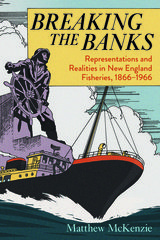 Breaking the Banks: Representations and Realities in New England Fisheries, 1866-1966
Matthew McKenzie
University of Massachusetts Press, 2018 With skillful storytelling, Matthew McKenzie weaves together the industrial, cultural, political, and ecological history of New England's fisheries through the story of how the Boston haddock fleet—one of the region's largest and most heavily industrialized—rose, flourished, and then fished itself into near oblivion before the arrival of foreign competition in 1961. This fleet also embodied the industry's change during this period, as it shucked its sail-and-oar, hook-and-line origins to embrace mechanized power and propulsion, more sophisticated business practices, and political engagement.
Books, films, and the media have long portrayed the Yankee fisherman's hard-scrabble existence, as he faced brutal weather on the open seas and unnecessary governmental restrictions. As McKenzie contends, this simplistic view has long betrayed commercial fisheries' sophisticated legislative campaigns in Washington, DC, as they sought federal subsidies and relief and, eventually, fewer constricting regulations. This clash between fisheries' representation and their reality still grips fishing communities today as they struggle to navigate age-old trends of fleet consolidation, stock decline, and intense competition.
Breaking the Barnyard Barrier: A Woman Veterinarian Paves the Way
Linda Rhodes
University of Nevada Press, 2026 In the late 1970s the golden valley between Utah’s Wasatch Mountains was home to some of the best dairies in the country. That was also where Linda Rhodes, a newly minted large animal veterinarian, had to prove that a woman could do what the Mormon dairymen were sure was a man’s job. She was often scared that they were right. Throughout her experience, she tackled a menagerie of challenging medical and surgical cases that forced her to be fearless. Every bovine life she saved helped her confidence grow, but each failure left her feeling defeated—as did the mounting tensions between pursuing a demanding career and saving a crumbling marriage.
In Breaking the Barnyard Barrier, Linda Rhodes tells the story of how a woman, through grit and tears, made her way in a man’s world and blazed a path that prevailed against career stereotypes.
Breaking the Bonds of Corruption: From Academic Dishonesty to Informal Business Practices in Post-Soviet Ukraine
Elena Denisova-Schmidt
Harvard University Press In Breaking the Bonds of Corruption, Elena Denisova-Schmidt takes a broad view of corruption and its prevalence in global societies, using the case of Ukraine to examine practices that are considered corrupt in historical, social, and economic perspectives. She investigates corrupt behavior in higher education, both in Ukraine and internationally, as well as reliance on corruption in Ukrainian business. For both areas, the author relies on studies and polling that she and her colleagues administered at a number of Ukrainian universities and with Ukrainian businesses. This is the first English-language book dedicated to examining corruption as a widespread social phenomenon in post-Soviet Ukraine and makes an important contribution to the maturing study of informal practices in Ukraine and the region.
 Breaking the Chains: Gender, Context, and the Politics of Writing in Modern China
Dong Limin
Seagull Books, 2025 A rigorous exploration of literature as a tool for social change, revealing how gender and national identity intertwine in China’s modern development.
How has literature shaped gender politics in modern China? How has the concept of “woman” evolved within the shifting sociopolitical landscape? Old Chains and New delves into these questions by examining the dynamic interplay between literature, gender, and historical change. Drawing from literary studies, history, and sociology, this book reveals how women’s writing has not only reflected but also actively shaped cultural and national transformations.
From the late Qing era, when the “woman question” emerged as part of China’s response to imperialist pressures, to the ongoing evolution of feminist literary scholarship, this study argues that gender and literature are deeply interwoven. Women’s liberation in modern China was never solely about gender equality—it became a driving force for broader social change and national identity formation. Engaging with the complexities of women’s literature through a cultural-political lens, this book challenges static definitions and calls for a reevaluation of women’s literature not just as a literary category but as a key component in shaping China’s modern intellectual and cultural history.
By adopting the framework of “China as method,” Old Chains and New reimagines the role of literature in ideological and cultural shifts. It highlights women’s writing as a unique form of aesthetic politics—one with the power to intervene in and transform reality.
 Breaking the Chains: Gender, Context, and the Politics of Writing in Modern China
Dong Limin
Seagull Books, 2025 A rigorous exploration of literature as a tool for social change, revealing how gender and national identity intertwine in China’s modern development.
How has literature shaped gender politics in modern China? How has the concept of “woman” evolved within the shifting sociopolitical landscape? Old Chains and New delves into these questions by examining the dynamic interplay between literature, gender, and historical change. Drawing from literary studies, history, and sociology, this book reveals how women’s writing has not only reflected but also actively shaped cultural and national transformations.
From the late Qing era, when the “woman question” emerged as part of China’s response to imperialist pressures, to the ongoing evolution of feminist literary scholarship, this study argues that gender and literature are deeply interwoven. Women’s liberation in modern China was never solely about gender equality—it became a driving force for broader social change and national identity formation. Engaging with the complexities of women’s literature through a cultural-political lens, this book challenges static definitions and calls for a reevaluation of women’s literature not just as a literary category but as a key component in shaping China’s modern intellectual and cultural history.
By adopting the framework of “China as method,” Old Chains and New reimagines the role of literature in ideological and cultural shifts. It highlights women’s writing as a unique form of aesthetic politics—one with the power to intervene in and transform reality.
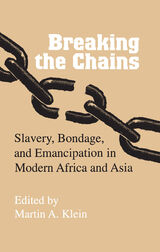 Breaking the Chains: Slavery, Bondage, and Emancipation in Modern Africa and Asia
Martin A. Klein
University of Wisconsin Press, 1993 “Martin Klein has brought together recent work on the abolition of slavery, from Ottoman Turkey to Thailand and from South India to West Africa. This anthology builds on the recent scholarship on both slavery in Asia and Africa and the end of slavery as a world-wide historical phenomenon. Whereas other anthologies have tended to focus on either Africa or Asia, this project brings together in one volume case studies and methodological approaches concerning both regions. Breaking the Chains will be an important part of the relatively sparse literature on emancipation in comparative and global context.”—Richard Roberts, Stanford University
Because the American history of slavery and emancipation tends to be foremost in Western minds, few realize that traditional forms of servitude still exist in a variety of places around the world: children are sold on the streets of Bangkok, bondage persists in India despite official efforts to abolish it, and until 1980 slavery was legal in Mauritania.
Breaking the Chains deals with emancipation in African and Asian societies which were either colonized or came under the domination of European powers in the nineteenth century. In these societies, emancipation involved the imposition on non-European societies of an explicitly European discourse on slavery, and, in most cases, a free labor ideology. Most of the slave masters described in these essays were not European and found European ideas on emancipation difficult to accept.
Against this backdrop, the essayists (many of whom contribute their own non-Western perspective) focus on the transition from slavery (or other forms of bondage) to emancipation. They show that in each case the process involved pressure from European abolition movements, the extension of capitalist relations of production, the concerns and perceptions of the colonial state, and the efforts of non-Western elites to modernize their cultures.
Martin A. Klein argues that the Asian and African experience has much in common with the American experience, particularly in efforts to control labor and family life. The struggle to control the labor of former slaves has often been intense and, he suggests, has had a continuing impact on the social order in former slave societies.
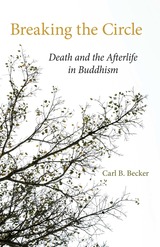 Breaking the Circle: Death and the Afterlife in Buddhism
Carl B. Becker
Southern Illinois University Press, 1993 In this much-needed examination of Buddhist views of death and the afterlife, Carl B. Becker bridges the gap between books on death in the West and books on Buddhism in the East. Other Western writers have addressed the mysteries surrounding death and the afterlife, but few have approached the topic from a Buddhist perspective. Here, Becker resolves questions that have troubled scholars since the beginning of Buddhism: How can Buddhism reconcile its belief in karma and rebirth with its denial of a permanent soul? What is reborn? And when, exactly, is the moment of death? By systematically tracing Buddhism’s migration from India through China, Japan, and Tibet, Becker demonstrates how culture and environment affect Buddhist religious tradition. In addition to discussing historical Buddhism, Becker shows how Buddhism resolves controversial current issues as well. In the face of modern medicine’s trend toward depersonalization, traditional Buddhist practices imbue the dying process with respect and dignity. At the same time, Buddhist tradition offers documented precedents for decision making in cases of suicide and euthanasia.
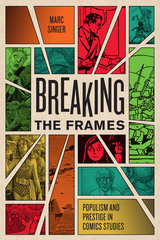 Breaking the Frames: Populism and Prestige in Comics Studies
By Marc Singer
University of Texas Press, 2018 A CHOICE Outstanding Academic Title, 2019 Comics studies has reached a crossroads. Graphic novels have never received more attention and legitimation from scholars, but new canons and new critical discourses have created tensions within a field built on the populist rhetoric of cultural studies. As a result, comics studies has begun to cleave into distinct camps—based primarily in cultural or literary studies—that attempt to dictate the boundaries of the discipline or else resist disciplinarity itself. The consequence is a growing disconnect in the ways that comics scholars talk to each other—or, more frequently, do not talk to each other or even acknowledge each other’s work. Breaking the Frames: Populism and Prestige in Comics Studies surveys the current state of comics scholarship, interrogating its dominant schools, questioning their mutual estrangement, and challenging their propensity to champion the comics they study. Marc Singer advocates for greater disciplinary diversity and methodological rigor in comics studies, making the case for a field that can embrace more critical and oppositional perspectives. Working through extended readings of some of the most acclaimed comics creators—including Marjane Satrapi, Alan Moore, Kyle Baker, and Chris Ware—Singer demonstrates how comics studies can break out of the celebratory frameworks and restrictive canons that currently define the field to produce new scholarship that expands our understanding of comics and their critics.
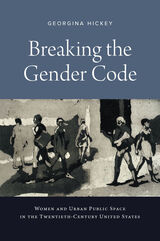 Breaking the Gender Code: Women and Urban Public Space in the Twentieth-Century United States
Georgina Hickey
University of Texas Press, 2023 A history of the activism that made public spaces in American cities more accessible to women.
From the closing years of the nineteenth century, women received subtle—and not so subtle—messages that they shouldn’t be in public. Or, if they were, that they were not safe. Breaking the Gender Code tells the story of both this danger narrative and the resistance to it. Historian Georgina Hickey investigates challenges to the code of urban gender segregation in the twentieth century, focusing on organized advocacy to make the public spaces of American cities accessible to women. She traces waves of activism from the Progressive Era, with its calls for public restrooms, safe and accessible transportation, and public accommodations, through and beyond second-wave feminism, and its focus on the creation of alternative, women-only spaces and extensive anti-violence efforts. In doing so, Hickey explores how gender segregation intertwined with other systems of social control, as well as how class, race, and sexuality shaped activists' agendas and women's experiences of urban space. Drawing connections between the vulnerability of women in public spaces, real and presumed, and contemporary debates surrounding rape culture, bathroom bills, and domestic violence, Hickey unveils both the strikingly successful and the incomplete initiatives of activists who worked to open up public space to women.
Breaking the Jaws of Silence: Sixty American Poets Speak to the World
Sholeh Wolpé
University of Arkansas Press, 2013 Through the support of PEN Center USA, Iranian American poet and translator Sholeh Wolpé has brought together sixty American poets to address the world through poems that not only meditate on the principles of freedom, justice, and tolerance but also boldly and directly address specific countries. Natasha Trethewey, Robert Bly, Rita Dove, Yusef Komunyakaa, Galway Kinnell, Philip Levine, Carolyn Forché, Billy Collins, Jorie Graham, Naomi Shihab Nye, and Quincy Troupe are just some of the poets whose work is gathered in this powerful new collection. These poets speak out in the tradition of all poets who speak out in uprisings, seeking to change the landscape despite an environment of oppression, torture, and denial of basic human rights. All poems included were gifted to this anthology, which will benefit PEN Center USA's Freedom to Write program.
Breaking the Land: The Transformation of Cotton, Tobacco, and Rice Cultures since 1880
Pete Daniel
University of Illinois Press, 1985 Winner of the Herbert Feis Award of the American Historical Association, 1985. Winner of the Charles S. Sydnor Award of the Southern Historical Association, 1985. Winner of the 1990 Robert Athearn Award of the Western History Association and an Honorable Mention for the 1990 James S. Donnelly, Sr., Prize in History and the Social Sciences from the American Conference for Irish Studies.
Breaking the Mind
Kristian S. Heal
Catholic University of America Press, 2014 This collection of sixteen new critical essays offers fresh perspectives on the Book of Steps, adding greater detail and depth to our understanding of the work's intriguing picture of early Syriac asceticism as practiced within the life of a local church and community.
Breaking the Silence: The German Who Exposed the Final Solution.
Walter Laqueur and Richard Breitman
Brandeis University Press, 1994 Through unparalleled historical detective work, noted scholars Walter Laqueur and Richard Breitman reveal the inspiring tale of Eduard Schulte, the Breslau business leader who risked his life to gather information about such Nazi activities as the revised date of the German attack on Poland and the Nazi plan for mass extermination of European Jews. First published in 1986, Breaking the Silence is reissued with both a new foreword and afterword by the authors.
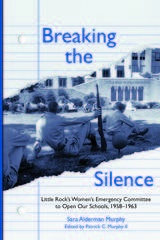 Breaking the Silence: The Little Rock Women's Emergency Committee to Open Our Schools, 1958–1963
Sara Murphy
University of Arkansas Press, 1997 The Little Rock Central High School integration crisis did not end in1957 when President Eisenhower sent a portion of the first Airborne Division to protect nine black students. The turmoil was entering its second year in 1958 when Arkansas governor Orval Faubus invoked a hastily passed state law to close the high schools rather than obey the federal court orders that would integrate them. A group of respectable, middle-class white women, faced with the prospect of no schools as well as the further loss of their city’s good name, turned militant. Led by Adolphine Fletcher Terry, a prominent, “old family” civic leader in her seventies, the women quickly put together the Women’s Emergency Committee to Open Our Schools (WEC), a highly effective organization that bombarded the city with ads, fliers, and statements challenging Faubus’s action. At peak membership, the WEC mustered two thousand to their cause. Largely inexperienced in politics when they joined the WEC, these women became articulate, confident promoters of public schools and helped others to understand that those schools must be fully integrated. Forty years later, Sara Murphy, a key member of the WEC, recounts the rarely told sto1y of these courageous women who formed a resistance movement. With passion and sensitivity, she reconstructs the challenges and triumphs of that battle, which issued from the mutual link Southern white women shared with disfranchised African Americans in their common goal for full citizenship.
Breaking the Vicious Circle: Toward Effective Risk Regulation
Stephen Breyer
Harvard University Press, 1993 Breaking the Vicious Circle is a tour de force that should be read by everyone who is interested in improving our regulatory processes. Written by a highly respected federal judge, who would go on to serve on the Supreme Court, and who obviously recognizes the necessity of regulation but perceives its failures and weaknesses as well, it pinpoints the most serious problems and offers a creative solution that would for the first time bring rationality to bear on the vital issue of priorities in our era of limited resources.
 Breaking the World: Black Insecurity and the Horizons of Speculative Fiction
Justin L. Mann
Duke University Press, 2026 In Breaking the World, Justin L. Mann argues that Black speculative fictions are an essential but overlooked archive for understanding the modern security ambitions of the United States. Foregrounding how the contemporary security state renders Black life insecure, Mann theorizes worldbreaking: speculative narrative, aesthetic, and ethical strategies that Black writers, musicians, and artists employ to unmake the processes by which state and parastate agents augment and build up the tools, techniques, and infrastructures intended to make people safer. He shows how the techniques of worldbreaking in the works of Octavia E. Butler, Colson Whitehead, N.K. Jemisin, Janelle Monáe, and the Marvel and DC Cinematic Universes chart the distinction between securitization and Black insecurity. These works illuminate the difference between the antiblackness of state security and the power of Black collectivity. Contending that speculative worldbreaking is a vital part of the Black radical imagination, Mann shows that its destructive strategies can help transform worlds of securitization to worlds of liberation.
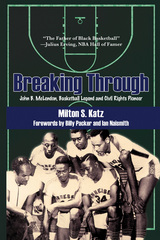 Breaking Through: John B. McLendon, Basketball Legend and Civil Rights Pioneer
Milton S. Katz
University of Arkansas Press, 2007 Winner, William Rockhill Nelson Award John B. McLendon was the last living protégé of basketball’s inventor, Dr. James Naismith, and one of the “top ten basketball coaches of the century” in Billy Packer’s opinion. McLendon’s amazing records in college and pro basketball earned him a spot in the Basketball Hall of Fame (the first black coach to be inducted), and his coaching philosophy has had a huge influence on basketball coaches. Breaking Through is also a powerful and inspirational story about segregation and a champion’s struggle for equality in 1940s and 50s America. Black Magic, ESPN’s Peabody Award–winning documentary about players and coaches who attended historically black colleges and universities, covers many of the events in McLendon’s life that Katz writes about in his book. John McLendon was elected to the Naismith Memorial Basketball Hall of Fame in 2016.
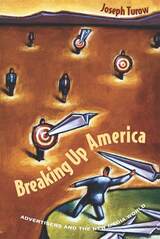 Breaking Up America: Advertisers and the New Media World
Joseph Turow
University of Chicago Press, 1997 Combining shrewd analysis of contemporary practices with a historical perspective, Breaking Up America traces the momentous shift that began in the mid-1970s when advertisers rejected mass marketing in favor of more aggressive target marketing. Turow shows how advertisers exploit differences between consumers based on income, age, gender, race, marital status, ethnicity, and lifesyles.
"An important book for anyone wanting insight into the advertising and media worlds of today. In plain English, Joe Turow explains not only why our television set is on, but what we are watching. The frightening part is that we are being watched as we do it."—Larry King
"Provocative, sweeping and well made . . . Turow draws an efficient portrait of a marketing complex determined to replace the 'society-making media' that had dominated for most of this century with 'segment-making media' that could zero in on the demographic and psychodemographic corners of our 260-million-person consumer marketplace."—Randall Rothenberg, Atlantic Monthly
Breaking Up (at) Totality: A Rhetoric of Laughter
D. Diane Davis
Southern Illinois University Press, 2000 Rhetoric and composition theory has shown a renewed interest in sophistic countertraditions, as seen in the work of such "postphilosophers" as Jacques Derrida, Michel Foucault, and Hélène Cixous, and of such rhetoricians as Susan Jarratt and Steven Mailloux. As D. Diane Davis traces today’s theoretical interest to those countertraditions, she also sets her sights beyond them. Davis takes a “third sophistics” approach, one that focuses on the play of language that perpetually disrupts the “either/or” binary construction of dialectic. She concentrates on the nonsequential third—excess—that overflows language’s dichotomies. In this work, laughter operates as a trope for disruption or breaking up, which is, from Davis’s perspective, a joyfully destructive shattering of our confining conceptual frameworks.
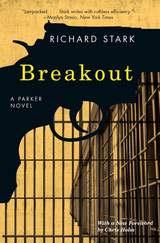 Breakout: A Parker Novel
Richard Stark
University of Chicago Press, 2017 An action-packed crime novel starring Parker, the heister starring in the forthcoming Shane Black film Play Dirty!
Richard Stark's Parker novels are the hardest of hard-boiled, classic crime novels where the heists are huge, the body counts are high, and the bad guys usually win.
The Parker novels have been a huge influence on countless writers and filmmakers, including Quentin Tarantino, Stephen King, George Pelecanos, Colson Whitehead, Lucy Sante, John Banville, and many more. Their stripped-down language and hard-as-nails amorality create an unforgettable world where the next score could be the big one, but your next mistake could also be your last. There's nothing else like them.
With Parker locked up and about to be unmasked, Breakout follows his Houdini-like escape from prison with a team of convicts. But when a new heist and new dangers—con artists, snitches, busybodies, eccentrics, and cops—loom among the dark alleys and old stone buildings of the big city to which they’ve fled, Parker soon learns that not all prisons have bars.
The Parker novels are pure artistry, adrenaline, and logic both brutal and brilliant. Join Parker on his jobs and read them all again or for the first time. Just don’t talk to the law.
 Breakout: Profiles in African Rhythm
Gary Stewart
University of Chicago Press, 1992 Based on exclusive interviews, Breakout tells the often riveting personal stories of fourteen popular musicians—some well known, others not—from Zaire, Ghana, Nigeria and Sierra Leone. The first book on African pop music to look closely at the lives of the musicians themselves, Breakout deals with four African musical genres: soukous, highlife, afro-beat, and palm wine.
Amid Africa's deepening economic and political crises of the last two decades, African musicians who developed these genres faced the need to cross cultural boundaries, or "break out," and achieve a hit in the international marketplace. Challenging conventional assumptions, Gary Stewart demonstrates for the first time the true dimensions of this struggle to create music that will qualify as both an authentic cultural expression and an export commodity. From accounts of the outrageous Fela, who snipes at African leaders and recounts his days with Isis in ancient Egypt, to S. E. Rogie, who lurches from the pinnacle of stardom in West Africa to delivering pizzas in California, to Olatunji, who finds new life with the Grateful Dead, these are the stories of Africans straddling traditional life and an encroaching modernity—and also the stories of third world musicians surmounting political and economic chaos at home and carrying their music to a world dominated by Western cultural and economic power.
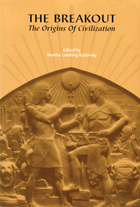 The Breakout: The Origins of Civilization
Martha Lamberg-Karlovsky
Harvard University Press, 2000 For much of the twentieth century, Mesopotamia was thought to he the singular “Cradle of Civilization,” and the agents of change that brought it about were thought to be demographic, ecological, and technological. Bronze Age Mesopotamian accomplishments were believed to have diffused outward, influencing the development of civilization in the rest of the world. Part of this Mesopocentric view was revised as archaeological evidence revealed that other unique civilizations had existed in both the Old and New Worlds, but the traditional Near Eastern pattern of development continued to serve as a model.
In the mid-1980s, however, Harvard’s Kwang-chih Chang proposed in Symbols—a publication of Harvard’s Peabody Museum and Department of Anthropology—that China’s first civilization did not evolve according to the conventional Mesopotamian model and argued instead for a new paradigm for understanding the origins of civilization in ancient China and the New World.
In this collection of subsequent Symbols articles and other essays, Maya and Near Eastern studies specialists engage in a stimulating debate of Chang’s thesis, also presented here.
 Breaks in the Air: The Birth of Rap Radio in New York City
John Klaess
Duke University Press, 2022 In Breaks in the Air John Klaess tells the story of rap’s emergence on New York City’s airwaves by examining how artists and broadcasters adapted hip hop’s performance culture to radio. Initially, artists and DJs brought their live practice to radio by buying time on low-bandwidth community stations and building new communities around their shows. Later, stations owned by New York’s African American elite, such as WBLS, reluctantly began airing rap even as they pursued a sound rooted in respectability, urban sophistication, and polish. At the same time, large commercial stations like WRKS programmed rap once it became clear that the music attracted a demographic that was valuable to advertisers. Moving between intimate portraits of single radio shows and broader examinations of the legal, financial, cultural, and political forces that indelibly shaped the sound of rap radio, Klaess shows how early rap radio provides a lens through which to better understand the development of rap music as well as the intertwined histories of sounds, institutions, communities, and legal formations that converged in the post-Civil Rights era.
 Breaks in the Chain: What Immigrant Workers Can Teach America about Democracy
Paul Apostolidis
University of Minnesota Press, 2010 In Breaks in the Chain, Paul Apostolidis investigates the personal life stories of a group of Mexican immigrant meatpackers who are at once typical and extraordinary. After crossing the border clandestinely and navigating the treacherous world of the undocumented, they waged a campaign to democratize their union and their workplace in the most hazardous industry in the United States.
Breaks in the Chain shows how immigrant workers-individually and sometimes collectively-both reinforce and contest a tacit but lethal form of biopolitics that differentiates the life chances of racial groups. Examining their personal narratives, Apostolidis recasts our understanding of the ways immigrants construct and transform social power.
Apostolidis uses empirical inquiry to spark new reflections in critical theory as he analyzes how immigrant workers' local practices confront structural power within and beyond America's borders. Linking stories of immigration to stories about working on the meat production line-the chain-he reveals the surprising power of activism by immigrant workers and their allies and demonstrates how it can-and should-promote social and political democracy in America.
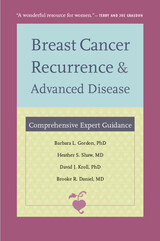 Breast Cancer Recurrence and Advanced Disease: Comprehensive Expert Guidance
Barbara L. Gordon, Heather S. Shaw, David J. Kroll, and Brooke R. Daniel
Duke University Press, 2010 At age 42, Barbara L. Gordon was diagnosed with Stage II breast cancer. Two years later, it appeared that the cancer had metastasized. Along with her oncologist and other experts, Gordon has written the book that she wished she had as she faced late-stage breast cancer and the prospect of dying from the disease. Filled with information and advice, and designed to enable informed decisions and improved quality of life, this comprehensive guide gathers in one place authoritative medical information about recurrence and late-stage breast cancer, and it addresses the practical, emotional, spiritual, and interpersonal aspects of dying and death. This indispensable book aids those diagnosed with recurrent or late-stage breast cancer, those wanting to reduce the chance of a recurrence, and those with other types of late-stage cancer. It is also a valuable resource for healthcare professionals, friends, and family members. Topics covered include • Types of recurrence, their symptoms, and ways of minimizing the chance of a recurrence
• Diagnostic tests, potential surgeries, and treatments to manage late-stage cancer
• Getting the best care, evaluating complementary therapies, and alleviating pain and depression
• Cessation of treatment and what one may experience as the disease progresses
• End-of-life issues including dealing with financial and legal matters, communicating with loved ones and hospice workers, and planning memorial services Breast Cancer Recurrence and Advanced Disease includes a glossary of medical terms, appendices on nutrition and integrative health centers, and links to current Web sites addressing matters such as clinical trials, patients’ rights, and medical expenses.
 Breathe Easy: Relieving the Symptoms of Chronic Lung Disease
Donald A. Mahler
University Press of New England, 2017 Most people don’t think about breathing; it is an automatic, unconscious act. However, the majority of those with asthma (26 million Americans); chronic obstructive pulmonary disease, or COPD (24 million Americans); or interstitial lung disease (1–2 million Americans) are aware of their shortness of breath because it interferes with work or other daily activities. As a result, these individuals seek medical attention for diagnosis and treatment. Breathe Easy, written by a pulmonologist, explains what constitutes normal breathing, what causes someone to feel short of breath, and what can be done to improve one’s breathing. In chapters on asthma, COPD, and interstitial lung disease, Dr. Donald A. Mahler addresses the origins and treatments of these conditions, and offers advice for both standard and alternative therapies to breathe easy. Other chapters describe how we breathe, how to understand respiratory difficulties like chronic shortness of breath, the correct use of inhalers, the effects of aging on the brain and body, and the benefits of exercise. His final chapter provides valuable advice about traveling with oxygen. Illustrated with over fifty enlightening medical graphics, Breathe Easy offers a complete and compact guide for the millions of Americans who are limited by their breathing.
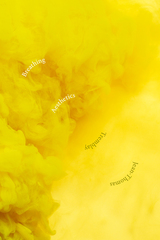 Breathing Aesthetics
Jean-Thomas Tremblay
Duke University Press, 2022 In Breathing Aesthetics Jean-Thomas Tremblay argues that difficult breathing indexes the uneven distribution of risk in a contemporary era marked by the increasing contamination, weaponization, and monetization of air. Tremblay shows how biopolitical and necropolitical forces tied to the continuation of extractive capitalism, imperialism, and structural racism are embodied and experienced through respiration. They identify responses to the crisis in breathing in aesthetic practices ranging from the film work of Cuban American artist Ana Mendieta to the disability diaries of Bob Flanagan, to the Black queer speculative fiction of Renee Gladman. In readings of these and other minoritarian works of experimental film, endurance performance, ecopoetics, and cinema-vérité, Tremblay contends that articulations of survival now depend on the management and dispersal of respiratory hazards. In so doing, they reveal how an aesthetic attention to breathing generates historically, culturally, and environmentally situated tactics and strategies for living under precarity.
Breathing Between the Lines: Poems
Demetria Martínez
University of Arizona Press, 1997 Demetria Martínez has entered the public consciousness by way of the heart. In 1994, she captured a Western States Book Award with her first novel, Mother Tongue, which went on to win widespread national attention. Now, in Breathing between the Lines, the writer returns to poetry, her first love. Many of the poems in this book touch on the themes from Mother Tongue, about an American activist who falls in love with a Salvadoran political refugee.
Weaving together threads of love and family, social conviction and activism, loss and renewal, Breathing between the Lines carries the reader deep inside the head and heart of a talented Chicana writer. Page by page, the journey is an exhilarating one. What we find at the end is up to us.
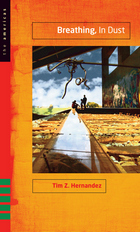 Breathing, In Dust
Tim Z. Hernandez
Texas Tech University Press, 2010 Deep within California’s golden agricultural heartland lies a rotten core: the fictional farming community of Catela, where the desperate realities of poverty, drug abuse, violence, and bigotry play out in the lives of cucarachas and coyotes, tweekers and strippers, wetbacks and white trash. Seventeen-year-old Tlaloc, namesake of the Aztec god of fertility and destruction, has grown up among the migrant-worker communities that follow the seasons from Wyoming’s beet fields to the vineyards and packinghouses of the Central Valley. Bearing witness to a gritty landscape of wrenching contrasts, Loc narrates the bitter desires and crushed hopes of his friends and family: his father’s absence and his grandparents’ deaths, Zeta’s reckless abandon, Arturín’s path to prison, Norma’s tragic alienation, the farmworkers’ final tributes to Cesar Chavez, Talina’s choices and compromises. Even so he dares to dream, sensing that somewhere within the cruel beauty that surrounds him may lie his own redemption. Tim Z. Hernandez’s land of pain and plenty, his Catela, evokes the essence of the migrant underclass experience. But more, his stories take us there, into the streets and into the groves, into the back rooms of the carnicerias and the panaderias, onto the tracks, onto the thirsty highways, in scenes that unfold with graphic, breathtaking honesty.
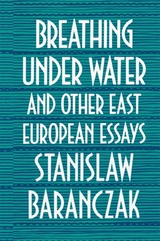 Breathing under Water and Other East European Essays
Stanislaw Baranczak
Harvard University Press, 1990 Stanislaw Baranczak, a Polish writer in exile, turns to his colleagues and their plights, in Poland, Czechoslovakia, Hungary, and the Soviet Union, to explain why oppressive regimes could not succeed in their attempts to transform the Eastern European into Homo sovieticus.
These superb essays focus on the role that culture, and particularly literature, has played in keeping the spirit of intellectual independence alive in Eastern and Central Europe. Exploring a variety of issues from censorship to underground poetry, Baranczak shows why, in societies where people struggle to survive under totalitarian rule, art is believed to have the power to make things happen.
He brings into sharp relief the works and personalities of many legendary figures of recent Eastern European political and cultural history from Lech Walesa and Pope John Paul II to Václav Havel and Adam Michnik to Czeslaw Milosz, Witold Gombrowicz, Bruno Schulz, and Joseph Brodsky--and makes vivid the context from which they spring. Some of the essays probe the sense of inarticulateness experienced by writers in exile; many represent the literary essay at its best; all reveal that Baranczak is a sophisticated, often savagely funny writer on whom nothing is lost.
This refreshing and provocative book guides us toward a clearer understanding of what has led to the present moment, in which the nations of Eastern and Central Europe, tired of striving to "breathe under water," are finally "coming up for air." It is rewarding reading for anyone interested in art's confrontation with an intractable political reality--wherever it occurs in the world.
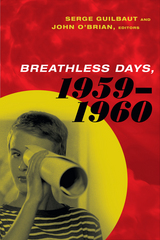 Breathless Days, 1959-1960
Serge Guilbaut and John O'Brien, editors
Duke University Press, 2017 Taking 1959–1960 as a pivotal cultural and political moment, the contributors to Breathless Days reframe postwar Western art history, examining the aesthetic and ideological alliances and tensions in art throughout Western Europe and the Americas. The collection provides a heterogeneous account of the intersections of the fine art world with literature, jazz, film, and theater in New York, Paris, Milan, Brazil, and Cuba. This reveals the knotty and multilayered connections among these divergent artistic milieus. Whether discussing Duchamp’s With My Tongue in My Cheek, Brazilian abstraction, postrevolutionary Cuban art, Jean Tinguely’s self-destroying machines, or Burroughs’s Naked Lunch, the contributors show this brief period to be a key to the cultural and political development of Western Europe and the Americas during the Cold War. Contributors. Carla Benzan, Clint Burnham, Jill Carrick, Eric de Chassey, Mari Dumett, Serge Guilbaut, Luc Lang, Hadrien Laroche, Aleca Le Blanc, Richard Leeman, Tom McDonough, Regis Michel, John O'Brian, Kjetil Rodje, Ludovic Tournès, Antonio Eligio (Tonel)
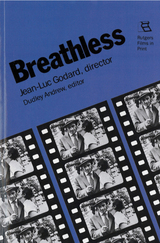 Breathless: Jean-Luc Godard, Director
Dudley Andrew
Rutgers University Press, 1988 Breathless, a low-budget film, came to be regarded as one of the major accomplishments of the French New Wave cinema of the early sixties. It had a tremendous influence on French filmmakers and on world cinema in general. Beyond its significance in film history, it was also a film of considerable cultural impact. In Breathless, Jean-Luc Godard captured the spirit of a disillusioned generation and fashioned a style, which drew on the past, to parade that disillusionment.
In his introduction, Dudley Andrew brilliantly explains what Godard set out to accomplish in Breathless. He illuminates the intertextual and cultural references of the film and the tensions within it between tradition and innovation. This volume also features, for the first time in English, the complete and accurate continuity script of Breathless, together with Francois Truffaut's surprisingly detailed original treatment. Also included are an in-depth selection of reviews and criticism in French and English; a brief biographical sketch of the director's life that covers the development of his career, as well as a filmography and selected bibliography.
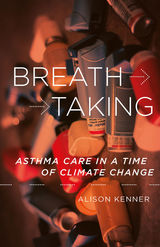 Breathtaking: Asthma Care in a Time of Climate Change
Alison Kenner
University of Minnesota Press, 2018 Analyzing asthma care in the twenty-first century Asthma is not a new problem, but today the disease is being reshaped by changing ecologies, healthcare systems, medical sciences, and built environments. A global epidemic, asthma (and our efforts to control it) demands an analysis attentive to its complexity, its contextual nature, and the care practices that emerge from both. At once clearly written and theoretically insightful, Breathtaking provides a sweeping ethnographic account of asthma’s many dimensions through the lived experiences of people who suffer from disordered breathing, as well as by considering their support networks, from secondary school teachers and coaches, to breathing educators and new smartphone applications designed for asthma control. Against the backdrop of unbreathable environments, Alison Kenner describes five modes of care that illustrate how asthma is addressed across different sociocultural scales. These modes of care often work in combination, building from or preceding one another. Tensions also exist between them, a point reflected by Kenner’s description of the structural conditions and material rhythms that shape everyday breathing, chronic disease, and our surrounding environments. She argues that new modes of distributed, collective care practices are needed to address asthma as a critical public health issue in the time of climate change.
 Brecht in L.A.
Rick Mitchell
Intellect Books, 1995 Bertolt Brecht, perhaps the most important dramatist/director/theorist of the twentieth century, is still widely studied and his plays and theories remain staples in the curricula of university theatre departments, literature departments, and theatre-artist training programs throughout the world. Additionally, productions of Brecht's dramas continue to be popular. The play Brecht in L.A. focuses on Brecht's life in America, where he resided from 1941 through 1947.
Additionally, Brecht in L.A., winner of the 2002 SWTA National New Play Contest (US), is already a critically acclaimed play, which suggests that the work has the potential to be widely (and successfully) produced. And such productions will enhance the marketability of the book. A play influenced by Brecht is, in itself, not unique, since many leading, contemporary dramatists--such as Caryl Churchill, Edward Bond, Tony Kushner, Heiner Muller, and Howard Barker--have been affected by Brechtian dramaturgy. But a Brechtian-influenced play with Brecht as the lead character is unique. The play represents the only dramatic work in English which features Brecht himself as the title character.
Brecht in L.A., centering on Brecht while adapting/critiquing Brechtian dramatic form, also provides a unique opportunity for the instructor who is teaching Brechtian theatre since--with just one text (which will includes endnotes and appendices)--the instructor can cover epic theatre, the "Brecht debate," Brecht's biography, and contradictions between Brecht's theatrical practices and his everyday life.
The book's wide-ranging audience will include theatre artists; playgoers; students of drama, theatre, English, and performance studies; scholars; and readers interested in Brecht, Hollywood, and/or biography. Brecht in L.A. will also be an important addition to the considerable collections of books about Brecht which are carried by countless libraries.
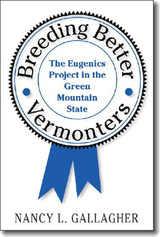 Breeding Better Vermonters: The Eugenics Project in the Green Mountain State
Nancy L. Gallagher
Brandeis University Press, 1999 Eugenics -- the study of human racial progress through selective breeding -- frequently invokes images of social engineering, virulent racism, immigrant persecution, and Nazi genocide, but Vermont's little known adventure in eugenics shows the inherent adaptability of eugenics theory and methods to parochial social justice. Beginning with genealogies of Vermont's rural poor in the 1920s, and concluding in the 1930s with an exposé of ethnic prejudice in Vermont's largest city, this story of the Eugenics Survey of Vermont explores the scope, limits, and changing interpretations of eugenics in America and offers a new approach to the history of progressive politics and social reform in New England. Inspired and directed by Zoology Professor Henry F. Perkins, the survey, through social research, political agitation, and education campaigns, infused eugenic agendas into progressive programs for child welfare, mental health, and rural community development. Breeding Better Vermonters examines social, ethnic, and religious tensions and reveals how population studies, theories of human heredity, and a rhetoric of altruism became subtle, yet powerful tools of social control and exclusion in a state whose motto was "freedom and unity."
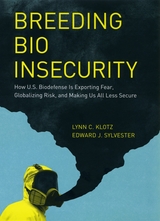 Breeding Bio Insecurity: How U.S. Biodefense Is Exporting Fear, Globalizing Risk, and Making Us All Less Secure
Lynn C. Klotz and Edward J. Sylvester
University of Chicago Press, 2009 In the years since the 9/11 attacks—and the subsequent lethal anthrax letters—the United States has spent billions of dollars on measures to defend the population against the threat of biological weapons. But as Lynn C. Klotz and Edward J. Sylvester argue forcefully in Breeding Bio Insecurity, all that money and effort hasn’t made us any safer—in fact, it has made us more vulnerable.
Breeding Bio Insecurity reveals the mistakes made to this point and lays out the necessary steps to set us on the path toward true biosecurity. The fundamental problem with the current approach, according to the authors, is the danger caused by the sheer size and secrecy of our biodefense effort. Thousands of scientists spread throughout hundreds of locations are now working with lethal bioweapons agents—but their inability to make their work public causes suspicion among our enemies and allies alike, even as the enormous number of laboratories greatly multiplies the inherent risk of deadly accidents or theft. Meanwhile, vital public health needs go unmet because of this new biodefense focus. True biosecurity, the authors argue, will require a multipronged effort based in an understanding of the complexity of the issue, guided by scientific ethics, and watched over by a vigilant citizenry attentive to the difference between fear mongering and true analysis of risk.
An impassioned warning that never loses sight of political and scientific reality, Breeding Bio Insecurity is a crucial first step toward meeting the evolving threats of the twenty-first century.
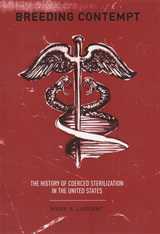 Breeding Contempt: The History of Coerced Sterilization in the United States
Mark A. Largent
Rutgers University Press, 2007 Most closely associated with the Nazis and World War II atrocities, eugenics is sometimes described as a government-orchestrated breeding program, other times as a pseudo-science, and often as the first step leading to genocide. Less frequently it is recognized as a movement having links to theUnited States. But eugenics does have a history in this country, and Mark A. Largent tells that story by exploring one of its most disturbing aspects, the compulsory sterilization of more than 64,000 Americans.
The book begins in the mid-nineteenth century, when American medical doctors began advocating the sterilization of citizens they deemed degenerate. By the turn of the twentieth century, physicians, biologists, and social scientists championed the cause, and lawmakers in two-thirds of the United States enacted laws that required the sterilization of various criminals, mental health patients, epileptics, and syphilitics. The movement lasted well into the latter half of the century, and Largent shows how even today the sentiments that motivated coerced sterilization persist as certain public figures advocate compulsory birth control—such as progesterone shots for male criminals or female welfare recipients—based on the same assumptions and motivations that had brought about thousands of coerced sterilizations decades ago.
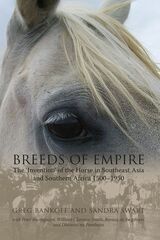 Breeds of Empire: The Invention of the Horse in Southeast Asia and Southern Africa 1500-1950
Edited by Greg Bankoff and Sandra Swart
National University of Singapore Press, 2007 Ships of empire carried not just merchandise, soldiers and administrators but also equine genes from as far afield as Europe, Arabia, the Americas, China and Japan. In the process, they introduced horses into parts of the world not native to that animal in historical times. As a result, horses in Thailand, the Philippine Horses, the Cape Horse in South Africa and the Basotho Pony in the mountain kingdom of Lesotho share a genetic lineage with the horse found in the Indonesian archipelago.This book explores the 'invention' of specific breeds of horse in the context of imperial design and colonial trade routes. Here, it focuses on the introduction, invention and use of the horse in Thailand, the Philippines and southern Africa as well as examining its roots and evolution within Indonesia. In addition, it examines the colonial trade in horses within the Indian Ocean and discusses the historiographical and methodological problems associated with writing a more species- or horse-centric history. This is a fascinating study that will appeal not only to scholars but also to the broad horse-reading public interested in all things equine.
Breeze
John Latta
University of Notre Dame Press, 2002 Breeze, winner of the 2003 Ernest Sandeen Prize in Poetry, exudes a material and musical sensibility, informed as much by the sound of a word as it rolls off the tongue as by the ideas it may trigger. In these carefully crafted poems, John Latta traces the process of language attempting to align its measure against the amplitude of the world. His writing recognizes the futility of representing the world while braving the caprice of trying to do so. Made of image, invention, and music, the poetry of Breeze challenges and inspires.
Brenda Is in the Room and Other Poems
Craig Morgan Teicher
University Press of Colorado, 2007 Winner of the 2007 Colorado Prize for Poetry
Published by the Center for Literary Publishing at Colorado State University
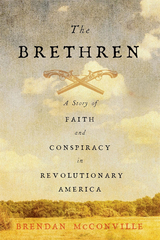 The Brethren: A Story of Faith and Conspiracy in Revolutionary America
Brendan McConville
Harvard University Press, 2021 The dramatic account of a Revolutionary-era conspiracy in which a band of farmers opposed to military conscription and fearful of religious persecution plotted to kill the governor of North Carolina.
Less than a year into the American Revolution, a group of North Carolina farmers hatched a plot to assassinate the colony’s leading patriots, including the governor. The scheme became known as the Gourd Patch or Lewellen Conspiracy. The men called themselves the Brethren.
The Brethren opposed patriot leaders’ demand for militia volunteers and worried that “enlightened” deist principles would be enshrined in the state constitution, displacing their Protestant faith. The patriots’ attempts to ally with Catholic France only exacerbated the Brethren’s fears of looming heresy. Brendan McConville follows the Brethren as they draw up plans for violent action. After patriot militiamen threatened to arrest the Brethren as British sympathizers in the summer of 1777, the group tried to spread false rumors of a slave insurrection in hopes of winning loyalist support. But a disaffected insider denounced the movement to the authorities, and many members were put on trial. Drawing on contemporary depositions and legal petitions, McConville gives voice to the conspirators’ motivations, which make clear that the Brethren did not back the Crown but saw the patriots as a grave threat to their religion.
Part of a broader Southern movement of conscription resistance, the conspiracy compels us to appreciate the full complexity of public opinion surrounding the Revolution. Many colonists were neither loyalists nor patriots and came to see the Revolutionary government as coercive. The Brethren tells the dramatic story of ordinary people who came to fear that their Revolutionary leaders were trying to undermine religious freedom and individual liberty—the very causes now ascribed to the Founding generation.
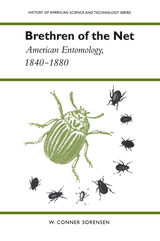 Brethren of the Net: American Entomology, 1840-1880
W. Conner Sorensen
University of Alabama Press, 1995 Draws together information from diverse sources to illuminate an important chapter in the history of American science
Sorensen asks how it came about that, within the span of forty years, the American entomological community developed from a few gentlemen naturalists with primary links to Europe to a thriving scientific community exercising world leadership in entomological science. He investigates the relationship between American and European entomology, the background of American entomologists, the implications of entomological theory, and the specific links between 19th-century American society and the rapid institutional growth and advances in theoretical and applied entomology.
By the 1880s the entomologists constituted the largest single group of American zoologists and the largest group of ecologists in the world. While rooted in the British natural history tradition, these individuals developed a distinctive American style of entomological investigation. Inspired by the concept of the balance of nature, they excelled in field investigations of North American insects with special emphasis on insect pests that threatened crop production in a market-oriented agriculture. During this period, entomologists described over ten times as many North American insect species as had been previously named, and they consolidated their findings in definitive collections. Employing evolutionary theory, they contributed to the growing understanding of insect migration, mimicry, seasonal dimorphism, and the symbiotic relationship of plant and animal species. Americans also led in the revision of insect taxonomy according to the new principles. Their employment of entomological findings in the practical control of agricultural pests set new standards worldwide. Initially ridiculed as eccentric bug hunters, American entomologists eventually achieved stature as agricultural advisers and as investigators into the origin and nature of life.
Based primarily on the correspondence of American entomologists, Brethren of the Net draws together information from diverse sources to illuminate an important chapter in the history of American science.
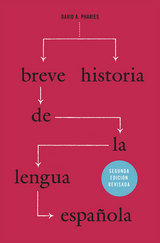 Breve historia de la lengua española: Segunda edición revisada
David A. Pharies
University of Chicago Press, 2015 Publicada inicialmente en 2007, esta Breve historia de la lengua española se ha convertido en la introducción más difundida a una de las lenguas más importantes del mundo por la extensión de su dominio y el número de hablantes. Este libro ofrece al lector un relato conciso que se propone profundizar en la evolución de la lengua desde sus raíces latinas hasta el presente, prestando especial atención a los cambios históricos y culturales que contribuyeron a su evolución y propagación por el mundo.
La Breve historia de la lengua española se concentra en los cambios más importantes de la evolución de la lengua, evitando la jerga académica ininteligible y favoreciendo la claridad en las explicaciones. Por el camino, intenta dar respuesta a muchas de las preguntas que con frecuencia desconciertan a los hablantes nativos y no nativos: ¿Por qué se utiliza tú en algunos lugares y vos en otros? ¿Cómo surgió la pronunciación como fricativa interdental de la zeta castellana? ¿Por qué se dice la mesa pero el agua con un artículo que parece masculino?
David A. Pharies es un experto en el estudio de la historia y evolución del español, que goza de un reconocido prestigio en la escena internacional. Para actualizar esta segunda edición ha revisado en profundidad todos los aspectos de la evolución del español, incluido su desarrollo demográfico. El libro va dirigido a quienes tienen un conocimiento básico del español y desean aprender más sobre sus orígenes. También constituye una base ideal para emprender el estudio de cualquier aspecto de la lingüística histórica española y de la literatura medieval. Entretenida y accesible, la Breve historia de la lengua española es un gran viaje de descubrimiento en una presentación amena y sucinta.
Since its publication in 2007, A Brief History of the Spanish Language has become the leading introduction to the history of one of the world’s most widely spoken languages. Moving from the language’s Latin roots to its present-day forms, this concise book offers readers insights into the origin and evolution of Spanish, the historical and cultural changes that shaped it, and its spread around the world.
A Brief History of the Spanish Language focuses on the most important aspects of the development of the Spanish language, eschewing technical jargon in favor of straightforward explanations. Along the way, it answers many of the common questions that puzzle native and nonnative speakers alike, such as: Why do some regions use tú while others use vos? How did the th sound develop in Castilian? And why is it la mesa but el agua?
David A. Pharies, an internationally recognized expert on the history and development of Spanish, has updated this edition with new research on all aspects of the evolution of Spanish while adding current demographic information as well. This book is perfect for anyone with a basic understanding of Spanish and a desire to further explore its roots. It also provides an ideal foundation for further study in any area of historical Spanish linguistics and early Spanish literature. Both absorbing and accessible, A Brief History of the Spanish Language is a grand journey of discovery in a beautifully compact format.
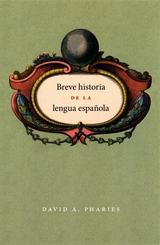 Breve historia de la lengua española: Spanish edition
David A. Pharies
University of Chicago Press, 2007 El español es la cuarta lengua más hablada en el mundo y el idioma de una cada vez mayor importancia en los Estados Unidos de América. En lo que esperábamos resultara la introducción a la historia de la lengua española, David Pharies, clara y conscientemente, trazó la evolución del español desde sus raíces indo-europeas hasta su estado actual. Un reconocido experto internacional en la historia y el desarrollo de esta lengua, Pharies presenta sobre este tema un sentido preciso de lo que los estudiantes de español necesitan saber.
Después de los capítulos introductorios de lo que significa el estudio de la historia de una lengua, el concepto del cambio lingüístico y de la naturaleza de las familias lingüísticas, Pharies hace un seguimiento al desarrollo del español desde sus raíces latinas, todo ello con una mínima cantidad de lenguaje técnico posible. En las secciones centrales del libro, los lectores son llevados por una presentación sucinta, comprometedora y admirable, de la genealogía y desarrollo de la lengua incluyendo explicaciones de las estructuras y peculiaridades del latín, los eventos históricos y culturales que influenciaron profundamente la forma del lenguaje, la naturaleza del español medieval, los mitos lingüísticos formando parte del español y el desarrollo de la lengua más allá de la península ibérica, en particular, en el continente americano. Centrándose en las más importantes facetas de la evolución de la lengua, esta obra concisa hace que la historia del español sea accesible a todos, con una comprensión del mismo y una disposición para entender los conceptos básicos del lenguaje.
Disponible en ambas ediciones, inglés y español, Una Breve Historia de la Lengua Española, nos brinda una extraordinaria introducción a la fascinante historia de una de las más importantes lenguas del mundo.
Spanish is the fourth most widely spoken language in the world and a language of ever-increasing importance in the United States. In what will likely become the introduction to the history of the Spanish language, David Pharies clearly and concisely charts the evolution of Spanish from its Indo-European roots to its present form. An internationally recognized expert on the history and development of this language, Pharies brings to his subject a precise sense of what students of Spanish linguistics need to know.
After introductory chapters on what it means to study the history of a language, the concept of linguistic change, and the nature of language families, Pharies traces the development of Spanish from its Latin roots, all with the minimum amount of technical language possible. In the core sections of the book, readers are treated to an engaging and remarkably succinct presentation of the genealogy and development of the language, including accounts of the structures and peculiarities of Latin, the historical and cultural events that deeply influenced the shaping of the language, the nature of Medieval Spanish, the language myths that have become attached to Spanish, and the development of the language beyond the Iberian Peninsula, especially in the Americas. Focusing on the most important facets of the language’s evolution, this compact work makes the history of Spanish accessible to anyone with a knowledge of Spanish and a readiness to grasp basic linguistic concepts.
Available in both English and Spanish editions, A Brief History of the Spanish Language provides a truly outstanding introduction to the exciting story of one of the world’s great languages.
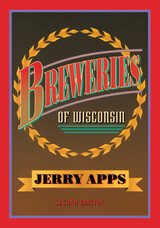 Breweries of Wisconsin
Jerry Apps
University of Wisconsin Press, 2005 The story of the Dairy State’s other major industry—beer! From the immigrants who started brewing here during territorial days to the modern industrial giants, this is the history, the folklore, the architecture, the advertising, and the characters that made Wisconsin the nation’s brewing leader. Updated with the latest trends on the Wisconsin brewing scene. "Apps adeptly combines diligent scholarship with fascinating anecdotes, vividly portraying brewmasters, beer barons, saloonkeepers, and corporate raiders. All this plus color reproductions of popular beer labels and a detailed recipe for home brew."—Wisconsin Magazine of History
"In a highly readable style Apps links together ethnic influence, agriculture, geography, natural resources, meteorology, changing technology, and transportation to explore some of the mystique, romance and folklore associated with beer from antiquity to the present day in Wisconsin."—The Brewers Bulletin
 Brewing Arizona: A Century of Beer in the Grand Canyon State
Ed Sipos
University of Arizona Press, 2013 “Sergeant… there is a brewery here!” shouted Private Lutje into the tent of his commanding officer. His regiment had just set up camp outside of Tucson. It was spring. The year was 1866. And the good private had reason to be shocked. How could anyone brew beer in the desert? The water was alkaline (when it was fit to drink at all), grains were scarce, bottles were in short supply, and refrigeration was nearly non-existent. But human ingenuity cannot be overestimated, especially when it comes to creating alcoholic beverages.
Since 1864, the state’s breweries have had a history as colorful as the state. With an eye like a historian, the good taste of a connoisseur, and the tenacity of a dedicated collector, author Ed Sipos serves up beer history with gusto. Brewing Arizona is the first book of Arizona beer. It includes every brewery known to have operated in the state, from the first to the latest, from crude brews to craft brews, from mass beer to microbrews. This eye-opening chronicle is encyclopedic in scope but smooth in its delivery. Like a fine beer, the contents are deep and rich, with a little froth on top.
With more than 250 photographs—200 in full color—Brewing Arizona is as beautiful as it is tasty. So put up your feet, grab a cold one, and sip to your heart’s delight.
Brewing Science, Technology and Print, 1700-1880
Sumner, James
University of Pittsburgh Press, 2013 How did the brewing of beer become a scientific process? Sumner explores this question by charting the theory and practice of the trade in Britain and Ireland during the eighteenth and nineteenth centuries.
From an oral culture derived from home-based skills, brewing industrialized rapidly and developed an extensive trade literature, based increasingly on the authority of chemical experiment. The role of taxation is also examined, and the emergence of brewing as a profession is set within its social and technical context.
Brewster Buffalo
Nico Braas
Amsterdam University Press, 2023 One of the lesser-known fighter aircraft of World War II was the Brewster Buffalo, or, using the U.S. Navy designation system, the F2A. By some historians the Buffalo is regarded as an outright failure, but this is a rating this stubby little fighter did not deserve.
This book presents an overview of the development and operational use of the Buffalo with many photos including a number not published before.
 Brewtown Tales: More Stories from Milwaukee and Beyond
John Gurda
Wisconsin Historical Society Press, 2022 John Gurda’s South Side Milwaukee family loved potluck dinners. “From the Jell-O salads at the start of the line through the hot dishes in the middle and on to the pumpkin bars at the end, the food was always hearty, abundant, and certifiably homemade,” he writes. Drawing from Gurda’s long-running Sunday Milwaukee Journal Sentinel column, Brewtown Tales was prepared in the spirit of those fondly remembered meals. The main dish is Milwaukee history, served in a multitude of ways. You will find in these pages the biography of a bridge, a requiem for a union, tales of two shipwrecks, a frank take on segregation, and memories of the summer of ’68, among many other things. There are also side dishes that convey the distinctive flavors of Wisconsin and a few more exotic places, from Vilas County to Vietnam. Brewtown Tales will satisfy your hunger, introduce you to new and unexpected tastes, and whet your appetite for more homemade history.
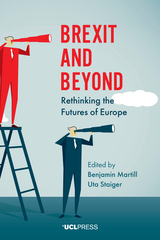 Brexit and Beyond: Rethinking the Futures of Europe
Edited by Benjamin Martill and Uta Staiger
University College London, 2018 Brexit bears serious consequences not just for Britain but for Europe and the broader balance of global order. Yet most discussions of Brexit have focused on the causes of the “Leave” vote and its implications for the future of British politics.
Drawing the discussion of Brexit beyond Britain, Benjamin Martill, Uta Staiger, and a team of twenty-eight contributors explore the consequences for Europe and the European Union. Marshaling the perspectives and methodologies of a diverse range of disciplines, the contributors chart the likely effects of Brexit on institutional relations, law, political economy, foreign affairs, democratic governance, and the idea of Europe itself. While the contributors at times offer divergent predictions for the future of Europe after Brexit, they share the conviction that careful analysis is in needed—now more than ever—if we are to understand what lies ahead.
Brexit and Beyond is the first book to focus on the broader consequences of Brexit, and its clear, comprehensive, and trenchant analysis will be invaluable to understanding the complex effects.
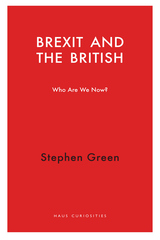 Brexit and the British: Who Do We Think We Are?
Stephen Green
Haus Publishing, 2017 Whatever the eventual outcome of Britain’s negotiations to leave the European Union, the critical questions remain: what does the Referendum vote tell us about British society? As with the election of Donald Trump in the United States, why did so few people in Britain see the result coming? Why was there such a fundamental misunderstanding about divisions in society that had existed for years?
In this short but powerful book, Stephen Green argues that it is time to acknowledge that underlying all the sound and fury of the Brexit debate were fundamental questions—whether or not fully recognized—about British identity. Are the British different, special, and capable of finding their own way in the world? Who are they, those who call themselves British? Is it all too easy to blame Brexit on post-industrial decline in the traditional heartlands of the Labor Party, or scaremongering by a band of deluded “Little Englanders”? Or is British identity more complex, deep-rooted—and perhaps, in some sense, troubling—than those of other European nations?
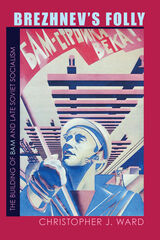 Brezhnev's Folly: The Building of BAM and Late Soviet Socialism
Christopher J. Ward
University of Pittsburgh Press, 2009
Heralded by Soviet propaganda as the “Path to the Future,” the Baikal-Amur Mainline Railway (BAM) represented the hopes and dreams of Brezhnev and the Communist Party elite of the late Soviet era. Begun in 1974, and spanning approximately 2,000 miles after twenty-nine years of halting construction, the BAM project was intended to showcase the national unity, determination, skill, technology, and industrial might that Soviet socialism claimed to embody. More pragmatically, the Soviet leadership envisioned the BAM railway as a trade route to the Pacific, where markets for Soviet timber and petroleum would open up, and as an engine for the development of Siberia.
Despite these aspirations and the massive commitment of economic resources on its behalf, BAM proved to be a boondoggle-a symbol of late communism's dysfunctionality-and a cruel joke to many ordinary Soviet citizens. In reality, BAM was woefully bereft of quality materials and construction, and victimized by poor planning and an inferior workforce. Today, the railway is fully complete, but remains a symbol of the profligate spending and inefficiency that characterized the Brezhnev years.
In Brezhnev's Folly, Christopher J. Ward provides a groundbreaking social history of the BAM railway project. He examines the recruitment of hundreds of thousands of workers from the diverse republics of the USSR and other socialist countries, and his extensive archival research and interviews with numerous project workers provide an inside look at the daily life of the BAM workforce. We see firsthand the disorganization, empty promises, dire living and working conditions, environmental damage, and acts of crime, segregation, and discrimination that constituted daily life during the project's construction. Thus, perhaps, we also see the final irony of BAM: that the most lasting legacy of this misguided effort to build Soviet socialism is to shed historical light on the profound ills afflicting a society in terminal decline.
Brian Ferneyhough
Lois Fitch
Intellect Books, 2013 One of contemporary music’s most significant and controversial figures, Brian Ferneyhough’s complex and challenging music draws inspiration from painting, literature, and philosophy, as well as music from the recent and distant past. His dense, multilayered compositions intrigue musicians while pushing both performer and instrument to the limits of their abilities. A wide-ranging survey of his life and work to date, Brian Ferneyhough examines the critical issues fundamental to understanding the composer as a musician and a thinker. Debuting in celebration of Ferneyhough’s seventieth birthday in 2013, this book strikes a rich balance between critical analysis of the music and close scrutiny of its aesthetic and philosophical contexts, making possible a more rounded view of the composer than has been available.
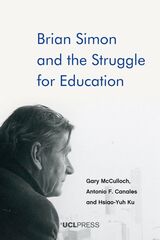 Brian Simon and the Struggle for Education
Gary McCulloch, Antonio Canales, and Hsiao-Yuh Ku
University College London, 2023 The first full-length study of the life and career of Brian Simon (1915–2002), a leading Marxist intellectual and historian of education in twentieth-century Britain.
Using documentary sources that have only recently become publicly available, this book reveals the remarkably broad range of Brian Simon’s life as a student, soldier, schoolteacher, Communist Party activist, educational academic, campaigner, and reformer. In a sympathetic biography that retains critical distance, the authors analyze Simon’s contribution to Marxism and the Communist Party, explore the influence of both on his work as a historian of education, and trace the significance of his Marxist beliefs, political associations, and historical approaches to the cause of educational reform.
In so doing, they consider the full nature and limitations of Simon’s achievements in his struggle for education. Unlike many Marxist scholars, he remained loyal to the Communist Party in the 1950s, which damaged his reputation as a public intellectual. Nevertheless, his support for comprehensive education helped to promote egalitarian educational reforms in Britain, although he was later unable to provide sufficient resistance to the 1988 Education Reform Act and to a decline in the position of comprehensive schools.
In all this, the significance of Simon’s family, and especially his relationship with his wife Joan, is brought to the fore. Joan and Brian forged a formidable sixty-year partnership in politics and the Communist Party as well as in life, a partnership that lasted until Brian’s death in January 2002.
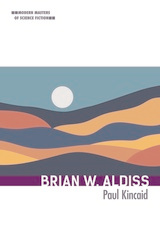 Brian W. Aldiss
Paul Kincaid
University of Illinois Press, 2022 Brian W. Aldiss wrote classic science fiction novels like Report on Probability A and Hothouse. Billion Year Spree, his groundbreaking study of the field, defined the very meaning of SF and delineated its history. Yet Aldiss’s discomfort with being a guiding spirit of the British New Wave and his pursuit of mainstream success characterized a lifelong ambivalence toward the genre. Paul Kincaid explores the many contradictions that underlay the distinctive qualities of Aldiss’s writing. Wartime experiences in Asia and the alienation that arose upon his return to the cold austerity of postwar Britain inspired themes and imagery that Aldiss drew upon throughout his career. He wrote of prolific nature overwhelming humanity, believed war was madness even though it provided him with the happiest period of his life, and found parallels in the static lives of Indian peasants and hidebound English society. As Kincaid shows, contradictions created tensions that fueled the metaphorical underpinnings of Aldiss's work and shaped not only his long career but the evolution of postwar British science fiction.
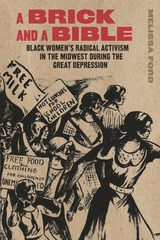 A Brick and a Bible: Black Women's Radical Activism in the Midwest during the Great Depression
Melissa Ford
Southern Illinois University Press, 2022 WINNER, 2023 Illinois State Historical Society Certificate of Excellence in “Books, Scholarly”!
Uncovering the social revolution led by Black women in the heartland
In this first study of Black radicalism in midwestern cities before the civil rights movement, Melissa Ford connects the activism of Black women who championed justice during the Great Depression to those involved in the Ferguson Uprising and the Black Lives Matter movement. A Brick and a Bible examines how African American working-class women, many of whom had just migrated to “the promised land” only to find hunger, cold, and unemployment, forged a region of revolutionary potential.
A Brick and a Bible theorizes a tradition of Midwestern Black radicalism, a praxis-based ideology informed by but divergent from American Communism. Midwestern Black radicalism that contests that interlocking systems of oppression directly relates the distinct racial, political, geographic, economic, and gendered characteristics that make up the American heartland. This volume illustrates how, at the risk of their careers, their reputations, and even their lives, African American working-class women in the Midwest used their position to shape a unique form of social activism.
Case studies of Detroit, St. Louis, Chicago, and Cleveland—hotbeds of radical activism—follow African American women across the Midwest as they participated in the Ford Hunger March, organized the Funsten Nut Pickers’ strike, led the Sopkin Dressmakers’ strike, and supported the Unemployed Councils and the Scottsboro Boys’ defense. Ford profoundly reimagines how we remember and interpret these “ordinary” women doing extraordinary things across the heartland. Once overlooked, their activism shaped a radical tradition in midwestern cities that continues to be seen in cities like Ferguson and Minneapolis today.
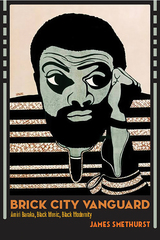 Brick City Vanguard: Amiri Baraka, Black Music, Black Modernity
James Smethurst
University of Massachusetts Press, 2020 Amiri Baraka is unquestionably the most recognized leader of the Black Arts Movement of the 1960s and 1970s, and one of the key literary and cultural figures of the postwar United States. While Baraka's political and aesthetic stances changed considerably over the course of his career, Brick City Vanguard demonstrates the continuity in his thinking about the meaning of black music in the material, psychic, and ideological development of black people. Drawing on primary texts, paratexts (including album liner notes), audio and visual recordings, and archival sources, James Smethurst takes a new look at how Baraka's writing on and performance of music envisioned the creation of an African American people or nation, as well as the growth and consolidation of a black working class within that nation, that resonates to this day. This vision also provides a way of understanding the encounter of black people with what has been called "the urban crisis" and a projection of a liberated black future beyond that crisis.
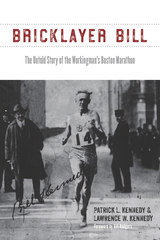 Bricklayer Bill: The Untold Story of the Workingman's Boston Marathon
Patrick L. Kennedy and Lawrence W. Kennedy
University of Massachusetts Press, 2017 Two weeks after the United States officially entered World War I, Irish American “Bricklayer Bill” Kennedy won the Boston Marathon wearing his stars-and-stripes bandana, rallying the crowd of patriotic spectators. Kennedy became an American hero and, with outrageous stories of his riding the rails and sleeping on pool tables, a racing legend whose name has since appeared in almost every book written on the Boston Marathon.
When journalist Patrick Kennedy and historian Lawrence Kennedy unearthed their uncle's unpublished memoir, they discovered a colorful character who lived a tumultuous life, beyond his multiple marathons. The bricklayer survived typhoid fever, a five-story fall, auto and train accidents, World War action, Depression-era bankruptcy, decades of back-breaking work, and his own tendency to tipple. In many ways, Bill typified the colorful, newly emerging culture and working-class ethic of competitive long-distance running before it became a professionalized sport. Bricklayer Bill takes us back to another time, when bricklayers, plumbers, and printers could take the stage as star athletes.
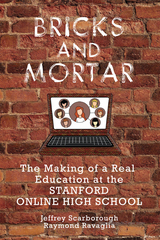 Bricks and Mortar: The Making of a Real Education at the Stanford Online High School
Jeffrey Scarborough and Raymond Ravaglia
CSLI, 2014 The rise of online learning is rapidly transforming how and what teachers teach, and even who—or what—teachers are. In the midst of these changes, the characteristics that have historically defined a high-quality education are easily lost. Not only content knowledge, but also ways of thinking and habits of mind are the hallmarks of the well-educated individual, and these latter qualities are not so easily acquired online. Or are they?
This volume shows how a group of online-learning believers built the best high school in the world without laying a single brick: the Stanford Online High School (SOHS). By chronicling SOHS’s distinctive approach to curriculum, gifted education, and school community over SOHS’s first seven years, Bricks and Mortar makes the case that the dynamic use of technology and the best traditional methodologies in education are not, in fact, mutually exclusive. Indeed, while SOHS has redefined what is possible online, a great education is ultimately the product of an interactive community of teachers and students.
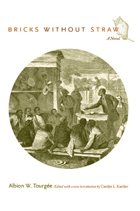 Bricks Without Straw: A Novel
Albion W. Tourgée
Duke University Press, 2009 A classic of American political fiction first published in 1880, a mere three years after Reconstruction officially ended, Bricks Without Straw offers an inside view of the struggle to create a just society in the post-slavery South. It is unique among the white-authored literary works of its time in presenting Reconstruction through the eyes of emancipated slaves. As a leading Radical Republican, the author, Albion W. Tourgée, played a key role in drafting a democratized Constitution for North Carolina after the Civil War, and he served as a state superior court judge during Reconstruction. Tourgée worked closely with African Americans and poor whites in the struggle to transform North Carolina’s racial and class politics. He saw the ravages of the Ku Klux Klan firsthand, worked to bring the perpetrators of Klan atrocities to justice, and fought against what he called the “counter-revolution” that destroyed Reconstruction. Bricks Without Straw is Tourgée’s fictionalized account of how Reconstruction was sabotaged. It is a chilling picture of violence against African Americans condoned, civil rights abrogated, constitutional amendments subverted, and electoral fraud institutionalized. Its plot revolves around a group of North Carolina freedpeople who strive to build new lives for themselves by buying land, marketing their own crops, setting up a church and school, and voting for politicians sympathetic to their interests, until Klan terrorism and the ascendancy of a white supremacist government reduce them to neo-slavery. This edition of Bricks Without Straw is enhanced by Carolyn L. Karcher’s introduction, which sets the novel in historical context and provides an overview of Albion W. Tourgée’s career, a chronology of the significant events of both the Reconstruction era and Tourgée’s life, and explanatory notes identifying actual events fictionalized in the novel.
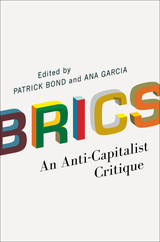 BRICS: An Anti-Capitalist Critique
Edited by Patrick Bond and Ana Garcia
Pluto Press, 2015 One of the major success stories for capitalism in recent decades has been the rise of the BRICS—Brazil, Russia, India, China, and South Africa, developing nations that have seen strong growth and have become major international economic players. But their rise brings with it a number of important questions for economics, politics, and democracy, questions taken up by a roster of stellar contributors in BRICS: An Anti-Capitalist Critique.
Offering critical analyses of the rise of the BRICS economies within the framework of a predatory, exclusionary, and unequal global capitalism, the contributors tackle questions such as: Will the BRICS force social change and innovation on the established economic and political order? Do they herald a new opening for democracy and human rights, or are they likely to be forces of political repression? What should we expect in the coming years, especially as some of these economies face significant hurdles in the wake of the global financial crisis? A contrarian, anti-capitalist exploration of some of the most important national economies in the world today, BRICS offers a much-needed counterpoint to mainstream analysis.
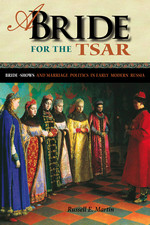 A Bride for the Tsar: Bride-Shows and Marriage Politics in Early Modern Russia
Russell E. Martin
Northern Illinois University Press, 2012
From 1505 to 1689, Russia’s tsars chose their wives through an elaborate ritual: the bride-show. The realm’s most beautiful young maidens—provided they hailed from the aristocracy—gathered in Moscow, where the tsar’s trusted boyars reviewed their medical histories, evaluated their spiritual qualities, noted their physical appearances, and confirmed their virtue. Those who passed muster were presented to the tsar, who inspected the candidates one by one—usually without speaking to any of them—and chose one to be immediately escorted to the Kremlin to prepare for her wedding and new life as the tsar’s consort.
Alongside accounts of sordid boyar plots against brides, the multiple marriages of Ivan the Terrible, and the fascinating spectacle of the bride-show ritual, A Bride for the Tsar offers an analysis of the show’s role in the complex politics of royal marriage in early modern Russia. Russell E. Martin argues that the nature of the rituals surrounding the selection of a bride for the tsar tells us much about the extent of his power, revealing it to be limited and collaborative, not autocratic. Extracting the bride-show from relative obscurity, Martin persuasively establishes it as an essential element of the tsarist political system.
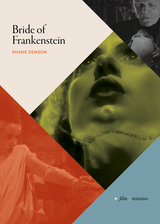 Bride of Frankenstein
Shane Denson
Lever Press, 2025 The inaugural volume in the film|minutes book series, this book offers a close, minute-by-minute analysis of director James Whale’s iconic 1935 masterpiece Bride of Frankenstein. Alternating between a variety of analytical lenses, including descriptive, historical, and philosophical, this study breaks from conventional forms of film-analytical writing and offers an experiment in defamiliarization and looking anew. In the 1930s, the film opened a space for reflection on the rapid normalization of filmic sound, which it both relies on and estranges. In the 2020s, Bride of Frankenstein brings forth questions of new technological mediums such as artificial intelligence and the transformation of human agency. Shane Denson argues that such associations should not be written off as mere anachronism, but seen, rather, as a strategy of serialization; that is, it is by means of such anachronism that a film like Bride of Frankenstein remains open to new developments and novel situations, and thus comes alive for future viewers.
Volumes in the film|minutes series cut up films into segments of exactly one minute and transform each minute into an innovative tool for thinking with the film. Each volume works rigorously with the concept of “the minute” as a non-cinematic scale/quantity, a means to zoom in on (dis)orderly fragments that do not necessarily respect the confinements of cinematic form or meaning. As a critical practice, the focus on minutes causes disruptions and displacement that create novel connections and perspectives, and uncovers hidden traces, making it possible to watch each film anew.
 The Bride of Quietness and Other Plays
Oscar Firkins
University of Minnesota Press, 1932
The Bride of Quietness and Other Plays was first published in 1932. Minnesota Archive Editions uses digital technology to make long-unavailable books once again accessible, and are published unaltered from the original University of Minnesota Press editions.Oscar Firkins’ books, posthumously published, are finding what the author, during his reclusive life, never looked for – popularity, that wide appeal which is evinced in the demand for a second edition of this book of plays and the friendly reception that has resulted in putting both his plays and the more recently published Memoirs and Letters on “bestseller” lists.John Keats, in a London twilight finds himself one wit the immortal figures of his Ode on a Grecian Urn. That timelessness of beauty to which he gave serene expression in his famous ode is the theme of The Bride of Quietness, the title play of this volume. The romantically wedded Brownings of Turnpikes in Arcady discover, under the spell of an Italian night, that they are not at all the “practical” persons they have supposed themselves to be. Charlotte, Emily, and the other enigmatic Brontës are vividly revealed in the brief, incisive lines of Empurpled Moors. A sprightly Restoration atmosphere pervades The King’s Vigil, in which Samuel Pepys and Charles II spend a night cloistered behind a massive oak door in hiding from importunate wives and mistresses.
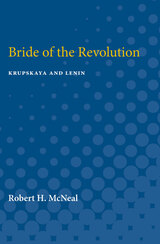 Bride of the Revolution: Krupskaya and Lenin
Robert H. McNeal
University of Michigan Press, 1972 Some four years after the wedding of Nicholas and Alexandra Romanov in the splendor of the Kremlin, two obscure political convicts—Vladimir Ulyanov (Lenin) and Nadezhda Krupskaya--were married in Siberia. Twenty years later Lenin and Krupskaya were themselves living in the Kremlin, and the royal Romanovs had been shot by Lenin's police. This book re-creates for the first time the full story of the devoted and determined woman who married the greatest among European revolutionary leaders.Krupskaya's marriage was remarkable in many ways. It began with Lenin's ambiguous proposal smuggled into her jail cell, and ended in the intrigue of succession as Lenin lay dying. From close political collaboration during the early emigrant years of the Bolshevik Party, to her role in the long-suppressed story of Lenin's affair with Inessa Armand, Krupskaya proved herself a loyal bride of the revolution. Yet Krupskaya in her own right comes alive in these pages—as a youthful Tolstoyan; as an advocate of progressive education and the liberation of women; as chief cryptologist, secretary, and paymaster for the tiny network of revolutionaries; as an ultimately tragic figure, struggling to defend her husband's legacy against the machinations of Joseph Stalin.Nadezhda Krupskaya has long been revered in Russia as the greatest woman of the Communist era, yet no Soviet writer has dared to write frankly of her fascinating and turbulent life. In this book—based on extensive research in Soviet publications as well as Tsarist and Trotskyan archive materials—the author has succeeded in unraveling many of the enigmas of Krupskaya's biography, and has provided often intimate and very human glimpses of her famous relationship with Lenin. Here, for the first time, Krupskaya at last takes her place as a great figure of the modern age.
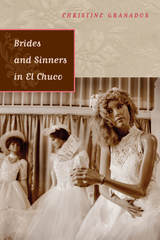 Brides and Sinners in El Chuco
Christine Granados
University of Arizona Press, 2006 Brides have their dreams, sinners their secrets, but sometimes it’s not so easy to tell them apart.
In the border town of El Paso—better known to its Mexican American residents as El Chuco—dramas unfold in humdrum households every day as working-class men come home from their jobs and as their wives and children do their best to cope with life. Christine Granados now plumbs the heart of this community in fourteen startling stories, uncovering the dreams and secrets in which ordinary people sometimes lose themselves. Many fictional accounts of barrio life play up tradition and nostalgia; Brides and Sinners in El Chuco is a trip to the darker side. Here are memories of growing up in a place where innocence is always tempered by reality—true-to-life stories, told in authentic language, of young women, from preteens to twenty-somethings, learning to negotiate their way through troubled times and troubled families. In the award-winning story “The Bride,” a young girl recalls her sister as a perennial bride on Halloween, planning for her eventual big day in a pink notebook with lists of potential husbands, only to see her dream thwarted at the junior prom. In another, we meet Bobbi, the class slut, whose D-cup chest astounds the other girls and entices everyone—even those who shouldn’t be tempted.
Granados’ tales boldly portray women’s struggle for solidarity in the face of male abuse, and as these characters come to grips with self-discovery, sibling rivalry, and dysfunctional relationships, she shows what it means for Chicanas to grow up in protective families while learning to survive in the steamy border environment. Brides and Sinners in El Chuco is an uncompromising look at life with all its hard edges—told with enough softness to make readers come back for more.
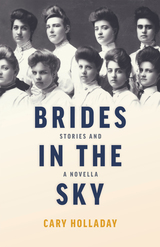 Brides in the Sky: Stories and a Novella
Cary Holladay
Ohio University Press, 2019 Each of the crystalline worlds Cary Holladay brings us in the short stories and novella that make up Brides in the Sky has sisterhood, in all its urgency and peril, at its heart. In the title story, two women in 1850s Virginia marry brothers who promptly uproot them to follow the Oregon Trail west, until an unexpected shift of allegiance separates the sisters forever. Elsewhere in the book, a young boy’s kidnapping ignites tensions in a sorority house; frontier figure Cynthia Ann Parker struggles upon her return to her birth community from the Comanche people with whom she’s lived a full life; and in a metafictional twist, a gothic tale resonates in the present. In the novella, “A Thousand Stings,” three sisters come of age in the 1960s over a long summer of small-town scandal and universal stakes. These are just some of the lives, shaped by migrations, yearning, and the long shadows of myth, that Holladay creates. She crafts them with subtle humor, a stunning sense of place, and an unerring eye for character.
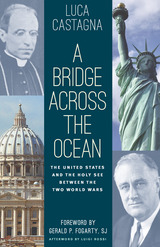 A Bridge Across the Ocean
Luca Castagna
Catholic University of America Press, 2014 A Bridge across the Ocean focuses on the relations between the United States and the Holy See from the First World War to the eve of the Second, through the combination of American, Italian, and Vatican sources. More than an overall picture of the American and Vatican foreign policy during the first half of the twentieth century, the book analyzes the U.S.-Vatican rapprochement in a multifaceted way, considering both the international and the internal sphere. A Bridge across the Ocean discusses the spread of anti-Catholicism in the United States during the first two decades of the twentieth century, and its repercussions on the American administrations' behavior during and after the Versailles Conference, together with the changes that occurred in the Holy See's attitude toward the American church and the White House after the election of Pope Pius XI. Luca Castagna explores the convergence of the New Deal legislation with the church's social thought, and demonstrates how the partial U.S.-Vatican rapprochement in 1939 resulted from Roosevelt and Pacelli's common aim to cooperate, as two of the most important and global moral powers in the struggle against Nazi-fascism.
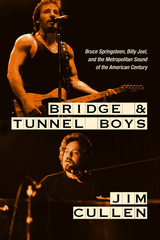 Bridge and Tunnel Boys: Bruce Springsteen, Billy Joel, and the Metropolitan Sound of the American Century
Jim Cullen
Rutgers University Press, 2024 Born four months apart, Bruce Springsteen and Billy Joel both released their debut albums in the early 1970s, quickly becoming two of the most successful rock stars of their generation. While their critical receptions have been very different, surprising parallels emerge when we look at the arcs of their careers and the musical influences that have inspired them.
Bridge and Tunnel Boys compares the life and work of Long Islander Joel and Asbury Park, New Jersey, native Springsteen, considering how each man forged a distinctive sound that derived from his unique position on the periphery of the Big Apple. Locating their music within a longer tradition of the New York metropolitan sound, dating back to the early 1900s, cultural historian Jim Cullen explores how each man drew from the city’s diverse racial and ethnic influences. His study explains how, despite frequently releasing songs that questioned the American dream, Springsteen and Joel were able to appeal to wide audiences during both the national uncertainty of the 1970s and the triumphalism of the Reagan era. By placing these two New York–area icons in a new context, Bridge and Tunnel Boys allows us to hear their most beloved songs with new appreciation.
 The Bridge: Natural Gas in a Redivided Europe
Thane Gustafson
Harvard University Press, 2019 A Marginal Revolution Best Book of the Year
Winner of the Shulman Book Prize
A noted expert on Russian energy argues that despite Europe’s geopolitical rivalries, natural gas and deals based on it unite Europe’s nations in mutual self-interest.
Three decades after the fall of the Berlin Wall and the breakup of the Soviet empire, the West faces a new era of East–West tensions. Any vision of a modern Russia integrated into the world economy and aligned in peaceful partnership with a reunited Europe has abruptly vanished.
Two opposing narratives vie to explain the strategic future of Europe, one geopolitical and one economic, and both center on the same resource: natural gas. In The Bridge, Thane Gustafson, an expert on Russian oil and gas, argues that the political rivalries that capture the lion’s share of media attention must be viewed alongside multiple business interests and differences in economic ideologies. With a dense network of pipelines linking Europe and Russia, natural gas serves as a bridge that unites the region through common interests.
Tracking the economic and political role of natural gas through several countries—Russia and Ukraine, the United Kingdom, Germany, the Netherlands, and Norway—The Bridge details both its history and its likely future. As Gustafson suggests, there are reasons for optimism, but whether the “gas bridge” can ultimately survive mounting geopolitical tensions and environmental challenges remains to be seen.
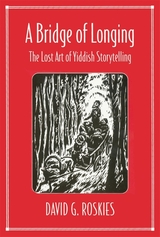 A Bridge of Longing: The Lost Art of Yiddish Storytelling
David Roskies
Harvard University Press, 1995 A Bridge of Longing is a compelling history of how Yiddish storytelling became the politics of rescue for successive generations of displaced Jewish artists, embodying their fervent hopes and greatest fears in the languages of tradition. Its protagonists are modern writers who returned to storytelling in the hope of harnessing the folk tradition, and who created copies that are better than the original.
When the cultural revolution failed--as it did for Rabbi Nahman of Bratslaw in the summer of 1806 and for I. L. Peretz in the winter of 1899; for Kiev novelist Sholem Aleichem in 1890 and kibbutz novelist Yosl Birstein in 1960; for Polish-Jewish refugees Isaac Bashevis Singer and Jechiel Isaiah Trunk when they cast ashore in America--there seemed but one route out of the spiritual and creative impasse, and that was storytelling. Yiddish storytelling was a lost art, relegated to obscurity among religious texts and synagogue sermons, then willfully abandoned by Jewish rebels and immigrants seeking more cosmopolitan forms of expression. Thus its recovery is a tale of loss and redemption.
Behind the joyous weddings that end the fairy tales and romances of Rabbi Nahman, I. L. Peretz, Der Nister, and Abraham Sutzkever; beneath the folksy facade of holiday stories by I. M. Dik and Sholem Aleichem, the Bible Poems of Itzik Manger, the demon-monologues of I. B. Singer, there lies, according to David G. Roskies, an aesthetic and moral sensibility totally at odds with the coarse humor and conventional piety of the folk. Taken together, these writers and their deceptively simple folk narratives weave a pattern of rebellion, loss, and retrieval that Roskies calls "creative betrayal"--a pattern he traces from the weddings of Yiddish fantasy to the reinvented traditions of contemporary Jews. His book itself is a delightful expression of the art of storytelling--it is a warm and vivid account.
A Bridge of Stories: Risking it All to Connect Classrooms and Culture
Kristin Pedemonti
Parkhurst Brothers, Inc., 2017 “With openhearted generosity, Kristin shares not only the story of her amazing journey but complete lesson plans and valuable tips on inter-cultural work. She deepens our understanding of the culture and legends of Belize all the while imparting courage and a can-do philosophy that could truly change the world. Read and be inspired!” —Diane Edgecomb, author of A Fire in My Heart: Kurdish Tales
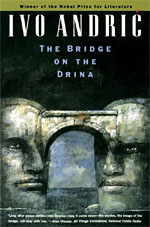 The Bridge on the Drina
Ivo Andric
University of Chicago Press, 1977 *NOBEL PRIZE WINNER*
The Bridge on the Drina is a vivid depiction of the suffering history has imposed upon the people of Bosnia from the late 16th century to the beginning of World War I. As we seek to make sense of the current nightmare in this region, this remarkable, timely book serves as a reliable guide to its people and history.
"No better introduction to the study of Balkan and Ottoman history exists, nor do I know of any work of fiction that more persuasively introduces the reader to a civilization other than our own. It is an intellectual and emotional adventure to encounter the Ottoman world through Andric's pages in its grandiose beginning and at its tottering finale. It is, in short, a marvelous work, a masterpiece, and very much sui generis. . . . Andric's sensitive portrait of social change in distant Bosnia has revelatory force."—William H. McNeill, from the introduction
"The dreadful events occurring in Sarajevo over the past several months turn my mind to a remarkable historical novel from the land we used to call Yugoslavia, Ivo Andric's The Bridge on the Drina."—John M. Mohan, Des Moines Sunday Register
Born in Bosnia, Ivo Andric (1892-1975) was a distinguished diplomat and novelist. He was awarded the Nobel Prize for Literature in 1961. His books include The Damned Yard: And Other Stories, and The Days of the Consuls.
The Bridgeport Township Site: Archaeological Investigation at 20SA620, Saginaw County, Michigan
Edited by John M. O'Shea and Michael Shott with contributions by Kathryn Egan, William Farrand, Claire McHale Milner, and Karen Mudar
University of Michigan Press, 1990 Excavations at the Bridgeport Township site (20SA620) revealed a wealth of information about the Saginaw Valley’s prehistoric inhabitants. For roughly 3,000 years, from about 1500 BC to about AD 1500, people used this site. This volume contains reports on the artifacts recovered (lithics, ceramics, and faunal and archaeobotanical remains) and on the site’s history and paleoecology.
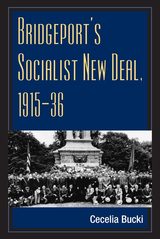 Bridgeport's Socialist New Deal, 1915-36
Cecelia Bucki
University of Illinois Press, 2001 In November 1933, the Socialist Party of Bridgeport, Connecticut put slate roofer Jasper McLevy in the mayor's seat and nearly won control of the city council. Cecelia Bucki explores how labor gained first a foothold and then a stronghold in local politics as broad debates pitted previously unengaged working-class citizens against local business leaders and traditional party elites. In the heat of the Great Depression, the skilled union craftsmen who made up the bulk of the city's Socialist Party filled a political void created by the crumbling of mainstream parties, the disintegration of traditional modes of ethnic politics, and the city's acute fiscal crisis. In time, however, legislative measures and compromise politics blunted the progressive agenda. The local party split from the Socialist Party of America and became narrowly focused and reformist while still serving as the voice of the working class. A portrait of a stunning moment in American politics, Bridgeport's Socialist New Deal, 1915-36 offers a fascinating look at the volatility of politics in the early years of the Great Depression.
 Bridger
By Bobby Bridger
University of Texas Press, 2009 Renowned for A Ballad of the West, his epic trilogy about the American West from the era of mountain man Jim Bridger to the closing of the frontier, Bobby Bridger has had a career in show business that spans the rockabilly-to-"Music City, USA" era in Nashville, the cosmic cowboy scene in Austin, the flowering of folk music, and even Broadway theater. His multifaceted talents have found expression in singing, acting, writing, painting, and sculpting. In this engrossing account of the personal and artistic journey that led him to create a new American art form, the epic ballad, Bridger touches on almost every major musical, entertainment, and cultural movement of the second half of the twentieth century, with a cast of characters that reads like a "Who's Who" of American popular culture. Bridger's story begins in a small town in northeast Louisiana, where he first experienced the twin attractions of painting and music. He recounts his early efforts to become a successful Nashville singer-songwriter and his growing awareness that the commercial music business would never support his evolving desire to become a historical balladeer. Bridger recalls how his interest in folk music and folk ballads fired his ambition to tell the story of the American West. He movingly describes how this dream eventually became A Ballad of the West, an epic trilogy about Jim Bridger, the Lakota Sioux, and Buffalo Bill that has taken form in an acclaimed cycle of songs, a one-man show, books, full-cast stage performances, and other media. Included in the book is a DVD that offers songs from A Ballad of the West and a sample from the forthcoming documentary Quest of an Epic Balladeer, based on Bobby Bridger's life and work.
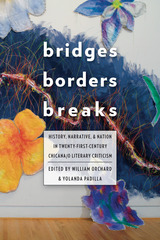 Bridges, Borders, and Breaks: History, Narrative, and Nation in Twenty-First-Century Chicana/o Literary Criticism
William Orchard
University of Pittsburgh Press, 2016
This volume reassesses the field of Chicana/o literary studies in light of the rise of Latina/o studies, the recovery of a large body of early literature by Mexican Americans, and the “transnational turn” in American studies. The chapters reveal how “Chicano” defines a literary critical sensibility as well as a political one and show how this view can yield new insights about the status of Mexican Americans, the legacies of colonialism, and the ongoing prospects for social justice.
Chicana/o literary representations emerge as significant examples of the local that interrogate globalization’s attempts to erase difference. They also highlight how Chicana/o literary studies’ interests in racial justice and the minority experience have produced important intersections with new disciplines while also retaining a distinctive character. The recalibration of Chicana/o literary studies in light of these shifts raises important methodological and disciplinary questions, which these chapters address as they introduce the new tools required for the study of Chicana/o literature at this critical juncture.
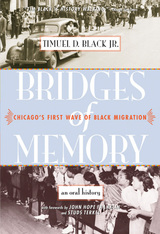 Bridges of Memory: Chicago's First Wave of Black Migration
Timuel D. Black Jr.
Northwestern University Press, 2005 Co-published with the DuSable Museum of African American History
Recipient of 2007 The Hyde Park Historical Society Paul Cornell Award A collection of interviews with African Americans who came to Chicago from the South. In their first great migration to Chicago that began during World War I, African Americans came from the South seeking a better life--and fleeing a Jim Crow system of racial prejudice, discrimination, and segregation. What they found was much less than what they'd hoped for, but it was much better than what they'd come from--and in the process they set in motion vast changes not only in Chicago but also in the whole fabric of American society. This book, the first of three volumes, revisits this momentous chapter in American history with those who lived it. Oral history of the first order, Bridges of Memory lets us hear the voices of those who left social, political, and economic oppression for political freedom and opportunity such as they'd never known--and for new forms of prejudice and segregation. These children and grandchildren of ex-slaves found work in the stockyards and steel mills of Chicago, settled and started small businesses in the "Black Belt" on the South Side, and brought forth the jazz, blues, and gospel music that the city is now known for. Historian Timuel D. Black, Jr., himself the son of first-generation migrants to Chicago, interviews a wide cross-section of African Americans whose remarks and reflections touch on issues ranging from fascism to Jim Crow segregation to the origin of the blues. Their recollections comprise a vivid record of a neighborhood, a city, a society, and a people undergoing dramatic and unprecedented changes.
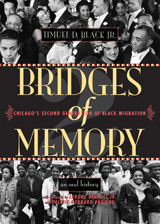 Bridges of Memory Volume 2: Chicago's Second Generation of Black Migration
Timuel Black
Northwestern University Press, 2008 Winner of 2006 Jewish Council on Urban Affairs Courageous Voices Award
In the second volume of Bridges of Memory, historian Timuel D. Black Jr. continues his conversations with African-Americans who migrated to Chicago from the South in search of economic, social, and cultural opportunities. With his trademark gift for interviewing, Black-himself the son of first-generation migrants to Chicago-guides these individual discussions with ease, resulting in first-person narratives that are informative and entertaining.
Picking up where the first book left off, volume 2 introduces the reader to more members of the first wave of migration and also members of the second generation, the children of those who came in the first wave. In telling their stories, the interviewees paint a vivid picture of the thriving and tight-knit Chicago community formerly known as the Black Belt—today's historic Bronzeville neighborhood. They bring to life the role of family, religion, business, music, and, most of all, the hopes, dreams, and perseverance that enabled a group of people to establish a successful community within a larger society that seemed determined to keep them from success. The experiences of these diverse and vivid personalities often illustrate the role that racial prejudice has played in shaping the specific arcs of their lives. But personal histories such as these are not just chronicles of frustration and despair; more important these narratives reveal an unwavering dedication to breaking the color line and a tireless pursuit of their right to the promise of America.
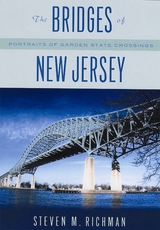 The Bridges of New Jersey: Portraits of Garden State Crossings
Steven M. Richman
Rutgers University Press, 2005 New Jersey is sandwiched between the Hudson and Delaware Rivers, with the Raritan, Passaic, and Navesink cutting swaths across it. In spite of the state's relatively small size, over six thousand bridges span its varied landscape. They traverse rivers, streams, railroads, and roadways. Several dozen bridges cut across the Delaware River alone, carrying pedestrian, vehicular, and railroad traffic. Three connect the state to Staten Island. Some are steeped in history, dating back to the colonial era and the Revolutionary war. Others are recognized worldwide for their size or significance in the annals of engineering.
In The Bridges of New Jersey, Steven M. Richman provides a rare photographic and poetic journey across sixty of the state's bridges, ranging from impressive suspension spans such as the Ben Franklin and George Washington Bridges, to the small wrought iron and stone bridges that are cherished by local citizens. The book provides a rich diversity of stories that place the bridges in the context of New Jersey history and culture. Richman also explores the contribution New Jersey bridges have made to engineering-some of the most prominent engineers of the nineteenth and twentieth centuries either lived or established businesses in the Garden State or designed its bridges.
Lavishly illustrated with over seventy photographs, this book is much more than a documentary survey. It is a visual portrait that beautifully captures the metaphoric significance and aesthetic pleasures of New Jersey's bridges, and indeed all bridges. Perhaps more than any other structure built by humans, bridges typify progress and they give us a sense of connectedness. The Bridges of New Jersey provides a compelling visual demonstration of these symbolic functions, as well as their practical purposes and engineering accomplishments.
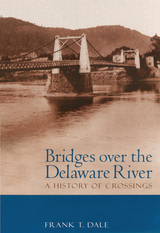 Bridges Over the Delaware River: A History of Crossings
Frank T. Dale
Rutgers University Press, 2003 When Washington made his famous crossing of the Delaware River, it is a shame he couldn't have invited local historian Frank T. Dale along for the ride. Dale could have suggested the easiest crossing points. Fortunately for contemporary readers, Dale has written a fascinating book chronicling thirty-five of the most historic bridges crossing the Delaware, some of which have served the residents of New Jersey, Pennsylvania, and New York for almost two centuries. Many of us take these bridges for granted as we speed across, impatient to reach our destination, but their histories are too interesting to ignore. Dale brings us the stories behind each bridge, covering design, engineering, ownership, finances, and politics. He chronicles the life of each, from the original construction, through modifications, and, sometimes, through the bridges' multiple destructions and reconstructions. Along the way, Dale recounts the history of the area surrounding each bridge, including the demise of ferry services, reasons why each bridge was built, politics surrounding construction, debates over public versus privately owned bridges, and stories of the floods and fires that threatened not only the bridges, but the local residents. Dozens of rare photos give readers a captivating window back into the past. These fine old structures have become integral parts of Delaware River life and have an exciting past of their own. Bridges over the Delaware River will ensure that their legacies endure.
Bridges to Cuba/Puentes a Cuba
Ruth Behar, Editor
University of Michigan Press, 2015 For fifty-five years U.S.-Cuban relations were couched in terms of the Cold War, often pitting Cubans in the diaspora against Cubans who remained in their homeland. This collection of Cuban and Cuban-American writing and art celebrates the informal networks that Cubans in both countries have maintained through artistic, academic, family, and other ties. The book brings together for the first time in English Cuban voices of the second generation, both on the island and in the diaspora. The multivocal and multigenre collection includes both scholarly and creative writing and an impressive range of visual art. Bridges to Cuba/Puentes a Cuba opens a window onto the meaning of nationality, transnationalism, and homeland in our time.
 Bridges to Fantasy: Essays from the Eaton Conference on Science Fiction and Fantasy Literature
George E Slusser
Southern Illinois University Press, 1982
Thirteen original essays written specifically for the second Eaton Conference on Science Fiction and Fantasy Literature, held February 23–24, 1980, at the University of California, Riverside.
These essays demonstrate the variety of fantasy forms and their pervasiveness throughout the ages and will stimulate further study of this complex and elusive mode. The essays—by Harold Bloom, writer and DeVane Professor of the Humanities at Yale University; Larry McCaffery, Assistant Professor of English at San Diego State University; Marta E. Sánchez, Instructor of English at the University of California, San Diego; Arlen J. Hansen, Professor of English at the University of the Pacific, Stockton; David Clayton, Instructor of Comparative Literatureat the University of California, San Diego; Robert Sale, writer and Professor of English at the University of Washington; G. Richard Thompson, Professor of English at Purdue University, West Lafayette; Robert A. Collins, Coordinator of the annual Swann Conference on the Fantastic and Instructor at Florida Atlantic University, Boca Raton; John Gerlach, Associate Professor of English at Cleveland State University; David Ketterer, writer and Professor of English at Concordia University, Montreal; George R. Guffey, Professor of English at the University of California, Los Angeles; Jack P. Rawlins, Associate Professor of English at California State University, Chico; and Gary Kern, writer and translator of early Soviet literature—examine fantasy on many levels of interest: as an element of human thought, as a constant factor in the social and intellectual environment, and as a generator of form in art and literature.
 Bridges to Science Fiction
George E Slusser
Southern Illinois University Press, 1980
Ten new critical essays written for presentation at the first Eaton Conference on Science Fiction and Fantasy Literature held 24–25February 1979,at the University of California, Riverside.
While critical discussion of science fiction has become increasingly sophisticated during the past decade, there remains a tendency among some teachers and readers to consider science fiction as an independent phenomenon that exists unconnected to the mainstream of our cultural inheritance. These essays—by Harry Levin, Irving Babbitt Professor of Comparative Literature at Harvard University; Kent T. Kraft, Assistant Professor of Comparative Literature at the University of Georgia, Athens; Stephen Potts, writer and instructor at San Diego State University; Gregory Benford, writer and Associate Professor of Physics at the University of California, Irvine; Robert Hunt, an editor at Glencoe Publishing; Eric S. Rabkin, Professor of English at the University of Michigan; Patrick Parrinder, instructor at the University of Reading, England; Thomas Keeling, Lecturer in English at the University of California, Los Angeles; Carl D. Malmgren, instructor at the University of Oregon, Eugene; and Thomas Hanzo, Professor of English and Chairman of the department at the University of California, Davis—suggest the connections that exist between science fiction and other aspects of Western cultural tradition.
Ranging in interest from the specifically philosophical to the specifically literary, the essays relate science fiction to such topics as medieval cosmological discourse, classical empirical philosophy, fairy tale, epic, and Gothic fiction. Emerging from the volume as a whole are both a coherent view of science fiction as a genre and a heightened sense of its complex relation to our cultural heritage.
 Bridges: United States Academia for First-Generation and International College Students
Shawn Higgins
Temple University Press, 2020 Bridges: United States Academia for First-Generation and International College Students introduces students to a wide range of concepts, institutions, histories, and artifacts of United States college and university life. After discussing these items in easy-to-scan, concise, nuance-free prose, this textbook then offers useful lists, templates for writing and speaking in different discourses and situations, thought-provoking questions and activities for self-study and for classroom work, and pertinent hyperlinks for further information. Bridges is designed to help first-generation, first-year, English-language learners, and/or culturally unfamiliarized students more fully and successfully explore their educational environments. By using this book, students will be better prepared for the academic and social challenges of successfully undertaking higher education in English. An enhanced edition of this textbook is available on the Press’s Manifold platform: https://temple.manifoldapp.org/projects/bridges
 Bridging a Great Divide: The Battle for the Columbia River Gorge
Kathie Durbin
Oregon State University Press, 2013 In 1986, President Ronald Reagan signed the Columbia River Gorge National Scenic Area Act, setting into motion one of the great land-use experiments of modern times. The act struck a compromise between protection for one of the West’s most stunning landscapes—the majestic Gorge carved by Ice Age floods, which today divides Washington and Oregon—and encouragement of compatible economic development in communities on both sides of the river.
In Bridging a Great Divide, award-winning environmental journalist Kathie Durbin draws on interviews, correspondence, and extensive research to tell the story of the major shifts in the Gorge since the Act’s passage. Sweeping change has altered the Gorge’s landscape: upscale tourism and outdoor recreation, gentrification, the end of logging in national forests, the closing of aluminum plants, wind farms, and a population explosion in the metropolitan area to its west. Yet, to the casual observer, the Gorge looks much the same as it did twenty-five years ago.
How can we measure the success of the Columbia River Gorge National Scenic Area Act? In this insightful and revealing history, Durbin suggests that the answer depends on who you are: a small business owner, an environmental watchdog group, a chamber of commerce. The story of the Columbia River Gorge National Scenic Area is the story of the Pacific Northwest in microcosm, as the region shifts from a natural-resource-based economy to one based on recreation, technology, and quality of life.
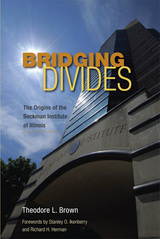 Bridging Divides: The Origins of the Beckman Institute at Illinois
Theodore L. Brown. Forewords by Stanley O. Ikenberry and Richard H. Herman.
University of Illinois Press, 2009 Bridging Divides offers a first-hand account of the origins of the Beckman Institute for Advanced Science and Technology, an interdisciplinary research institute at the University of Illinois at Urbana-Champaign devoted to leading-edge research in the physical sciences, computation, engineering, biology, behavior, cognition, and neuroscience. The book follows the progress of the Beckman Institute's creation, from the initial conceptualization of a large, multi-disciplinary institute; through proposal formulation; to the architectural design and actual construction of its state-of-the-art building, made possible by the largest gift made to any public university at the time: a $40 million contribution from Illinois alumnus and founder of Beckman Instruments, Inc., Arnold O. Beckman and his wife Mabel M. Beckman. Theodore L. Brown, the founding director of the Beckman Institute, brings an insider's personal perspective on its conception and its early operations. The evolution of a physical facility that matched a developing sense of what multidisciplinary and interdisciplinary research might be was a vital ingredient in the Institute's development. In addition, because the Institute represented a dramatic departure from traditional university organization, many challenges involving its administration and faculty had to be overcome. A celebration of the Beckman Institute's first twenty years of operation since the building's completion in 1989, Bridging Divides provides an informative look back at the history of this groundbreaking interdisciplinary research center. The book also includes forewords by Stanley O. Ikenberry, former president of the University of Illinois, and Richard H. Herman, chancellor of the University of Illinois at Urbana-Champaign.
 Bridging Enigma: Cubans on Cuba, Volume 96
Ambrosio Fornet
Duke University Press The enigma of Cuba’s resistance to the collapse of socialism around the world is equaled by the fact—surprising to some outsiders—that the Cuban cultural movement remains healthy, even with the problems brought about by the breakup of the Soviet Union. Represented in this issue of South Atlantic Quarterly by artwork, essays, short stories, and interviews, Cuban art and literature continues to produce dramatic testimony to a struggle for survival and a shared belief in the Cuban revolutionary project’s right to exist and develop on its own terms. Fostered by both caution and audacity, in a climate of both trust and tension, and in the face of sustained North American hostility through nearly four decades, Cuban artists and writers have succeeded in building bridges between domestic and foreign cultural institutions, partly offsetting the profound material deprivations under which they have labored. The work collected in this volume introduces a group of writers, artists, and filmmakers who provide a window on Cuban life, illuminating this enigmatic island and bridging the troubled waters it shares with its continental neighbor to the north. Contributors. Arturo Arango, Emilio Bejel, Rosa Ileana Boudet, Roberto Fernández Retamar, Ambrosio Fornet, Rafael Hernández, Francisco López Sacha, Humberto Manduley López, Vivian Martínez Tabares, Margarita Mateo Palmer, Miguel Mejides, Reinaldo Montero, Lisandro Otero, Graziella Pogolotti, Magda Resik, Cintio Vitier
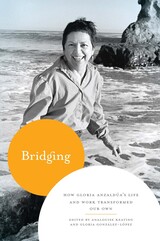 Bridging: How Gloria Anzaldúa's Life and Work Transformed Our Own
Edited by AnaLouise Keating and Gloria González-López
University of Texas Press, 2011 The inspirational writings of cultural theorist and social justice activist Gloria Anzaldúa have empowered generations of women and men throughout the world. Charting the multiplicity of Anzaldúa's impact within and beyond academic disciplines, community trenches, and international borders, Bridging presents more than thirty reflections on her work and her life, examining vibrant facets in surprising new ways and inviting readers to engage with these intimate, heartfelt contributions. Bridging is divided into five sections: The New Mestizas: "transitions and transformations"; Exposing the Wounds: "You gave me permission to fly in the dark"; Border Crossings: Inner Struggles, Outer Change; Bridging Theories: Intellectual Activism with/in Borders; and "Todas somos nos/otras": Toward a "politics of openness." Contributors, who include Norma Elia Cantú, Elisa Facio, Shelley Fisher Fishkin, Aída Hurtado, Andrea Lunsford, Denise Segura, Gloria Steinem, and Mohammad Tamdgidi, represent a broad range of generations, professions, academic disciplines, and national backgrounds. Critically engaging with Anzaldúa's theories and building on her work, they use virtual diaries, transformational theory, poetry, empirical research, autobiographical narrative, and other genres to creatively explore and boldly enact future directions for Anzaldúan studies. A book whose form and content reflect Anzaldúa's diverse audience, Bridging perpetuates Anzaldúa's spirit through groundbreaking praxis and visionary insights into culture, gender, sexuality, religion, aesthetics, and politics. This is a collection whose span is as broad and dazzling as Anzaldúa herself.
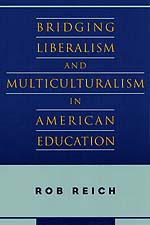 Bridging Liberalism and Multiculturalism in American Education
Rob Reich
University of Chicago Press, 2002 What should the civic purposes of education be in a liberal and diverse society? Is there a tension between cultivating citizenship and respecting social diversity? What are the boundaries of parental and state authority over education?
Linking political theory with educational history and policy, Rob Reich offers provocative new answers to these questions. He develops a liberal theory of multicultural education in which the leading goal is the cultivation of individual autonomy in children. Reich draws out the policy implications of his theory through one of the first sustained considerations of homeschooling in American education. He also evaluates three of the most prominent trends in contemporary school reform—vouchers, charter schools, and the small school movement—and provides pedagogical recommendations that sharply challenge the reigning wisdom of many multicultural educators.
Written in clear and accessible language, this book will be of interest to political theorists, philosophers, educators, educational policymakers, and teachers.
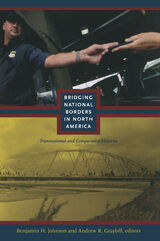 Bridging National Borders in North America: Transnational and Comparative Histories
Benjamin H. Johnson and Andrew R. Graybill, eds.
Duke University Press, 2010 Despite a shared interest in using borders to explore the paradoxes of state-making and national histories, historians of the U.S.-Canada border region and those focused on the U.S.-Mexico borderlands have generally worked in isolation from one another. A timely and important addition to borderlands history, Bridging National Borders in North America initiates a conversation between scholars of the continent’s northern and southern borderlands. The historians in this collection examine borderlands events and phenomena from the mid-nineteenth century through the mid-twentieth. Some consider the U.S.-Canada border, others concentrate on the U.S.-Mexico border, and still others take both regions into account. The contributors engage topics such as how mixed-race groups living on the peripheries of national societies dealt with the creation of borders in the nineteenth century, how medical inspections and public-health knowledge came to be used to differentiate among bodies, and how practices designed to channel livestock and prevent cattle smuggling became the model for regulating the movement of narcotics and undocumented people. They explore the ways that U.S. immigration authorities mediated between the desires for unimpeded boundary-crossings for day laborers, tourists, casual visitors, and businessmen, and the restrictions imposed by measures such as the Chinese Exclusion Act of 1882 and the 1924 Immigration Act. Turning to the realm of culture, they analyze the history of tourist travel to Mexico from the United States and depictions of the borderlands in early-twentieth-century Hollywood movies. The concluding essay suggests that historians have obscured non-national forms of territoriality and community that preceded the creation of national borders and sometimes persisted afterwards. This collection signals new directions for continental dialogue about issues such as state-building, national expansion, territoriality, and migration. Contributors: Dominique Brégent-Heald, Catherine Cocks, Andrea Geiger, Miguel Ángel González Quiroga, Andrew R. Graybill, Michel Hogue, Benjamin H. Johnson, S. Deborah Kang, Carolyn Podruchny, Bethel Saler, Jennifer Seltz, Rachel St. John, Lissa Wadewitz Published in cooperation with the William P. Clements Center for Southwest Studies, Southern Methodist University.
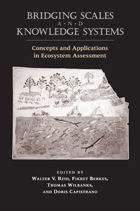 Bridging Scales and Knowledge Systems: Concepts and Applications in Ecosystem Assessment
Edited by Walter V. Reid, Fikret Berkes, Thomas J. Wilbanks, and Doris Capistrano
Island Press, 2006 Bridging the gap between local knowledge and western science is essential to understanding the world's ecosystems and the ways in which humans interact with and shape those ecosystems. This book brings together a group of world-class scientists in an unprecedented effort to build a formal framework for linking local and indigenous knowledge with the global scientific enterprise.
Contributors explore the challenges, costs, and benefits of bridging scales and knowledge systems in assessment processes and in resource management. Case studies look at a variety of efforts to bridge scales, providing important lessons concerning what has worked, what has not, and the costs and benefits associated with those efforts. Drawing on the groundbreaking work of the Millennium Eco-system Assessment, Bridging Scales and Knowledge Systems will be indispensable for future efforts to conduct ecosystem assessments around the world.
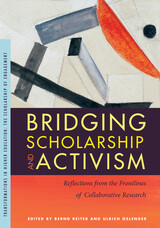 Bridging Scholarship and Activism: Reflections from the Frontlines of Collaborative Research
Bernd Reiter
Michigan State University Press, 2015 This timely book brings together activist scholars from a number of disciplines (political science, geography, sociology, anthropology, and communications) to provide new insights into a growing trend in publicly engaged research and scholarship. Bridging Scholarship and Activism creatively redefines what constitutes activism without limiting it to a narrow range of practices. Acknowledging that the current conjuncture of neoliberal globalization has created constraints on as well as possibilities for activist scholarly engagement, the book argues that racism and its intersections with gender and class oppression are salient forces to be interrogated and confronted in the predicaments and struggles activist scholarship targets. The book’s ultimate goal is to create a decolonized and democratized forum in which activist scholars from the Global South converse and cross-fertilize ideas and projects with their counterparts from the United States and other North Atlantic metropolitan-based academy. The coeditors and contributors attempt to decenter hegemonic knowledge and to create some of the necessary (if not sufficient) conditions for a more pluriversal (rather than orthodox “universal”) context for producing enabling knowledge, without the naiveté and romanticism that has characterized earlier projects in critical and radical social science. CONTENTS: Introduction, Ulrich Oslender and Bernd Reiter Part One. The Promises and Pitfalls of Collaborative Research - Of Academic Embeddedness: Communities of Choice and How to Make Sense of Activism and Research Abroad, Bernd Reiter
- New Shapes of Revolution, Gustavo Esteva
- The Accidental Activist Scholar: A Memoir on Reactive Boundary and Identity Work for Social Change within the Academy, Rob Benford
- Leaving the Field: How to Write about Disappointment and Frustration in Collaborative Research, Ulrich Oslender
- Invisible Heroes, Eshe Lewis
Part Two. Negotiating Racialized and Gendered Positionalities - El Muntuen America, Manuel Zapata Olivella
- Activism as History Making: The Collective and the Personal in Collaborative Research with the Process of Black Communities in Colombia, Arturo Escobar
- Out of Bounds: Negotiating Researcher Positionality in Brazil, Elizabeth Hordge-Freeman
- Between Soapboxes and Shadows: Activism, Theory, and the Politics of Life and Death in Salvador, Bahia, Brazil, Christen A. Smith
- State Violence and the Ethnographic Encounter: Feminist Research and Racial Embodiment, Keisha-Khan Y. Perry
- The Challenges Resulting from Combining Scientific Production and Social-Political Activism in the Brazilian Academy, Fernando Conceição
- The Challenge of Doing Applied/Activist Anti-Racist Anthropology in Revolutionary Cuba, Gayle L. McGarrity
- Conclusion, Ulrich Oslender and Bernd Reiter
- About the Authors
 Bridging Sonic Borders: Popular Music in Contemporary Dominican/Dominicanyork Literature
Sharina Maíllo-Pozo
University of Texas Press, 2025 How music depicted in literature shapes Dominican and Dominican New Yorkers’ identities and links the homeland to the diaspora. Music has played a large role in recent Dominican literature, whether of the island or the diaspora. Bridging Sonic Borders explores this sonic connection linking the homeland and far-flung locales—especially New York, the center of Dominican cultural production in the United States. Sharina Maíllo-Pozo argues that literary representations of popular music delineate a shared aesthetic territory for US and Caribbean Dominicans, fostering an inclusive and transnational Dominicanidad. Examining works written in Spanish, English, and Dominicanish, Maíllo-Pozo focuses on Dominican/Dominicanyork writings that have nurtured a borderless aesthetics through their shared investment in hip-hop, jazz, blues, pop, rock, and merengue. For Dominican writers, popular music has become a way of exploring memory and nostalgia and a means of centering people rejected from hegemonic identity formation—the working class, those of African descent, rural and queer people. For example, many works focused on the life of rocker Luis “Terror” Días have emphasized the in-between identity of being both Dominican and a New Yorker. Collectively, these writings have created a space in which boundaries of nation and diaspora are revealed for their fundamental porosity.
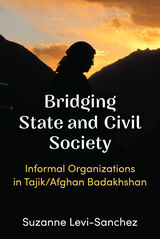 Bridging State and Civil Society: Informal Organizations in Tajik/Afghan Badakhshan
Suzanne Levi-Sanchez
University of Michigan Press, 2021 Bridging State and Civil Society provides an in-depth study of parts of Central Asia and Afghanistan that remain marginalized from the larger region. As such, the people have developed distinct ways of governing and surviving, sometimes in spite of the state and in part because of informal organizations. Suzanne Levi-Sanchez provides eight case studies, each an independent look at a particular informal organization, but each also part of a larger picture that helps the reader understand the importance and key role that informal organizations play for civil society and the state. Each case explores how informal organizations operate and investigates their structures and interactions with official state institutions, civil society, familial networks, and development organizations. As such, each chapter explores the concepts through a different lens while asking a deceptively simple question: What is the relationship between informal organizations and the state?
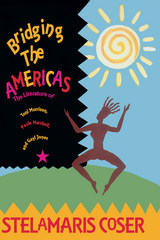 Bridging The Americas: The Literature of Paule Marshall, Toni Morrison, and Gayl Jones
Stelamaris Coser
Temple University Press, 1994 A literary study of three important black women writers, this book examines the "inter-American" characteristics in the work of Marshall, Morrison, and Jones, including detailed discussions of Morrison's Song of Solomon and Tar Baby, Jones's Corregidora and Song of Anninho, and Marshall's The Chose Place, The Timeless People. Coser defines the inter-American characteristics in these authors' novels as a connection based on a common African heritage and a shared legacy of colonialism and racism. These three authors redefine the boundaries between the Americas, bridging the "extended Caribbean" that stretches from the U.S. Atlantic coast to Brazil. Their work reinterprets ethnic and sexual identity. Issues of race, class, and nationality overlap. History and identity are reinvented. To explore the collective forms of resistance and cultural processes in Brazil, the Caribbean, and the United States, Coser also makes provocative connections between the visibility of black women writers and the popularity of male Latin American novelists like Carlos Fuentes and Gabriel Garcia Marquéz.
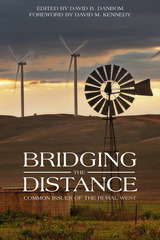 Bridging the Distance: Common Issues of the Rural West
David B. Danbom
University of Utah Press, 2015 Bridging the Distance examines a number of the problems and prospects of the rural West that have largely been neglected by scholars. The issues are considered in four sections—Defining the Rural West, Community, Economy, and Land Use—each with an introduction by editor David Danbom. The essays highlight factors that set the region apart from the rest of the country and provide varied perspectives on challenges faced by those living in often isolated areas. Contributors cover matters such as a hazing incident that divided a small Colorado town and the effects of media coverage; challenges in areas of Montana and Wyoming where the ideas of new exurbanites regarding natural resources differ from those of long-time residents; conflict between surface water and ground water users in Colorado, Kansas, and Nebraska; and the shortcomings of health care among Latino immigrants in rural California. Essays on rural economy suggest how states can better use fiscal policies to advance long-term economic health and how resources can be exploited in ways that are both environmentally and economically sustainable. On the question of land use, one essay shares the viewpoint of a ranching family in Nevada that has long struggled with the government over grazing cattle on federal lands. Another examines the case of the Goshute Indians of Skull Valley, whose efforts to use their reservation for nuclear waste storage roused the ire of the state of Utah.
The essays in Bridging the Distance are fresh, informative, and insightful examinations of the complex problems facing the rural West. This is a book that will spur both conversations and the search for solutions.
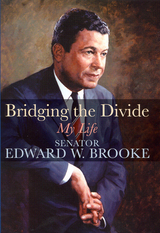 Bridging the Divide: My Life
Edward W. Brooke
Rutgers University Press, 2006 President Lyndon Johnson never understood it. Neither did President Richard Nixon. How could a black man, a Republican no less, be elected to the United States Senate from liberal, Democratic Massachusetts-a state with an African American population of only 2 percent? The mystery of Senator Edward Brooke's meteoric rise from Boston lawyer to Massachusetts attorney general to the first popularly elected African American U.S. senator with some of the highest favorable ratings of any Massachusetts politician confounded many of the best political minds of the day. After winning a name for himself as the first black man to be elected a state's attorney general, as a crime fighter, and as the organizer of the Boston Strangler Task Force, this articulate and charismatic man burst on the national scene in 1966 when he ran for the Senate. In two terms in the Senate during some of the most racially tormented years of the twentieth century, Brooke, through tact, personality, charm, and determination, became a highly regarded member of "the most exclusive club in the world." The only African American senator ever to be elected to a second term, Brooke established a reputation for independent thinking and challenged the powerbrokers and presidents of the day in defense of the poor and disenfranchised. In this autobiography, Brooke details the challenges that confronted African American men of his generation and reveals his desire to be measured not as a black man in a white society but as an individual in a multiracial society. Chided by some in the white community as being "too black to be white" and in the black community as "too white to be black," Brooke sought only to represent the people of Massachusetts and the national interest. His story encompasses the turbulent post-World War II years, from the gains of the civil rights movement, through the riotous 1960s, to the dark days of Watergate, with stories of his relationships with the Kennedys, Martin Luther King Jr., Lyndon Johnson, Richard Nixon, Henry Kissinger, Colin Powell, and future senator Hillary Clinton. Brooke also speaks candidly of his personal struggles, including his bitter divorce from his first wife and, most recently, his fight against cancer. A dramatic, compelling, and inspirational account, Brooke's life story demonstrates the triumph of the human spirit, offering lessons about politics, life, reconciliation, and love.
Bridging the Gap: Perspectives on Nationally Competitive Scholarships
Suzanne McCray
University of Arkansas Press, 2019 Thousands of college students across the country apply each year for nationally and internationally competitive scholarships and grants. Different awards target different interests, career goals, and student qualifications. Advising students on how to choose the right award that will help launch them on their career path requires a nuanced understanding of scholarship opportunities. Bridging the Gap: Perspectives on Nationally Competitive Scholarships provides key information from scholarship foundations and seasoned advice from campus advisors critically important for the faculty and staff who support students applying for these awards. This book will be a great resource for anyone advising students.
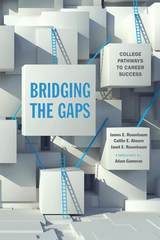 Bridging the Gaps: College Pathways to Career Success
James E. Rosenbaum
Russell Sage Foundation, 2017 College-for-all has become the new American dream. Most high school students today express a desire to attend college, and 90% of on-time high school graduates enroll in higher education in the eight years following high school. Yet, degree completion rates remain low for non-traditional students—students who are older, low-income, or have poor academic achievement—even at community colleges that endeavor to serve them. What can colleges do to reduce dropouts? In Bridging the Gaps, education scholars James Rosenbaum, Caitlin Ahearn, and Janet Rosenbaum argue that when institutions focus only on bachelor’s degrees and traditional college procedures, they ignore other pathways to educational and career success. Using multiple longitudinal studies, the authors evaluate the shortcomings and successes of community colleges and investigate how these institutions can promote alternatives to BAs and traditional college procedures to increase graduation rates and improve job payoffs.
The authors find that sub-baccalaureate credentials—associate degrees and college certificates—can improve employment outcomes. Young adults who complete these credentials have higher employment rates, earnings, autonomy, career opportunities, and job satisfaction than those who enroll but do not complete credentials. Sub-BA credentials can be completed at community college in less time than bachelor’s degrees, making them an affordable option for many low-income students.
Bridging the Gaps shows that when community colleges overemphasize bachelor’s degrees, they tend to funnel resources into remedial programs, and try to get low-performing students on track for a BA. Yet, remedial programs have inconsistent success rates and can create unrealistic expectations, leading struggling students to drop out before completing any degree. The authors show that colleges can devise procedures that reduce remedial placements and help students discover unseen abilities, attain valued credentials, get good jobs, and progress on degree ladders to higher credentials.
To turn college-for-all into a reality, community college students must be aware of their multiple credential and career options. Bridging the Gaps shows how colleges can create new pathways for non-traditional students to achieve success in their schooling and careers.
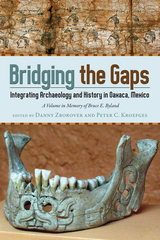 Bridging the Gaps: Integrating Archaeology and History in Oaxaca, Mexico; A Volume in Memory of Bruce E. Byland
Danny Zborover
University Press of Colorado, 2015 Bridging the Gaps: Integrating Archaeology and History in Oaxaca, Mexico does just that: it bridges the gap between archaeology and history of the Precolumbian, Colonial, and Republican eras of the state of Oaxaca, Mexico, a cultural area encompassing several of the longest-enduring literate societies in the world.
Fourteen case studies from an interdisciplinary group of archaeologists, anthropologists, ethnohistorians, and art historians consciously compare and contrast changes and continuities in material culture before and after the Spanish conquest, in Prehispanic and Colonial documents, and in oral traditions rooted in the present but reflecting upon the deep past. Contributors consider both indigenous and European perspectives while exposing and addressing the difficulties that arise from the application of this conjunctive approach.
Inspired by the late Dr. Bruce E. Byland’s work in the Mixteca, which exemplified the union of archaeological and historical evidence and inspired new generations of scholars, Bridging the Gaps promotes the practice of integrative studies to explore the complex intersections between social organization and political alliances, religion and sacred landscape, ethnic identity and mobility, colonialism and resistance, and territoriality and economic resources.
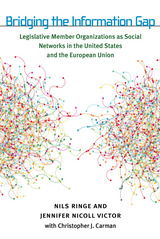 Bridging the Information Gap: Legislative Member Organizations as Social Networks in the United States and the European Union
Nils Ringe and Jennifer Nicoll Victor with Christopher J. Carman
University of Michigan Press, 2013 Legislative member organizations (LMOs)—such as caucuses in the U.S. Congress and intergroups in the European Parliament—exist in lawmaking bodies around the world. Unlike parties and committees, LMOs play no obvious, predefined role in the legislative process. They provide legislators with opportunities to establish social networks with colleagues who share common interests. In turn, such networks offer valuable opportunities for the efficient exchange of policy-relevant—and sometimes otherwise unattainable—information between legislative offices. Building on classic insights from the study of social networks, the authors provide a comparative overview of LMOs across advanced, liberal democracies. In two nuanced case studies of LMOs in the European Parliament and the U.S. Congress, the authors rely on a mix of social network analysis, sophisticated statistical methods, and careful qualitative analysis of a large number of in-depth interviews.
 Bridging the Interpretive Abyss: Reading the New Testament after the Cultural Studies Turn
Luis Menéndez-Antuña
SBL Press, 2025 As readers and interpreters, how might our understanding of the New Testament change if, unlike historicism with its colonizing agenda and its focus on ancient contexts, we took contemporary global crises, including mass incarceration, a pervasive culture of torture, the HIV pandemic, and the legacies of enslavement, as our starting point for reading biblical texts? Luis Menéndez-Antuña demonstrates how a cultural studies approach that centers twenty-first-century queer existence and experiences of suffering illuminates rather than obscures ancient New Testament contexts. Each chapter weaves together a biblical text, different works of art, and a political crisis. This hermeneutical approach bridges the abyss between the past and present, the Global North and the Global South, biblical scholarship, humanities, and social sciences. Readers coming to the New Testament text with political and ethical concerns will find new emancipatory strategies, making this volume essential reading for scholars and students.
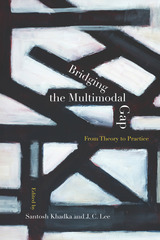 Bridging the Multimodal Gap: From Theory to Practice
Santosh Khadka
Utah State University Press, 2018 Bridging the Multimodal Gap addresses multimodality scholarship and its use in the composition classroom. Despite scholars’ interest in their students’ multiple literacies, multimodal composition is far from the norm in most writing classes. Essays explore how multimodality can be implemented in courses and narrow the gap between those who regularly engage in this instruction and those who are still considering its scholarly and pedagogical value.
After an introductory section reviewing the theory literature, chapters present research on implementing multimodal composition in diverse contexts. Contributors address starter subjects like using comics, blogs, or multimodal journals; more ambitious topics such as multimodal assignments in online instruction or digital story telling; and complex issues like assessment, transfer, and rhetorical awareness.
Bridging the Multimodal Gap translates theory into practice and will encourage teachers, including WPAs, TAs, and contingent faculty, to experiment with multiple modes of communication in their projects.
Contributors: Sara P. Alvarez, Steven Alvarez, Michael Baumann, Joel Bloch, Aaron Block, Jessie C. Borgman, Andrew Bourelle, Tiffany Bourelle, Kara Mae Brown, Jennifer J. Buckner, Angela Clark-Oates, Michelle Day, Susan DeRosa, Dànielle Nicole DeVoss, Stephen Ferruci, Layne M. P. Gordon, Bruce Horner, Matthew Irwin, Elizabeth Kleinfeld, Ashanka Kumari, Laura Sceniak Matravers, Jessica S. B. Newman, Mark Pedretti, Adam Perzynski, Breanne Potter, Caitlin E. Ray, Areti Sakellaris, Khirsten L. Scott, Rebecca Thorndike-Breeze, Jon Udelson, Shane A. Wood, Rick Wysocki, Kathleen Blake Yancey
 Bridging the Sacred and the Secular: Selected Writings of John Courtney Murray
J. Leon Hooper, SJ, Editor
Georgetown University Press, 1994 John Courtney Murray, SJ (1904-1967), is most renowned for his ethical writings, which distinguish between the secular and the sacred, and for his defense of civil religious freedom based on natural law philosophy. His later theological writings, however, in which he sought to reintegrate the temporal and the spiritual, civil society and the church, philosophy and theology, have been largely ignored. In this new collection of essays—previously scattered among various periodicals over the course of thirty years—J. Leon Hooper, S.J., presents a selection of Murray's theological writings that not only outlines and highlights the integrity of Murray's moves towards a public theological discourse but also contributes to the ongoing post-conciliar task of integrating the secular and the sacred, thereby invigorating American public conversation today. In his editorial introductions, Hooper furthers Murray scholarship by identifying two distinct links between Murray's well known non-theological writings and the explicitly theological work that also spans his public life. Common to both areas are Murray's deepening appreciation of the historicity of all human knowing and the cognitional operations that the human person brings to both sacred and profane living. By making available Murray's explicitly theological and Christian humanism writings, this collection further enriches American ethical, theological and philosophical debate.
Bridging Three Worlds: Hungarian-Jewish Americans, 1848-1914
Robert Perlman
University of Massachusetts Press, 1991 We are currently updating our website and have not yet posted complete information for this title. Many of our books are in the Google preview program, which allows readers to view up to 20% of the book. If this title is active in the program, you will find the Google Preview button in the sidebar below.
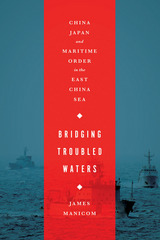 Bridging Troubled Waters: China, Japan, and Maritime Order in the East China Sea
James Manicom
Georgetown University Press, 2014 Sino-Japanese relations have been repeatedly strained by the territorial dispute over a group of small islands, known as the Senkaku islands in Japan and the Diaoyu islands in China. The rich fishing grounds, key shipping lanes, and perhaps especially, potentially rich oil deposits around the islands exacerbate this dispute in a confluence of resource pressures, growing nationalism, and rising military spending in the region. Bridging Troubled Waters reminds us that the tensions over the Senkaku/Diaoyu islands are only a part of a long history of both conflict and cooperation in maritime relations between Japan and China. James Manicom examines the cooperative history between China and Japan at sea and explains the conditions under which two rivals can manage disputes over issues such as territory, often correlated with war. China and Japan appear incapable of putting history behind them, are poised on the brink of a strategic rivalry, and seem at risk of falling into an unintentional war over disputed maritime claims. Bridging Troubled Waters challenges this view by offering a case-by-case analysis of how China and Japan have managed maritime tensions since the dispute erupted in 1970. The author advances an approach that offers a trade-off between the most important stakes in the disputed maritime area with a view to establishing a stable maritime order in the East China Sea. The book will be of interest to policymakers, academics, and regional specialists in Asia, security studies, and international conflict and cooperation.
 Bridging Two Eras: The Autobiography of Emily Newell Blair, 1877-1951
Emily Newell Blair, Edited & Intro by Virginia Jeans Laas
University of Missouri Press, 1999 First written in 1937 and never before published, Bridging Two Eras is the fascinating autobiography of Emily Newell Blair, a remarkable woman who successfully reconciled a productive public life with the traditional values of a housewife and mother. Because Blair's life essentially spanned two eras, from the end of the nineteenth century through the middle of the twentieth, she thought of herself as a bridge builder. A dedicated feminist, she wanted her autobiography to help women understand what life was like during that transition time. She had moved from being a conventional, middle-class, midwestern wife and mother to becoming an acclaimed author, a nationally known feminist, and vice chairman of the Democratic National Committee only two years after women gained the right to vote. She felt that her story could encourage women to take their rightful places in public life. Bridging Two Eras is divided into two parts. Book I is a charming evocation of life in southwest Missouri in the closing decades of the nineteenth century. It offers great insight into family relationships, class structure, and social attitudes typical of much of small-town America. Book II addresses Blair's public career and follows her progress as professional writer, suffrage activist, and partisan politician. Included are acute judgments of leading political figures, fascinating vignettes of the suffrage movement, an insider's view of the workings of the national Democratic Party in the 1920s and 1930s, and a valuable outlook on Missouri politics during the first third of the twentieth century. Perceptive and introspective, Blair captivates her readers as she traces her own evolution. With candor, she explains her conflicts between family and career, acknowledging the difficulties and tensions she faced in pursuing a public life. Delightfully written, Bridging Two Eras provides valuable insight into all the possibilities, as well as the limitations, life then held for an American woman.
|
|

